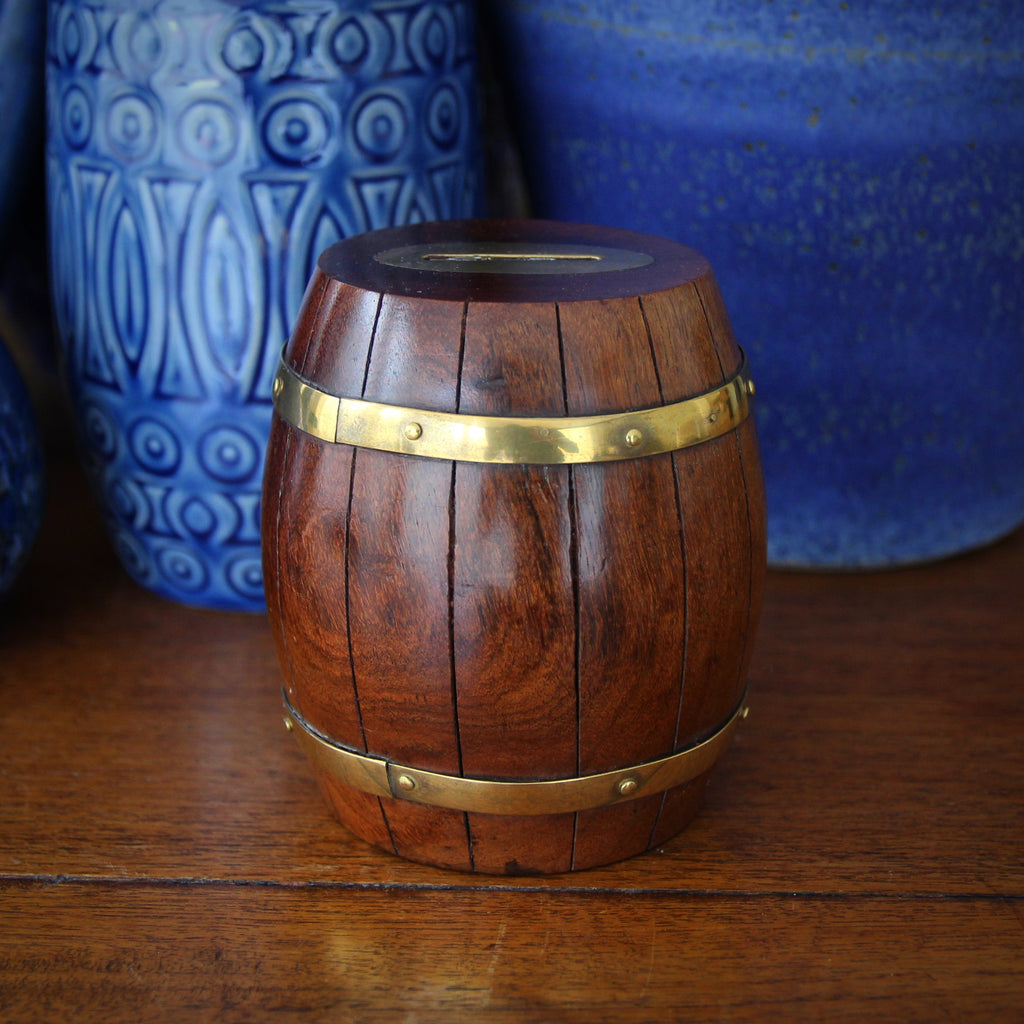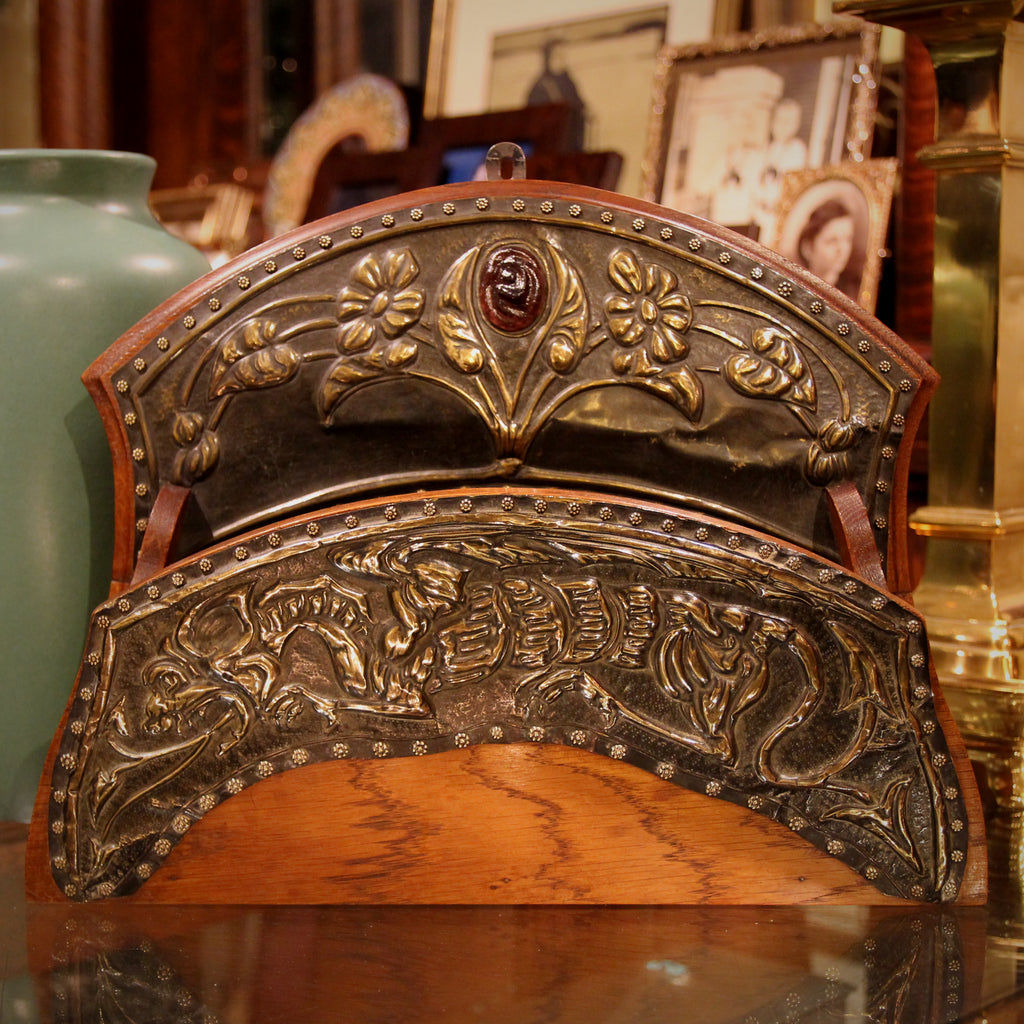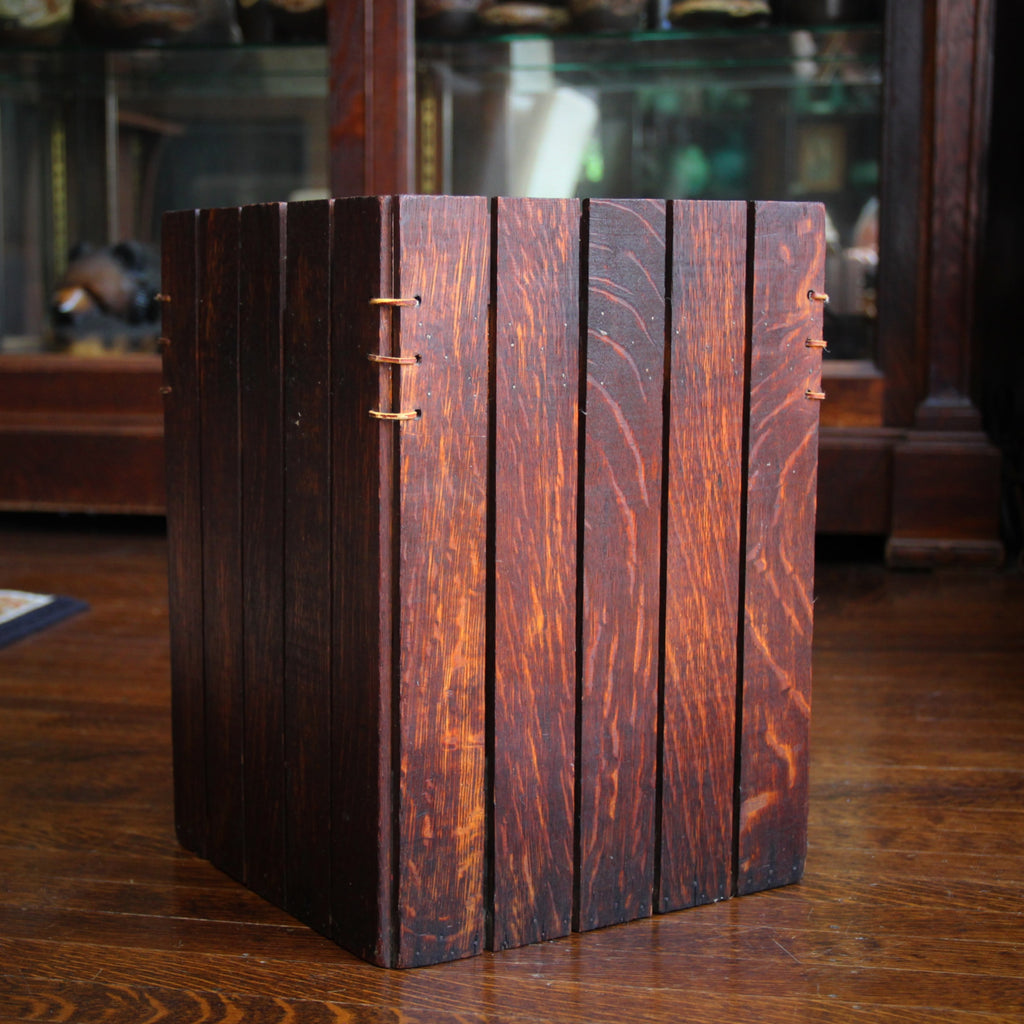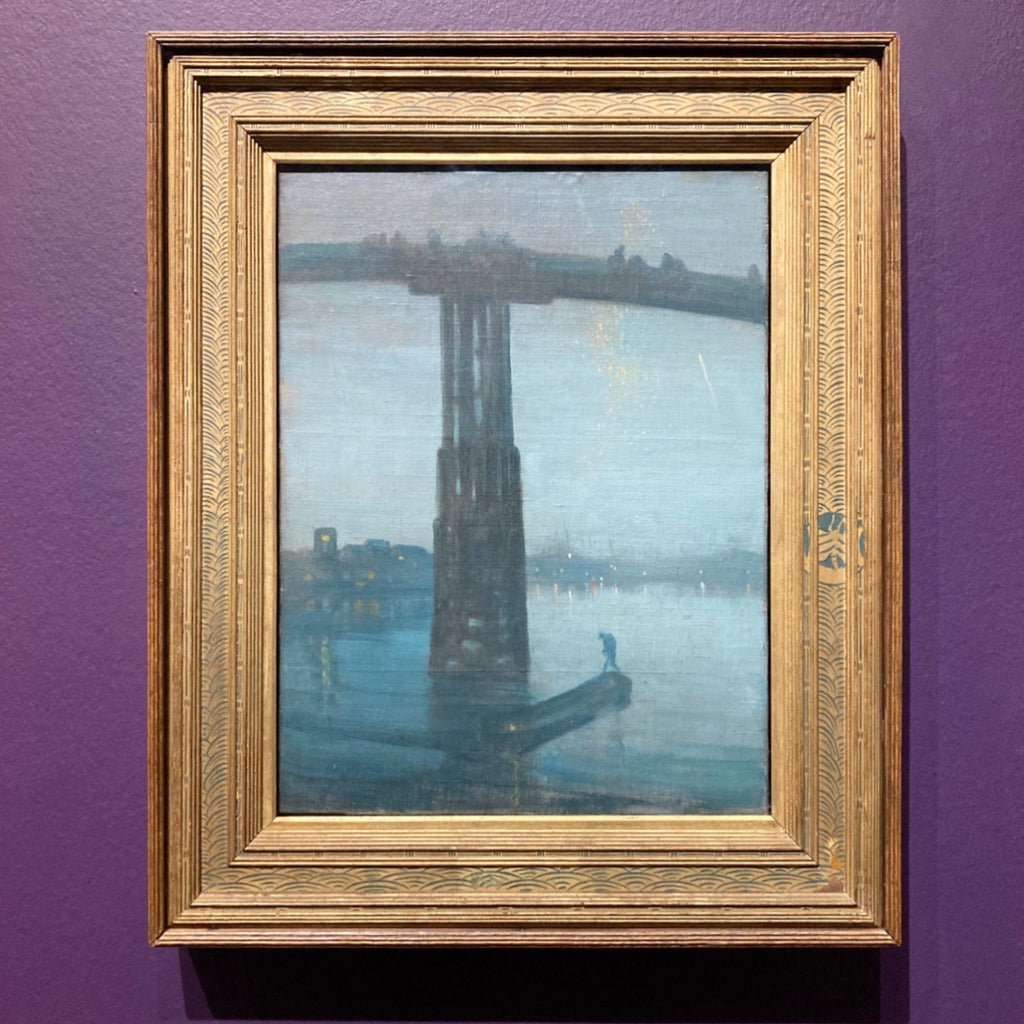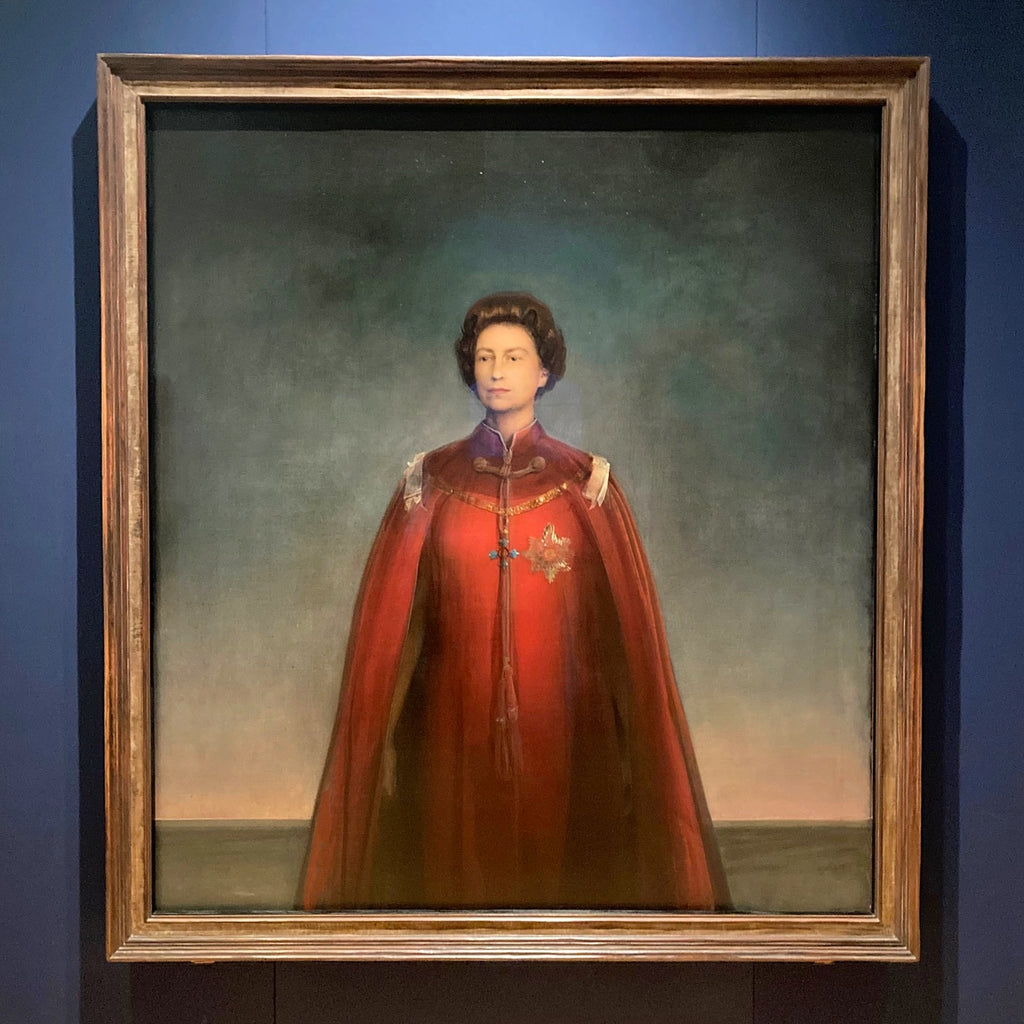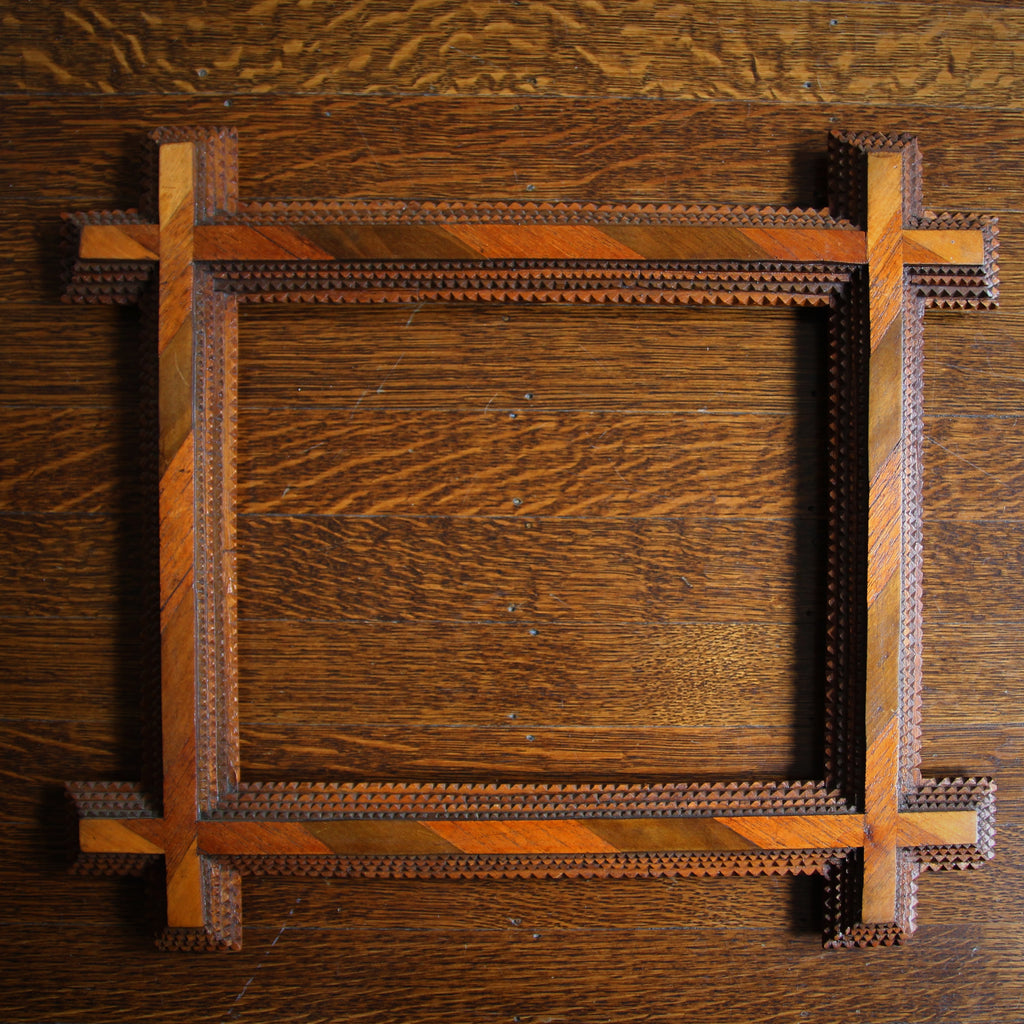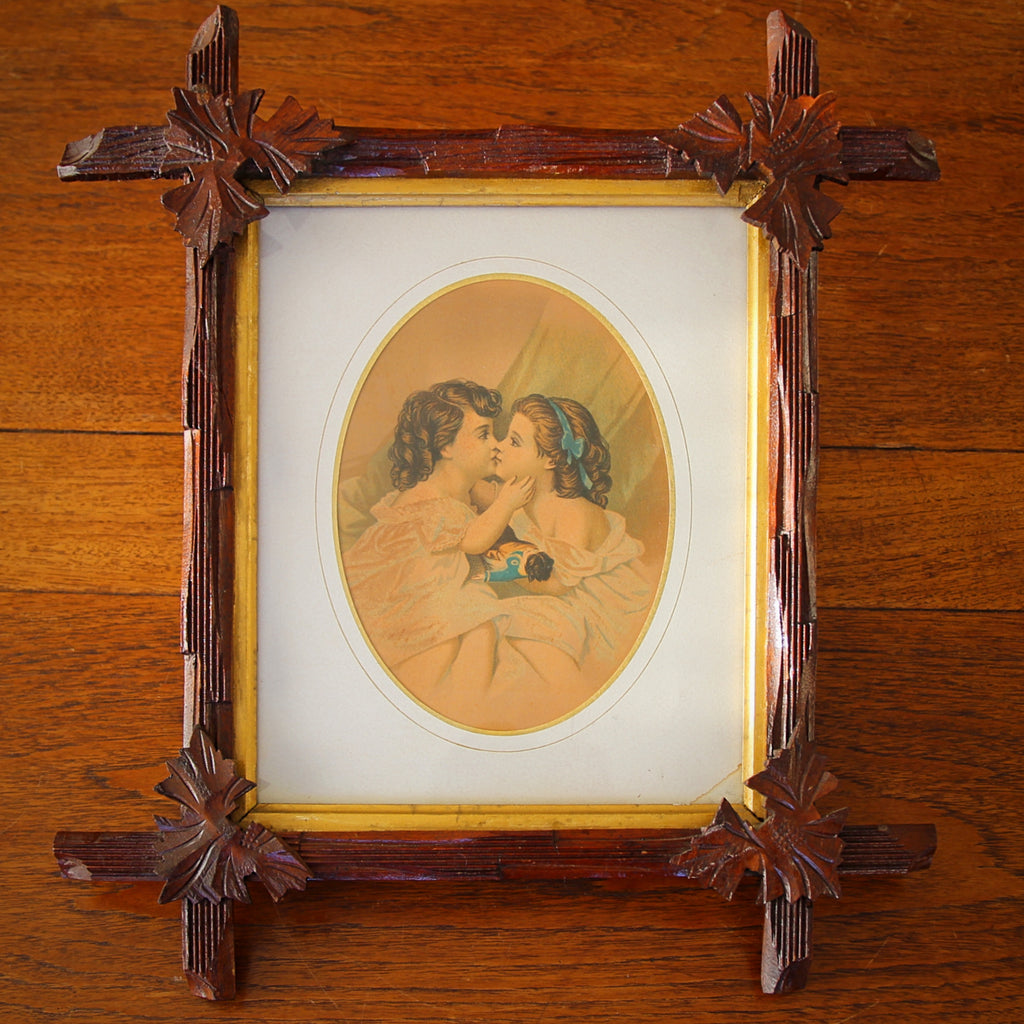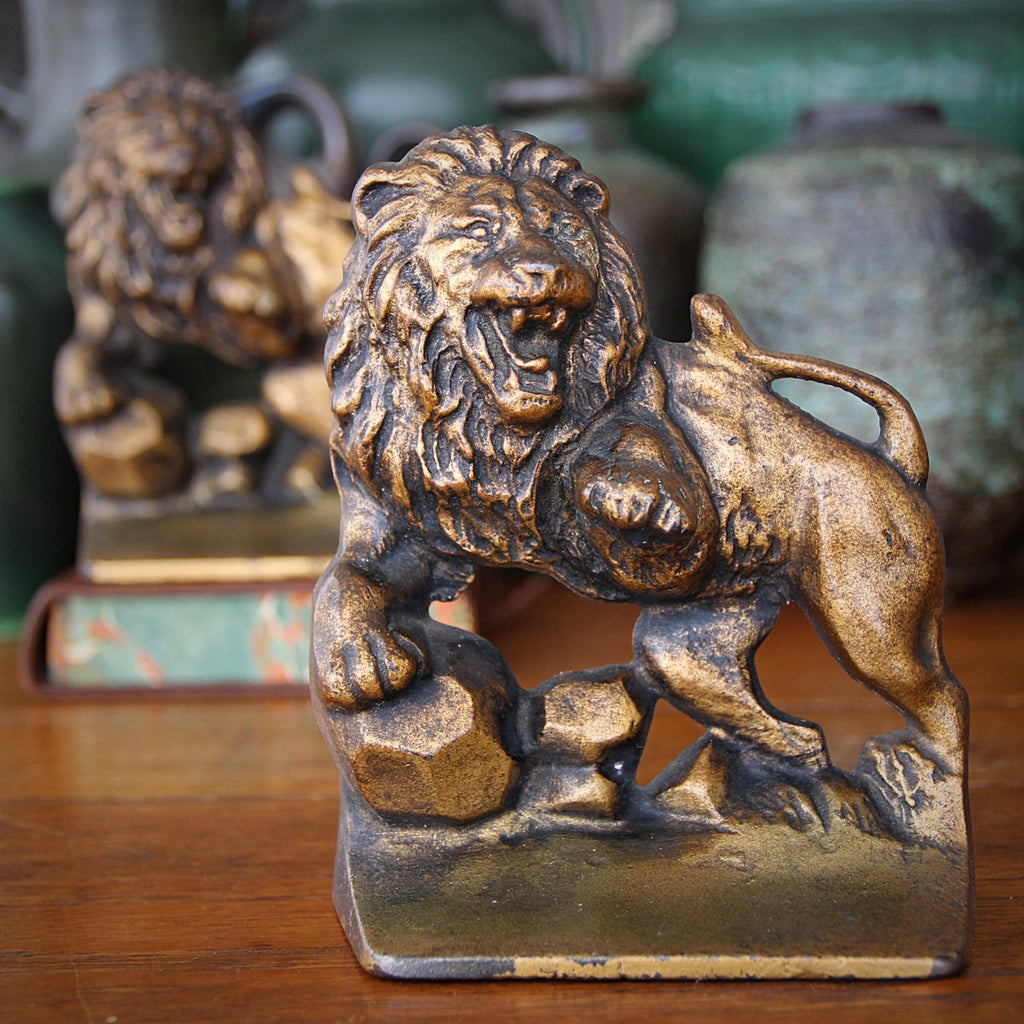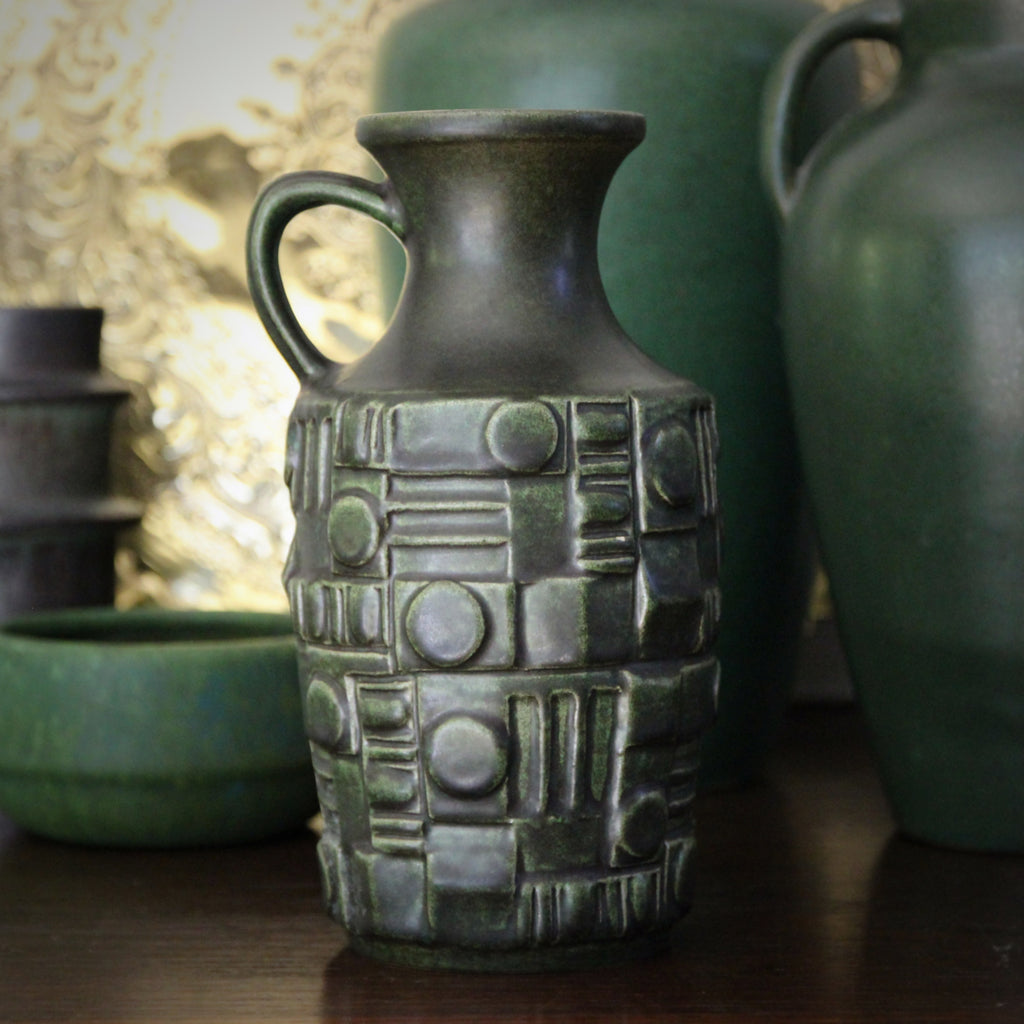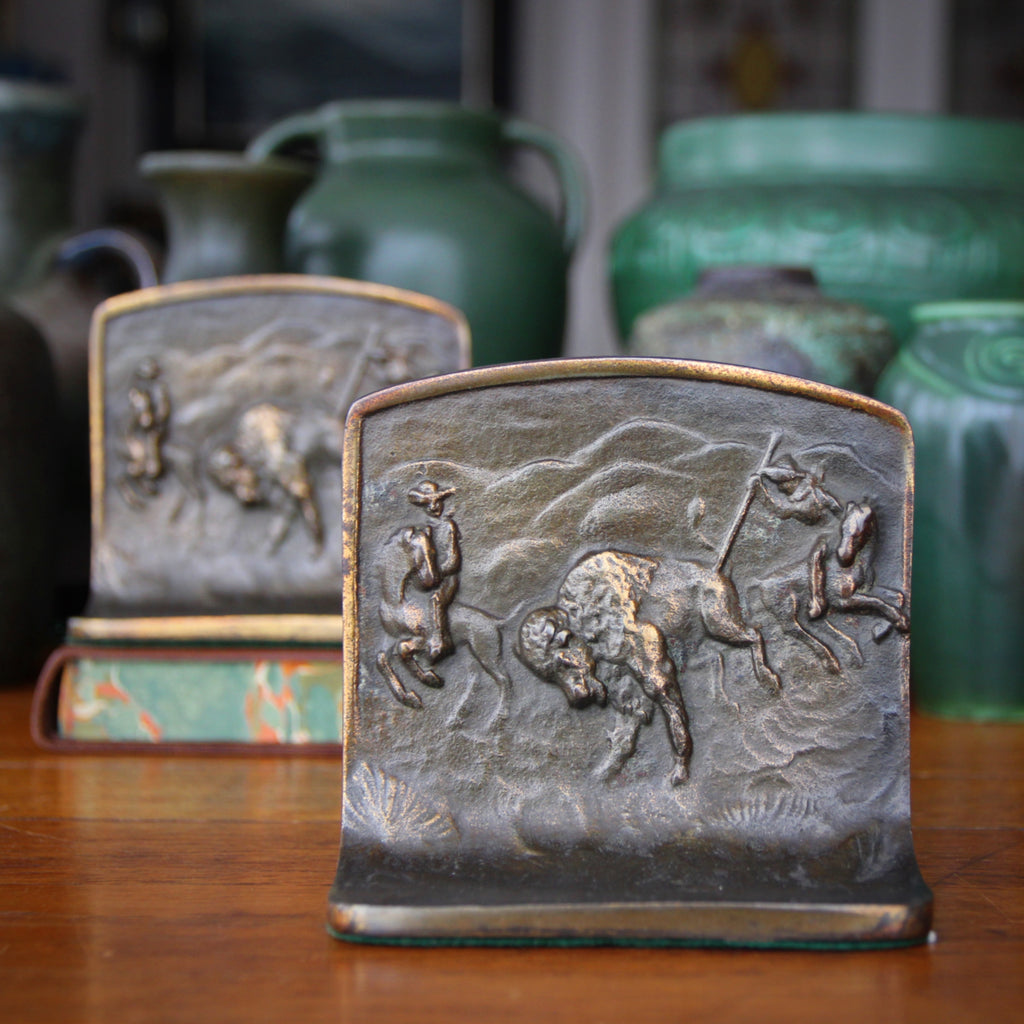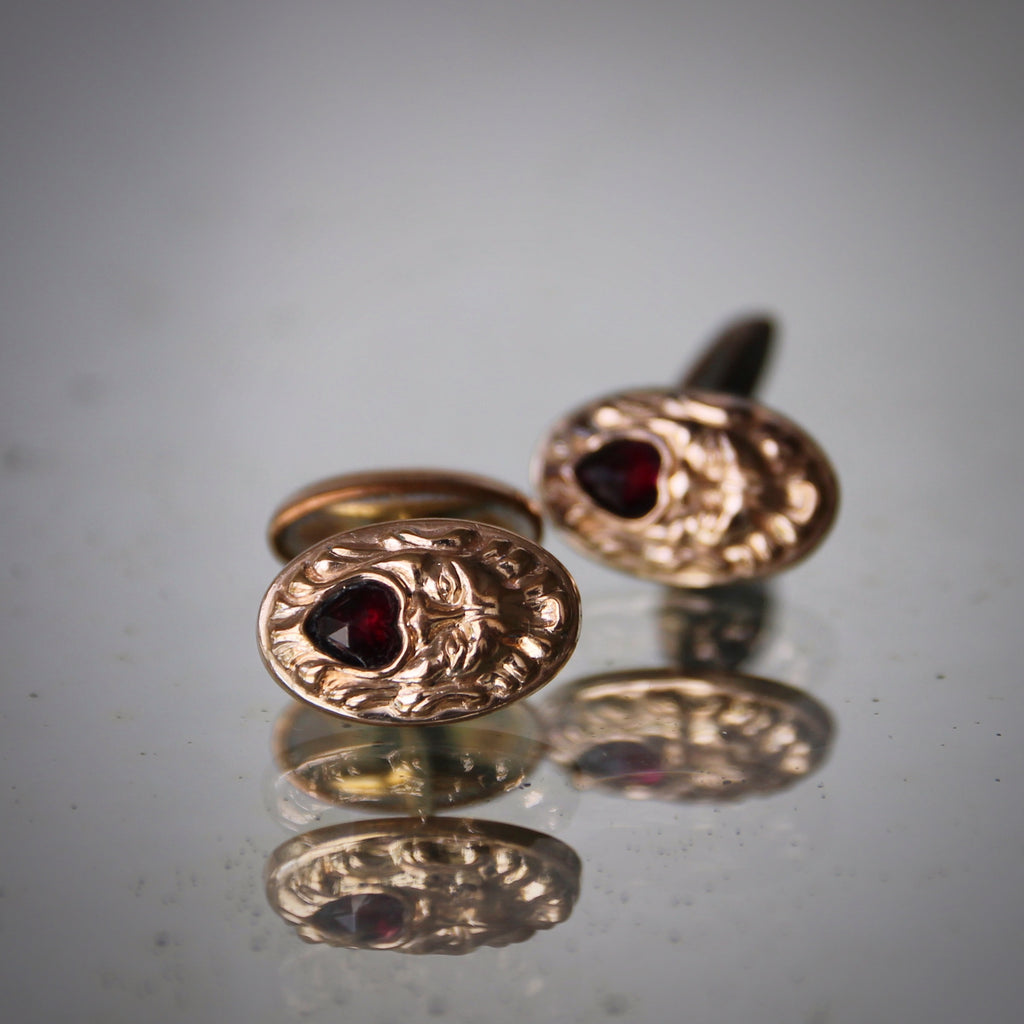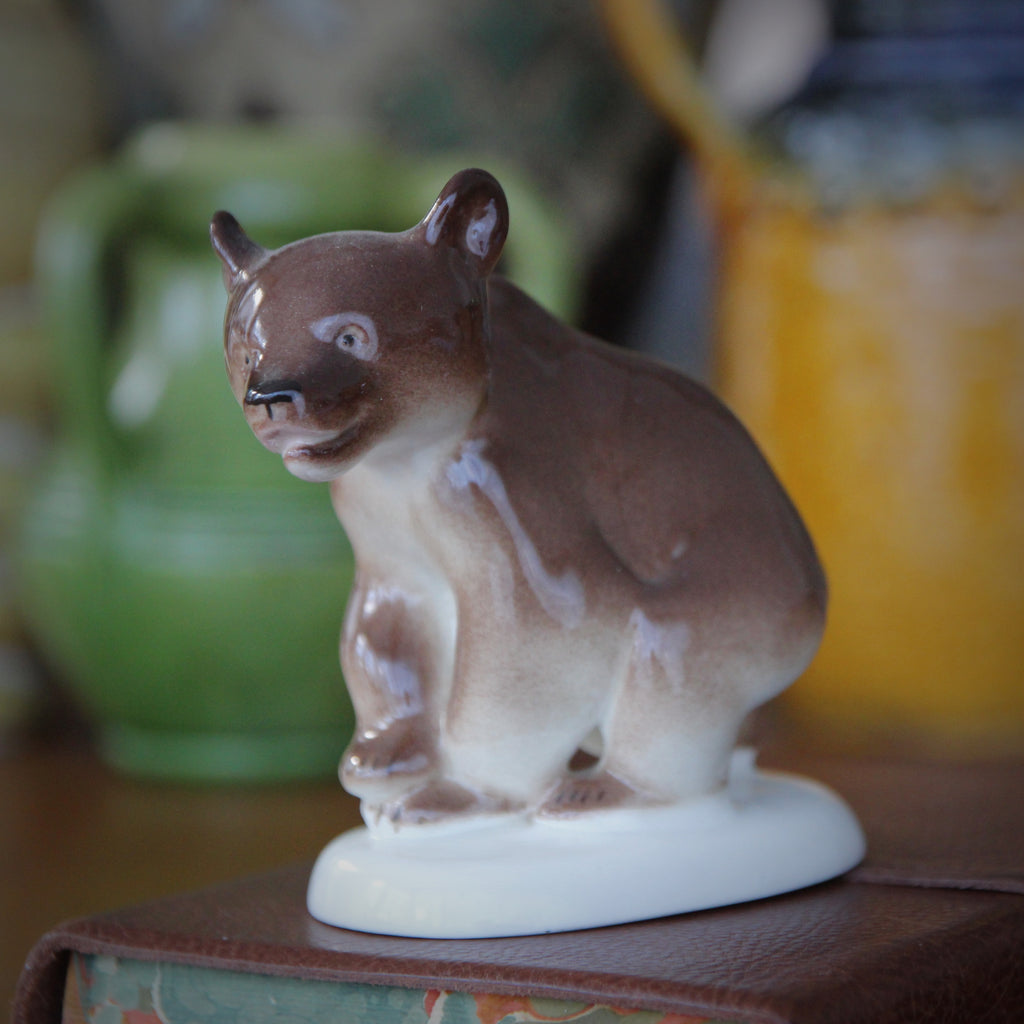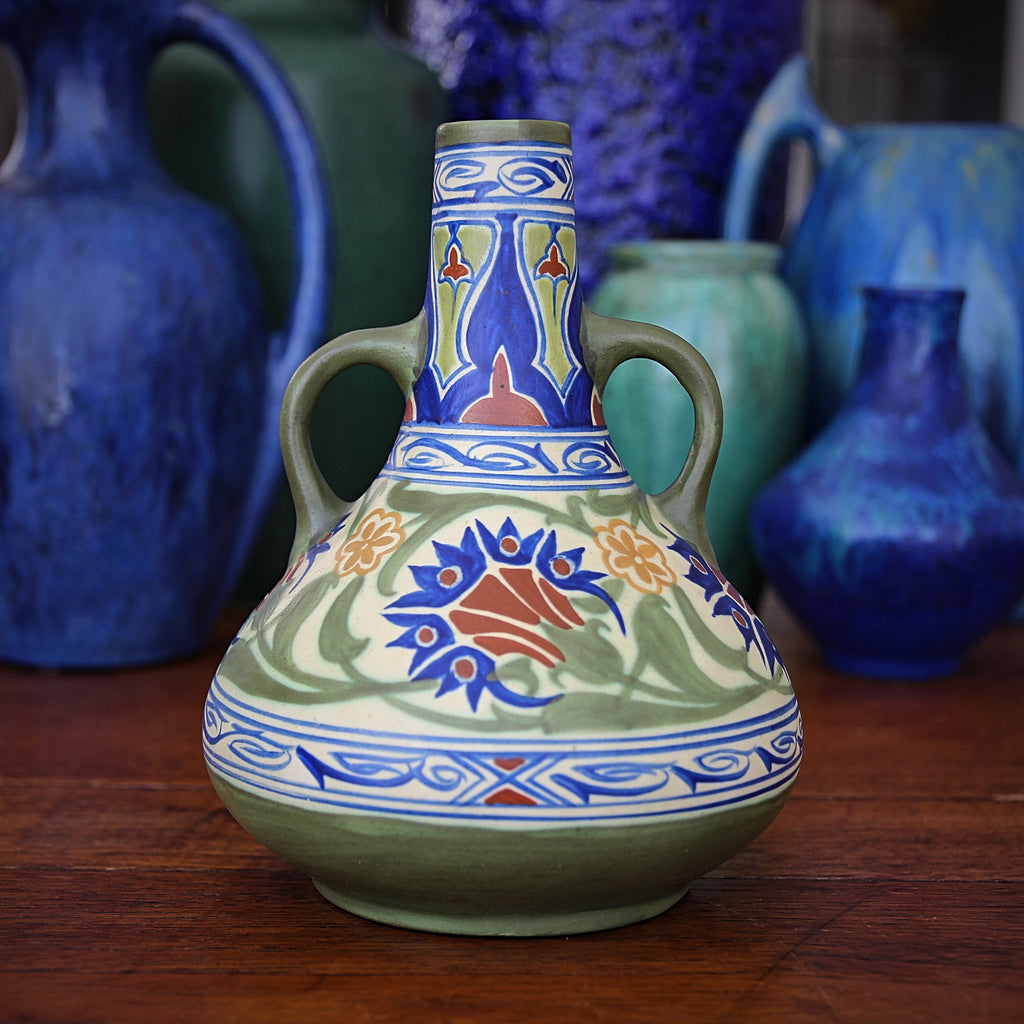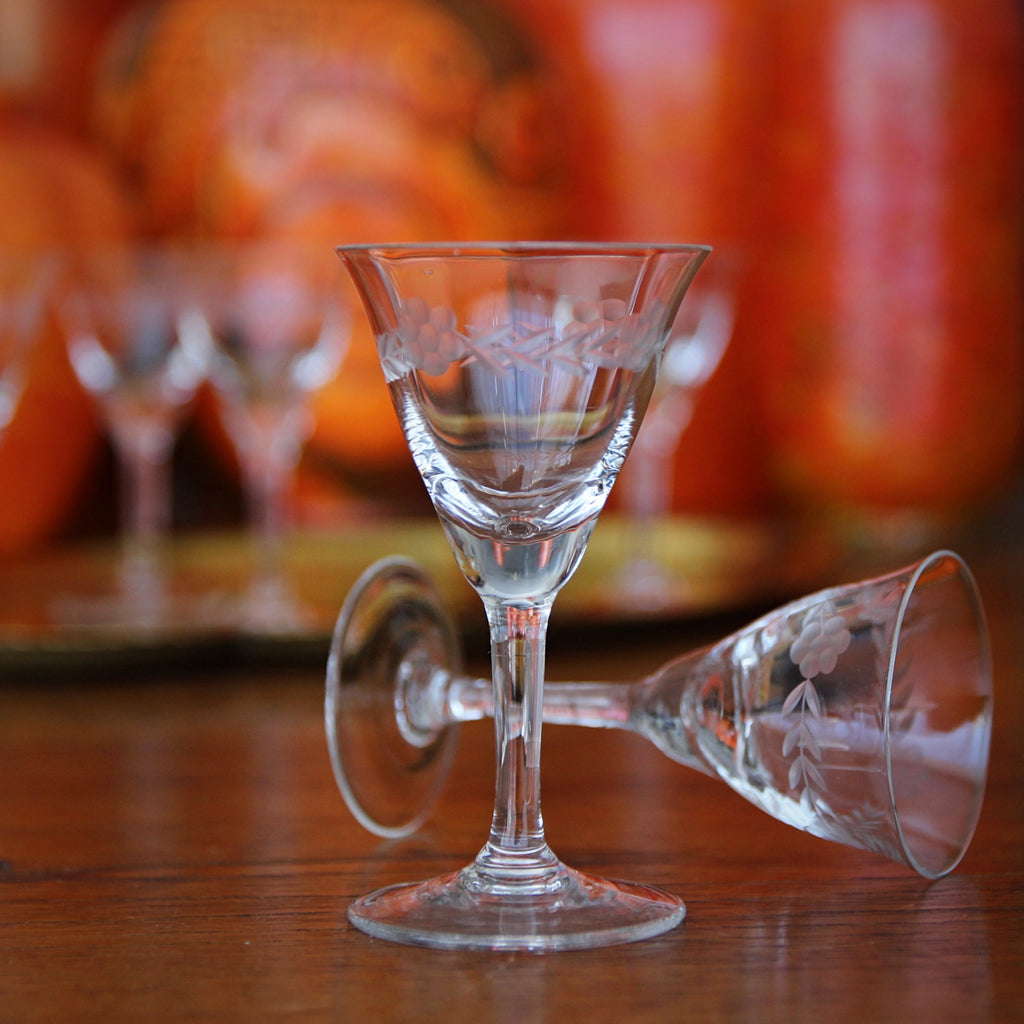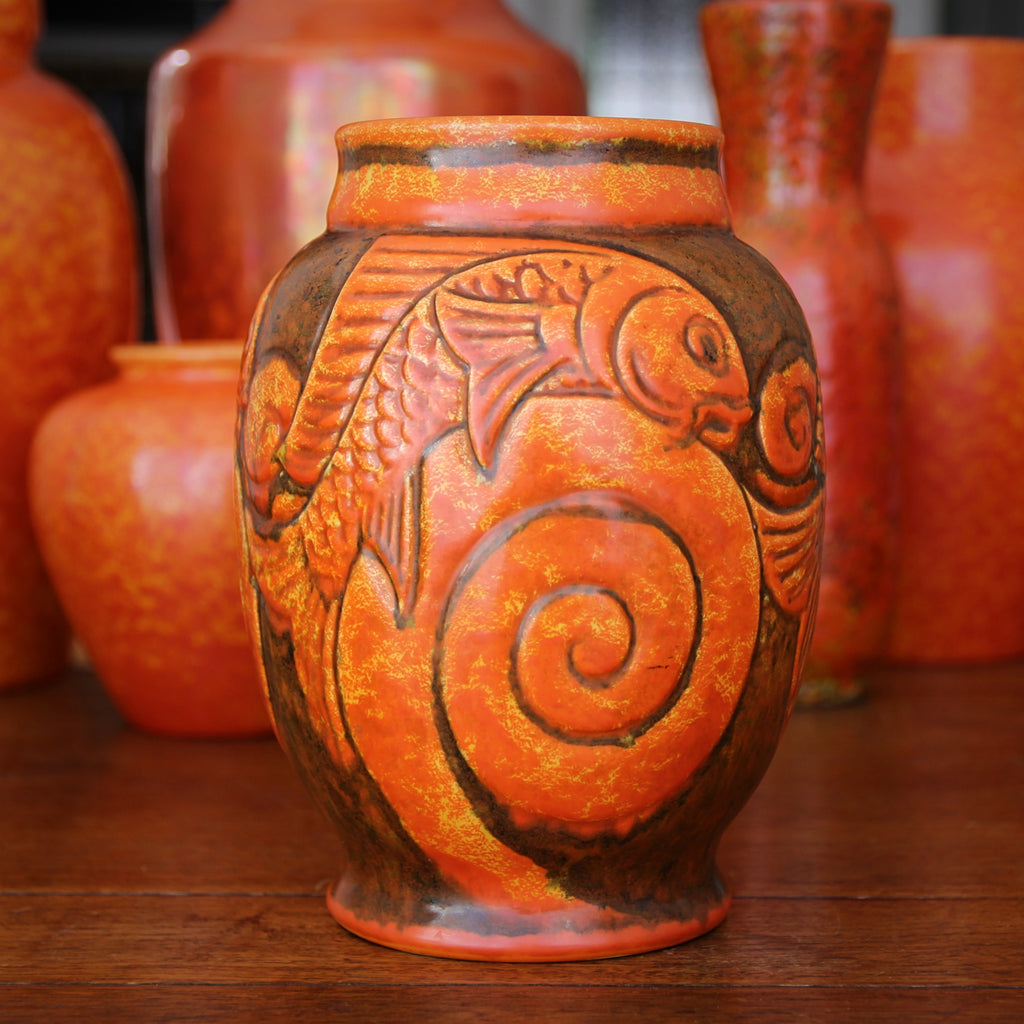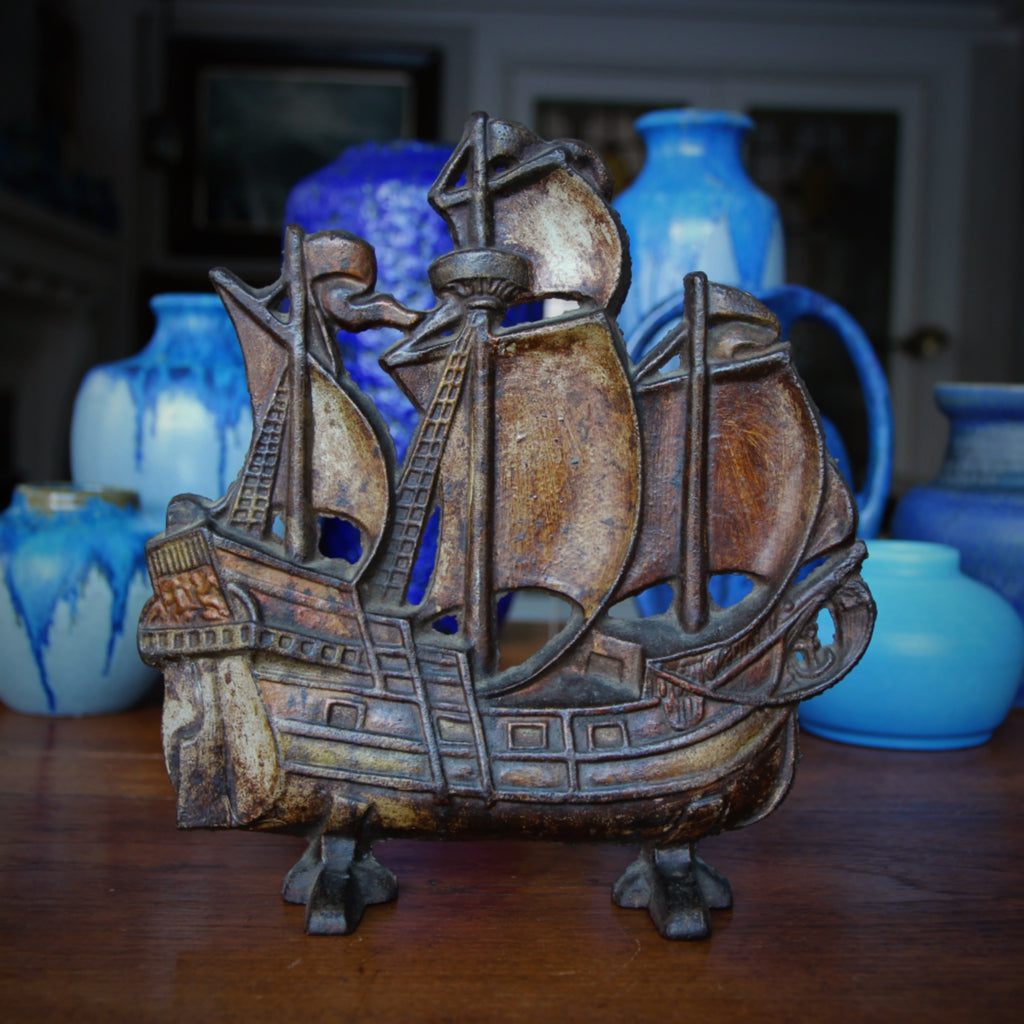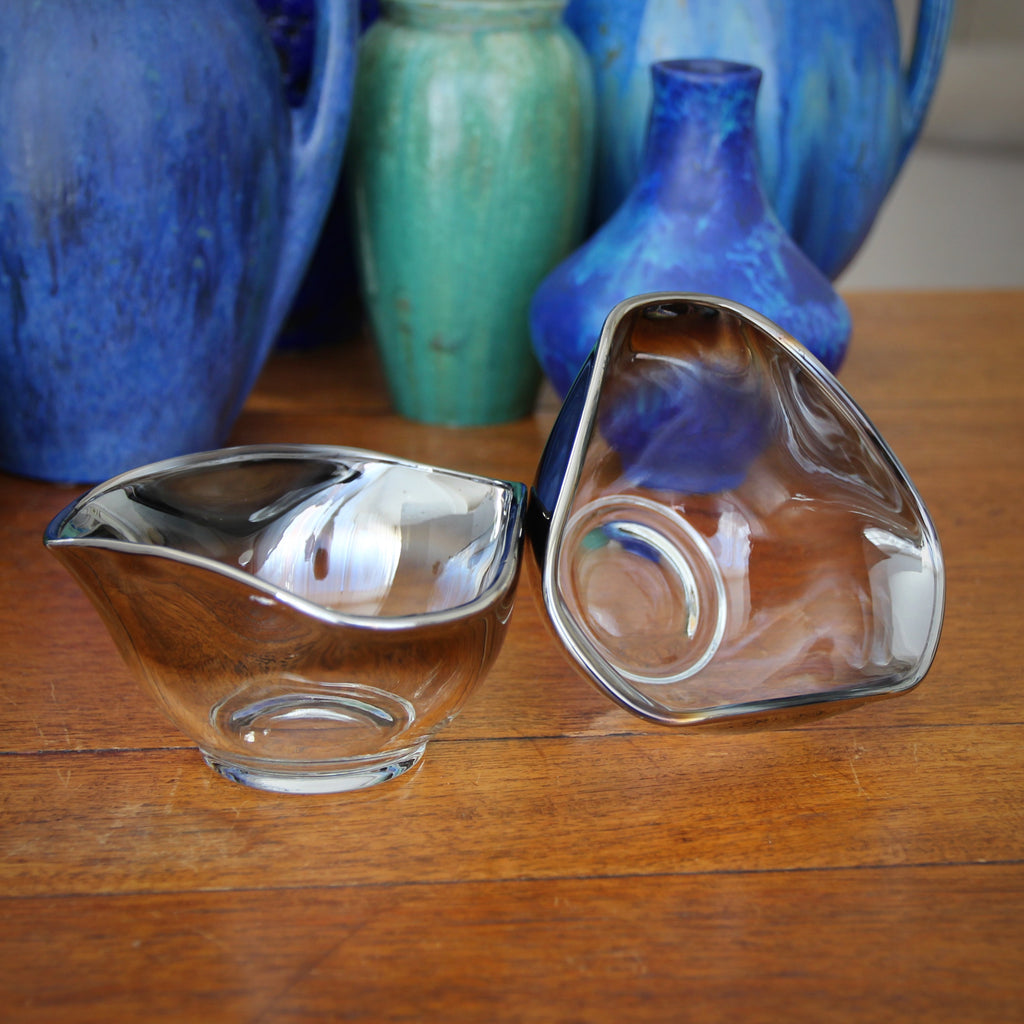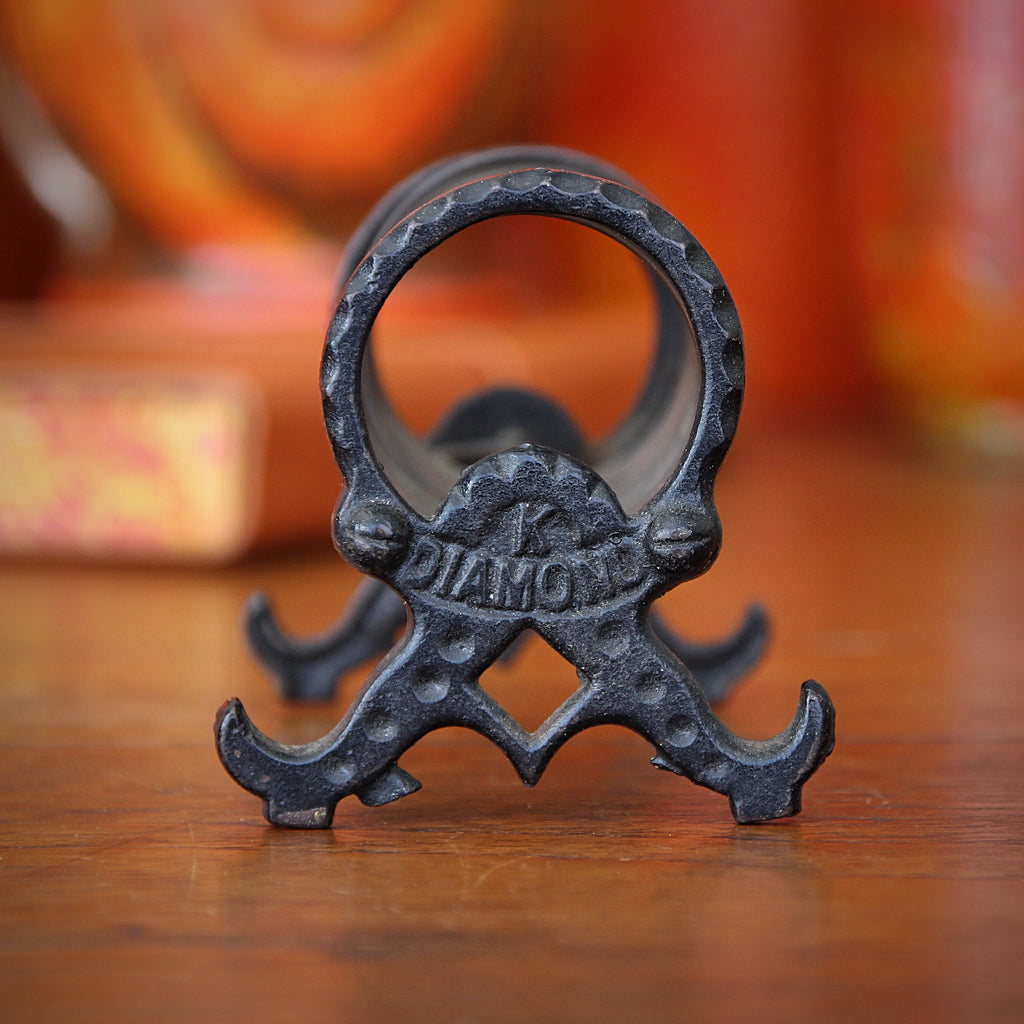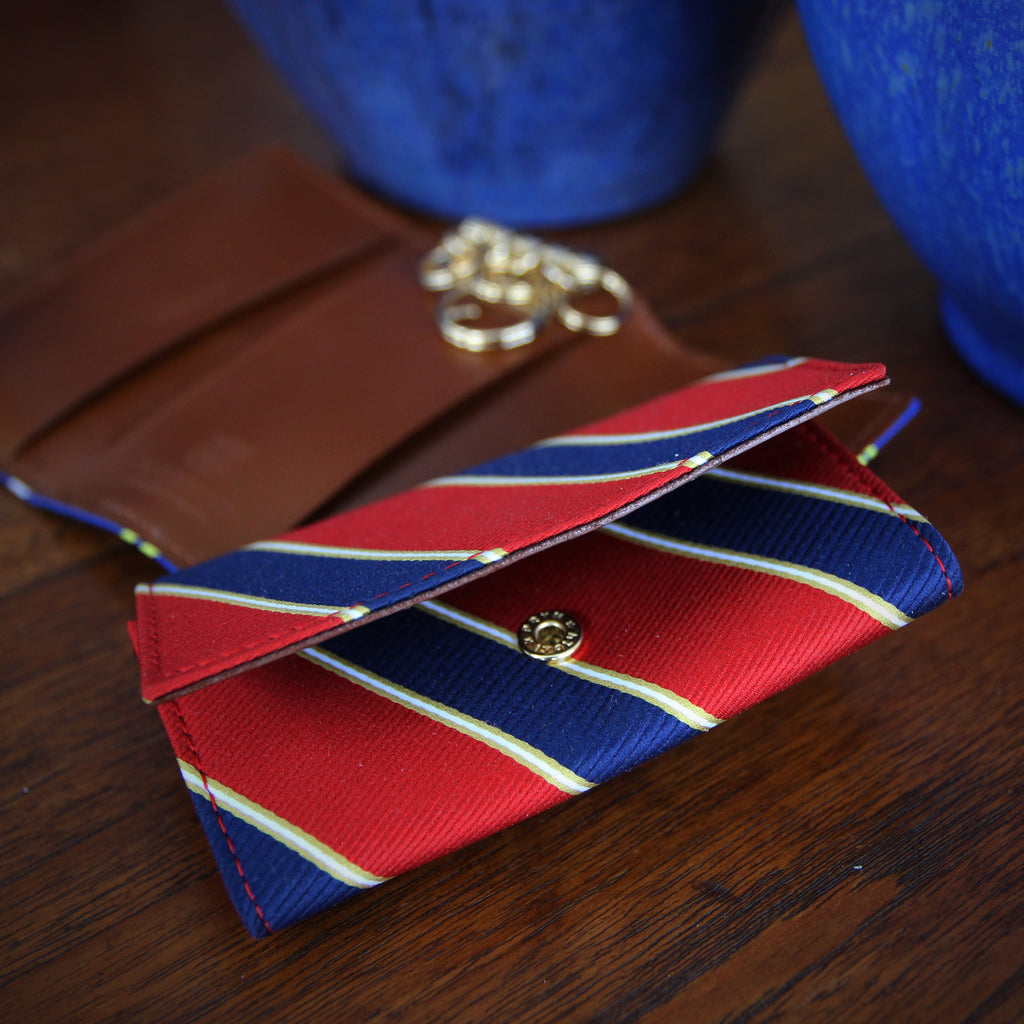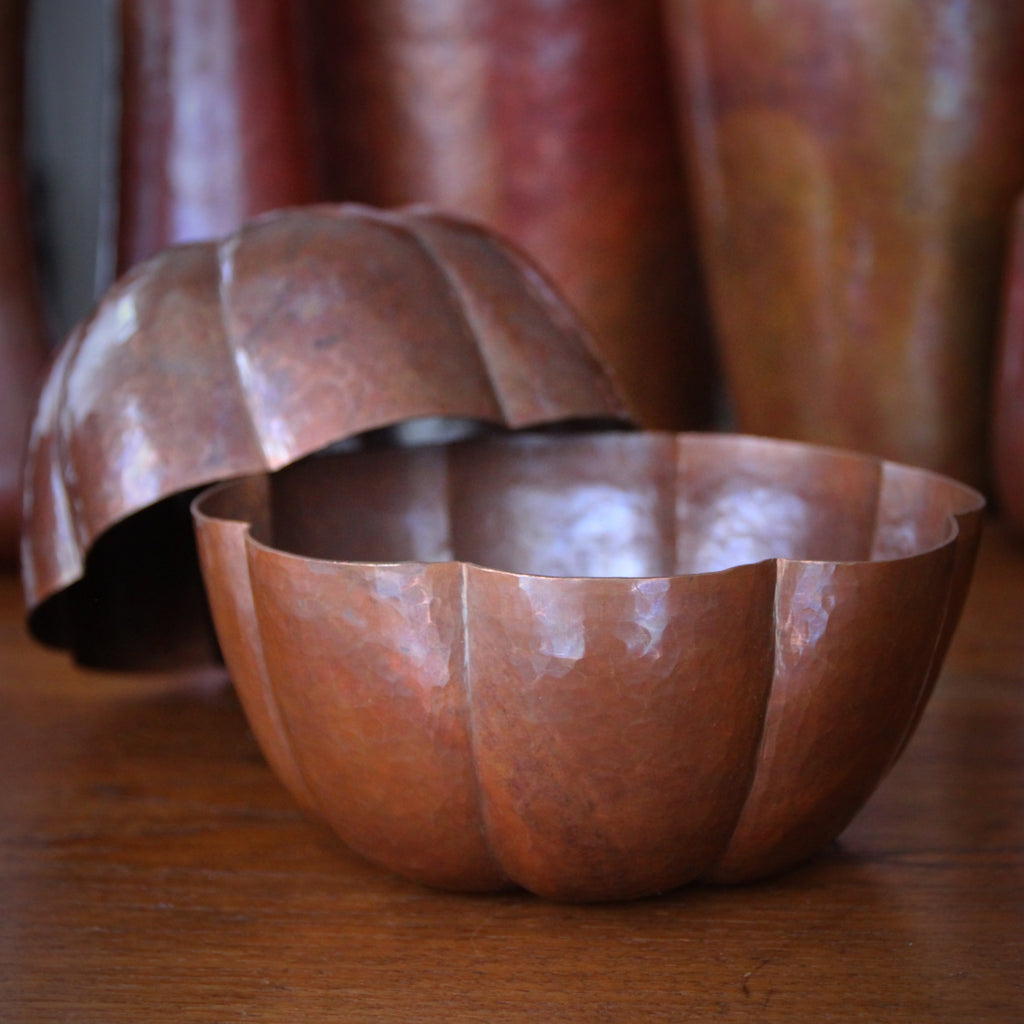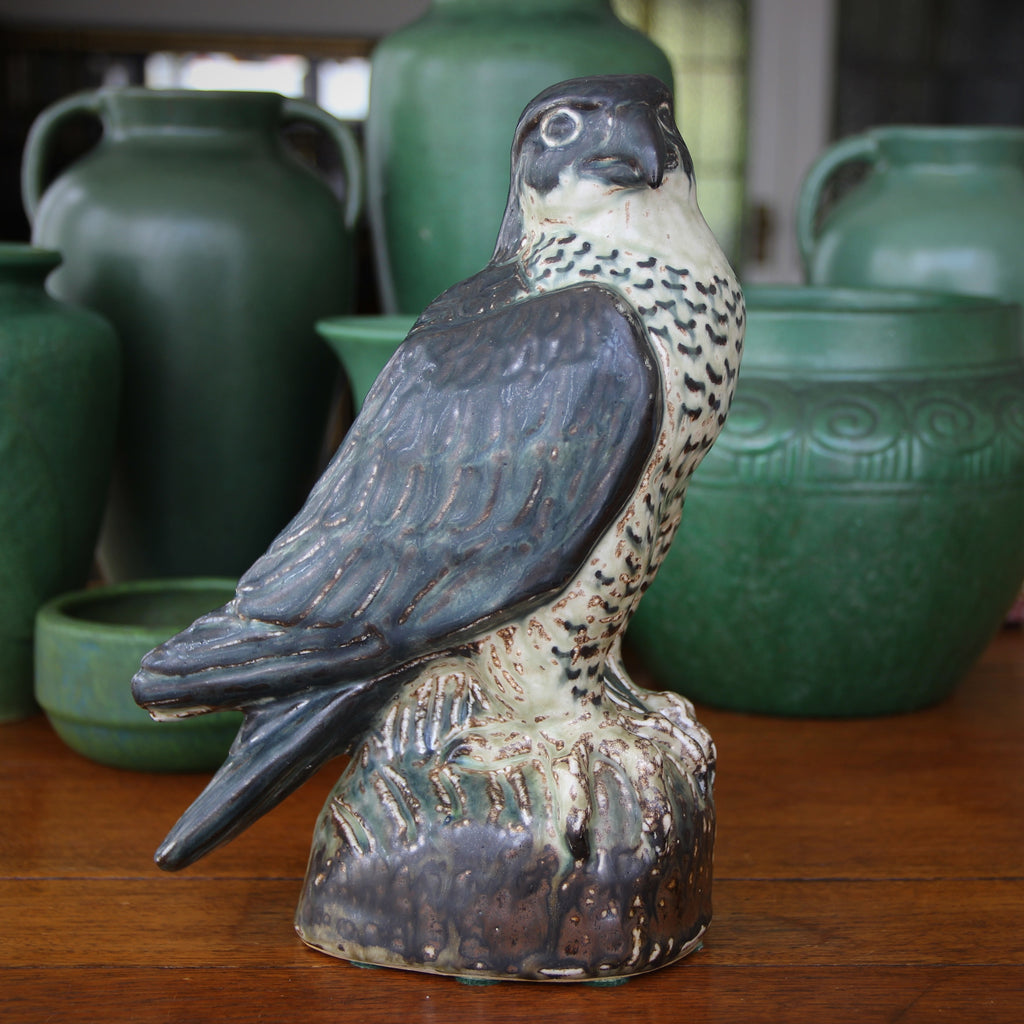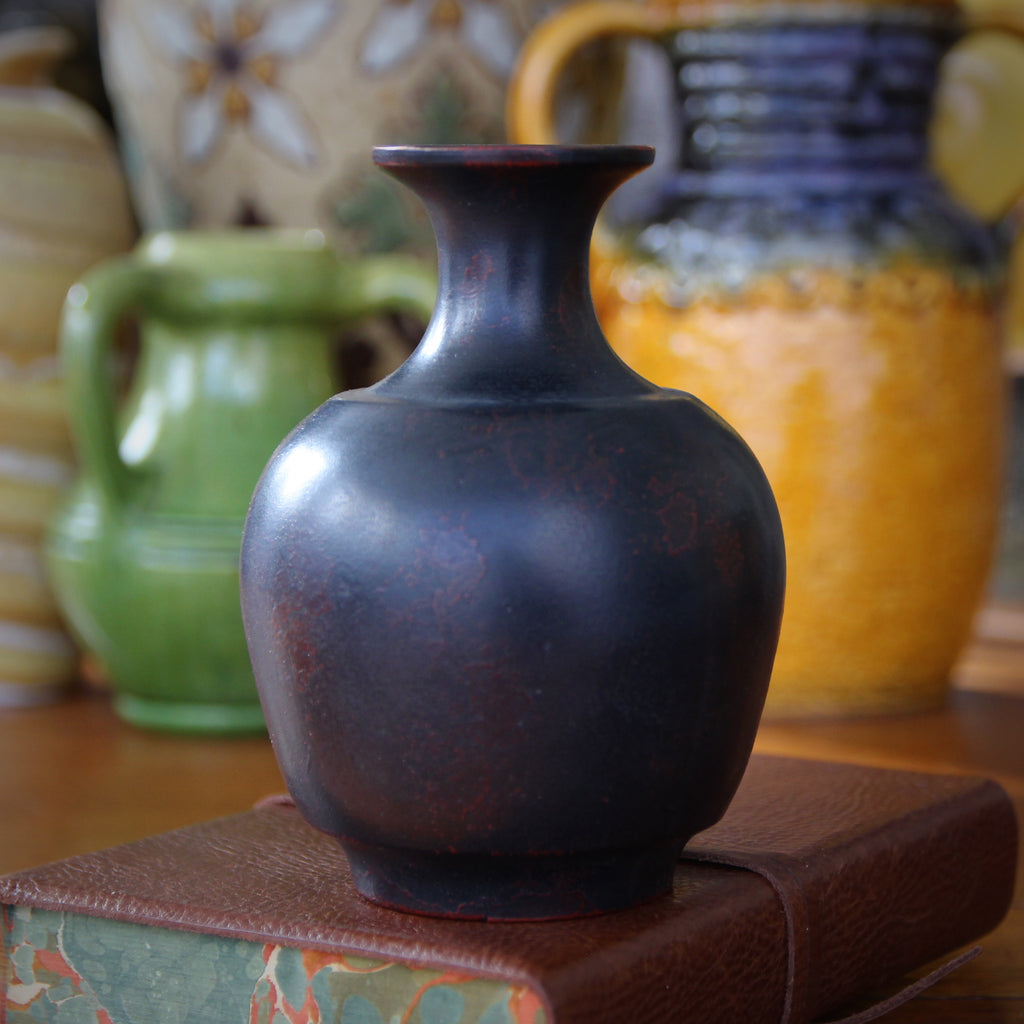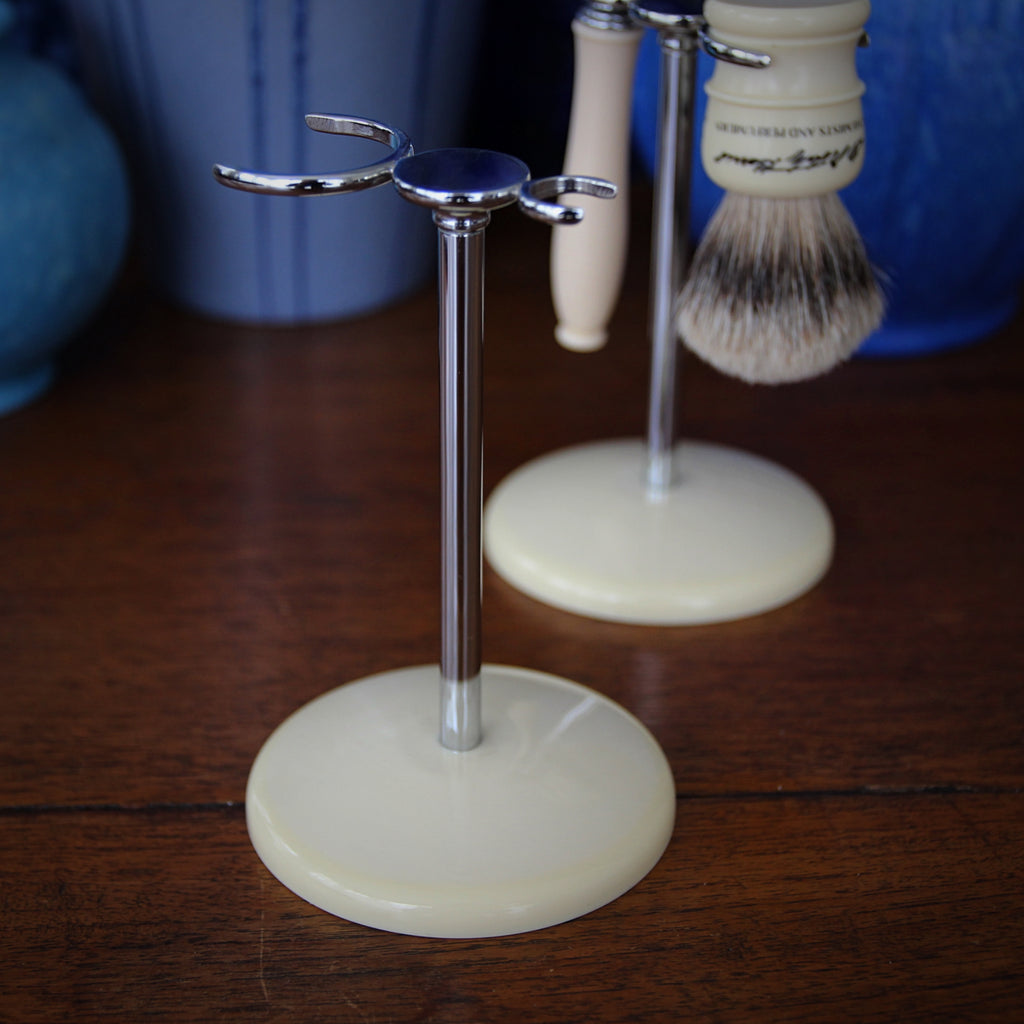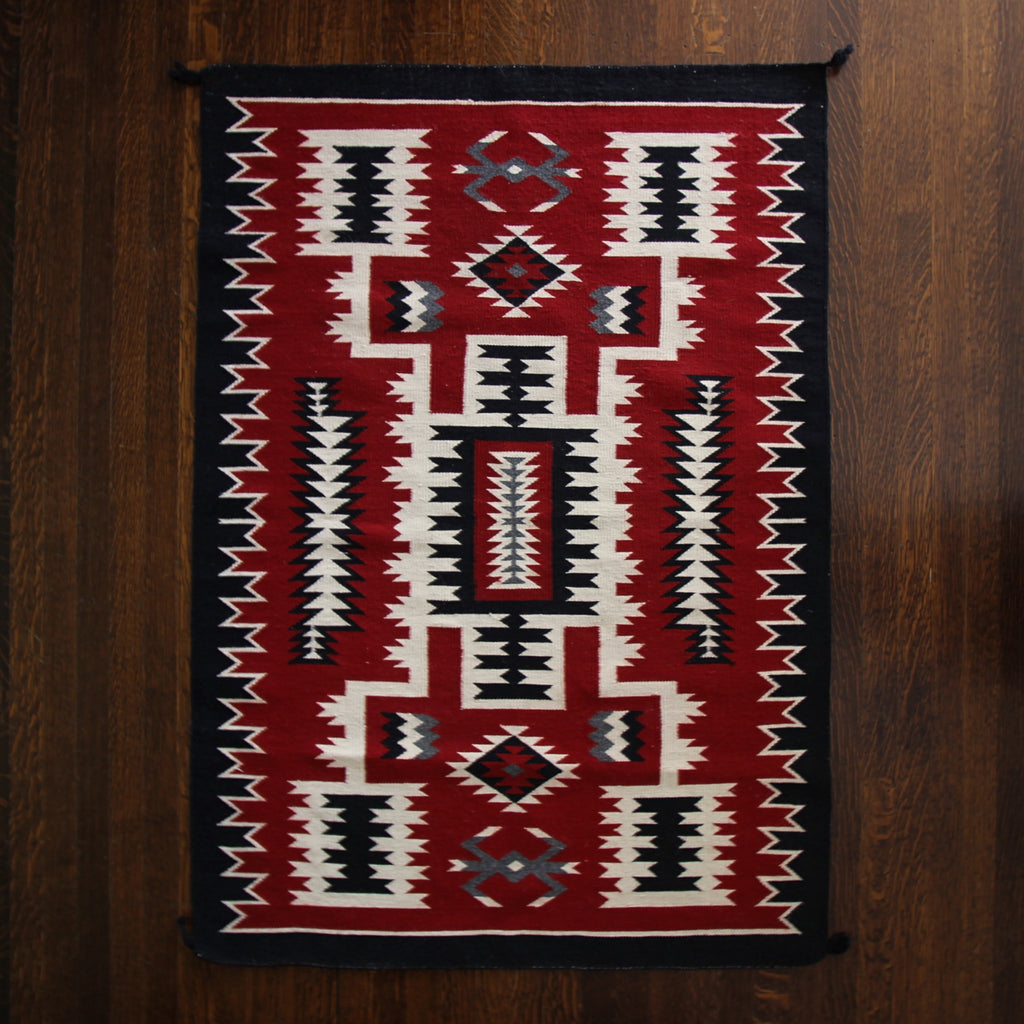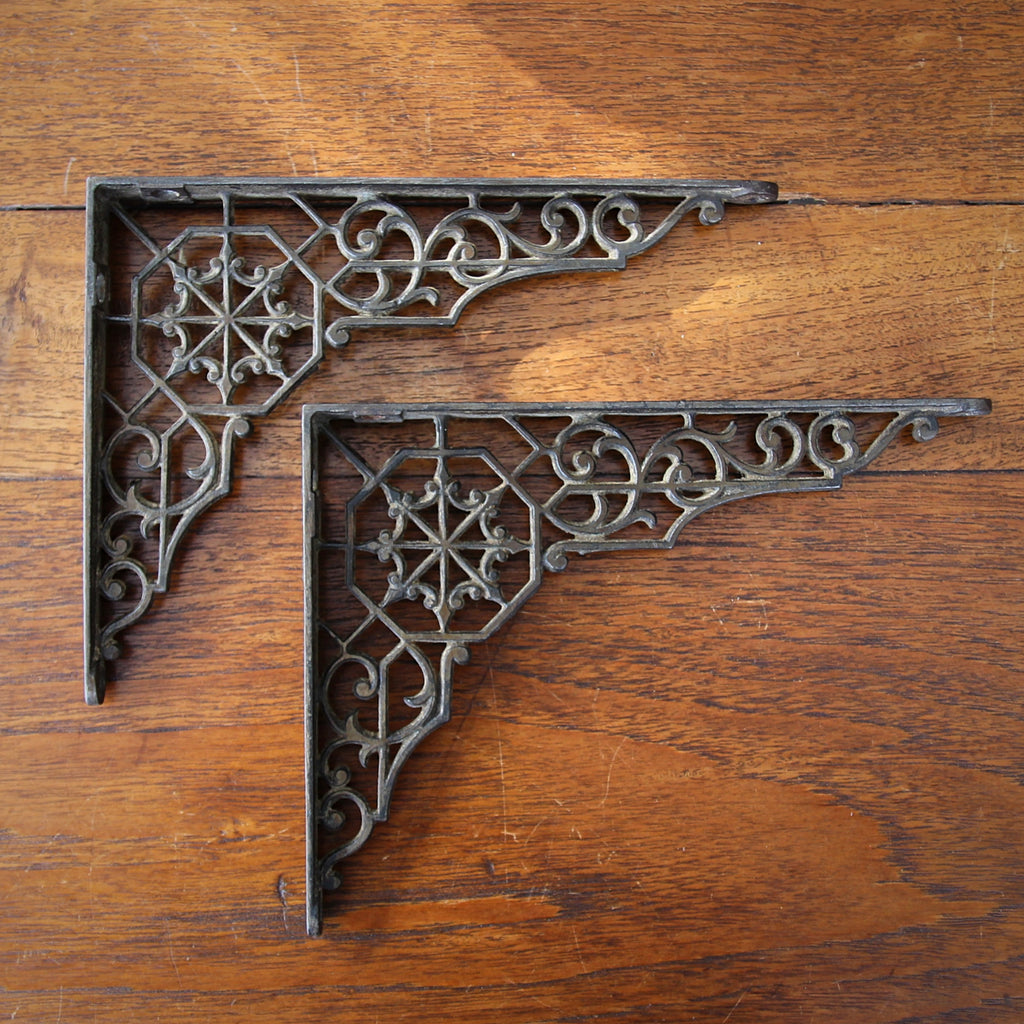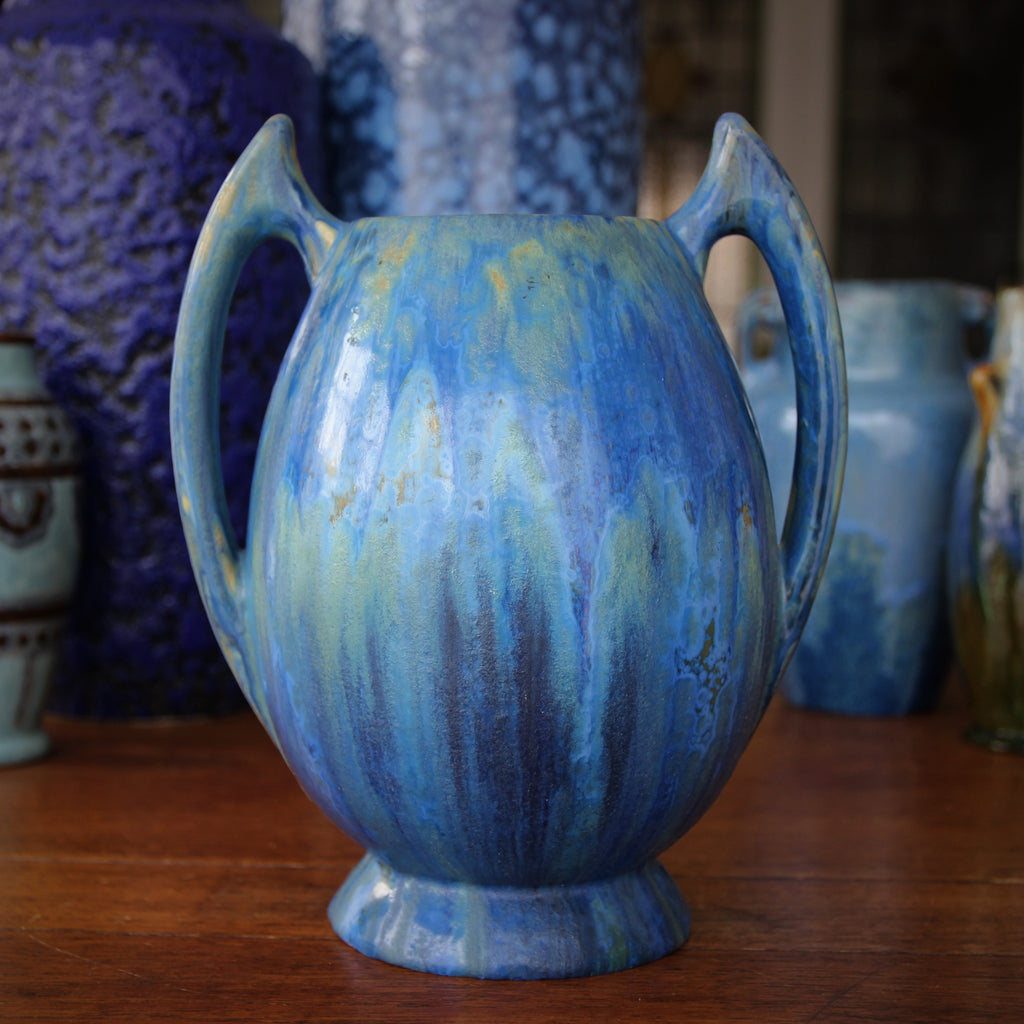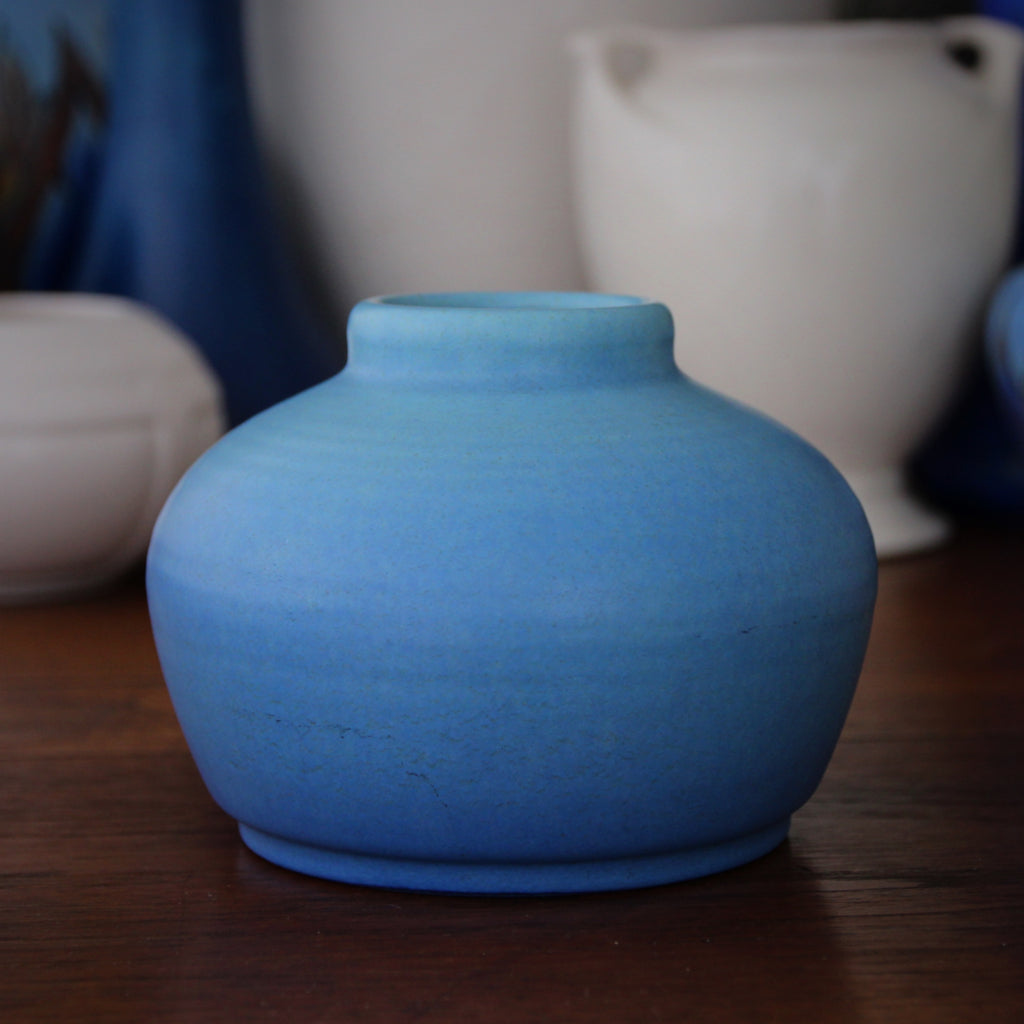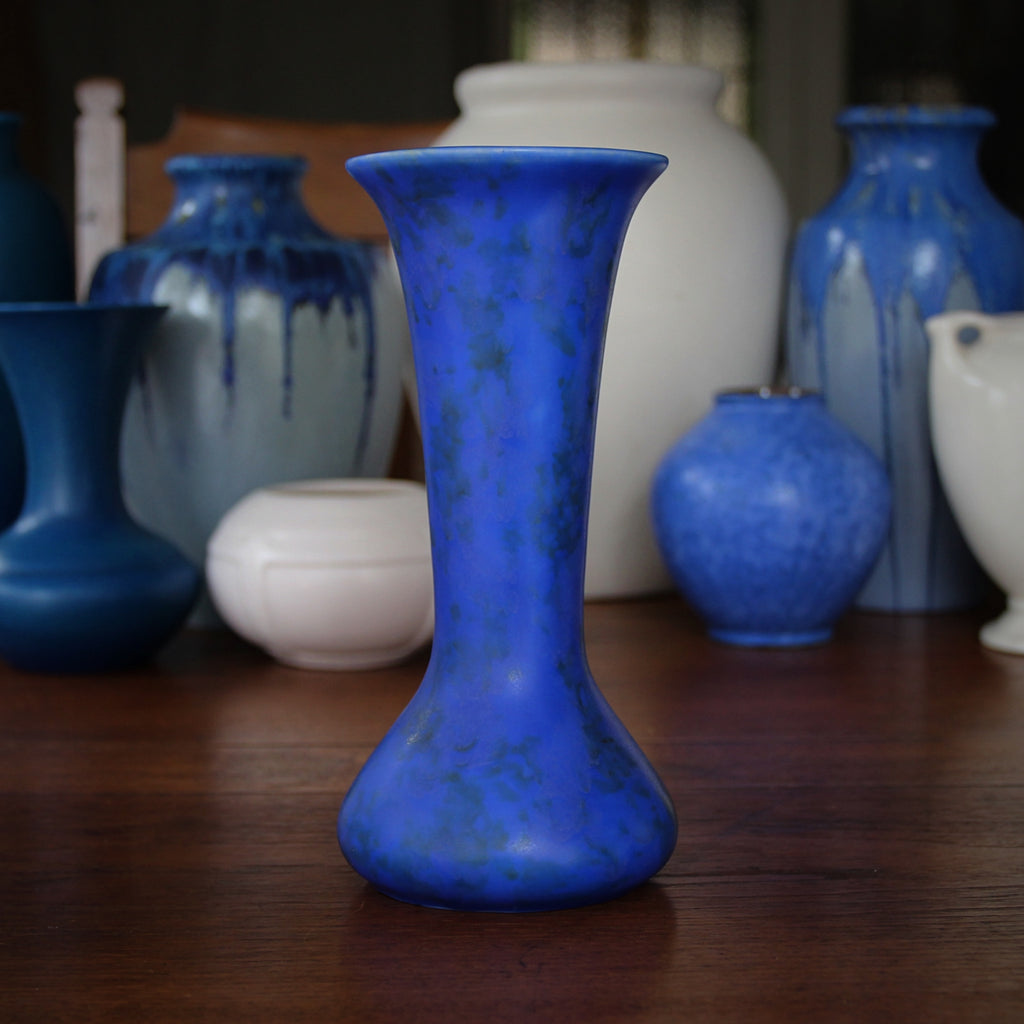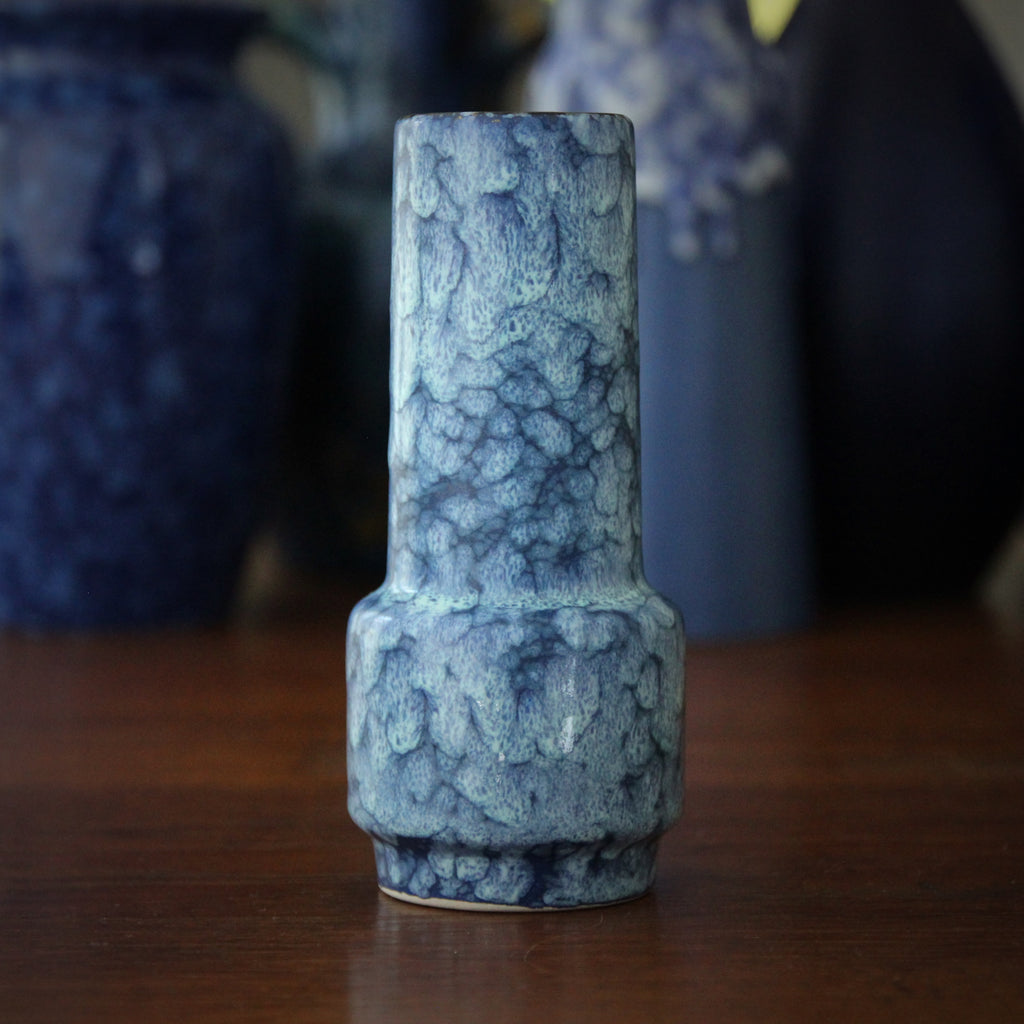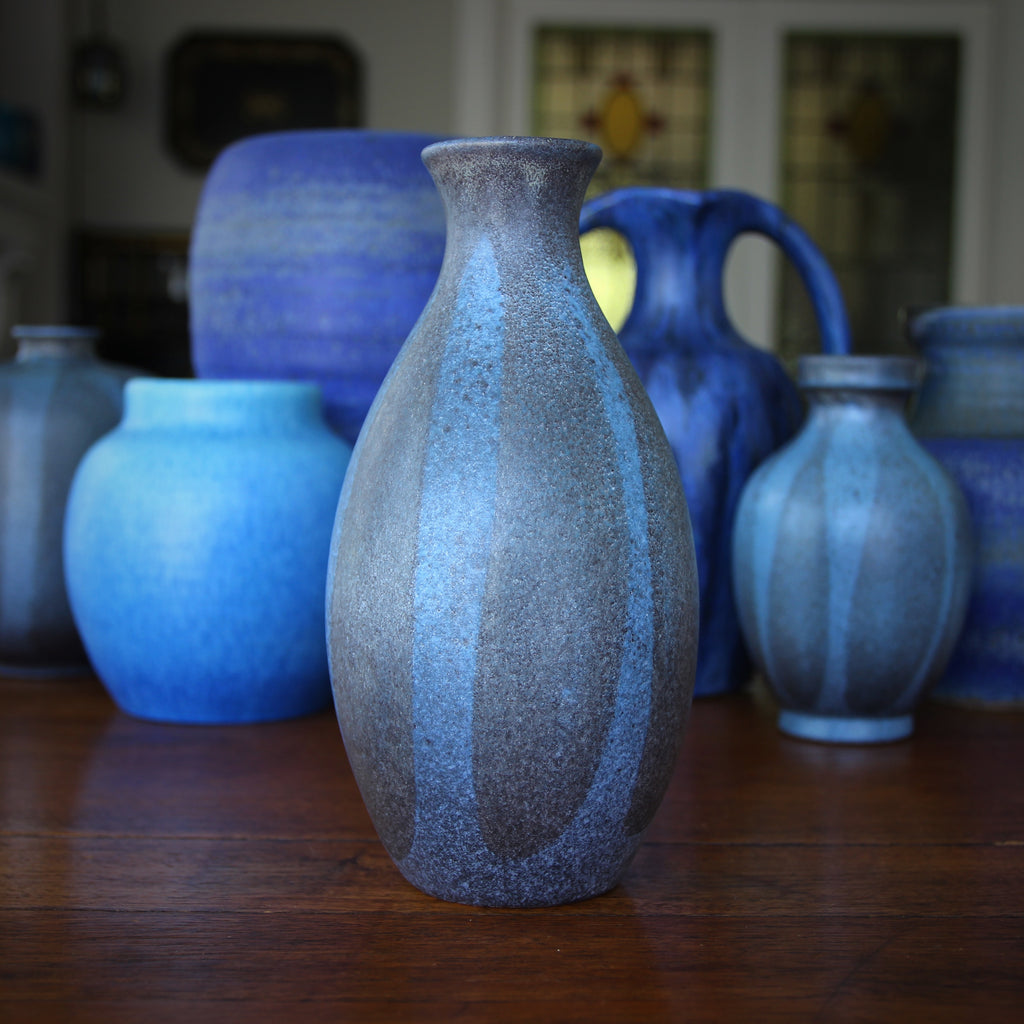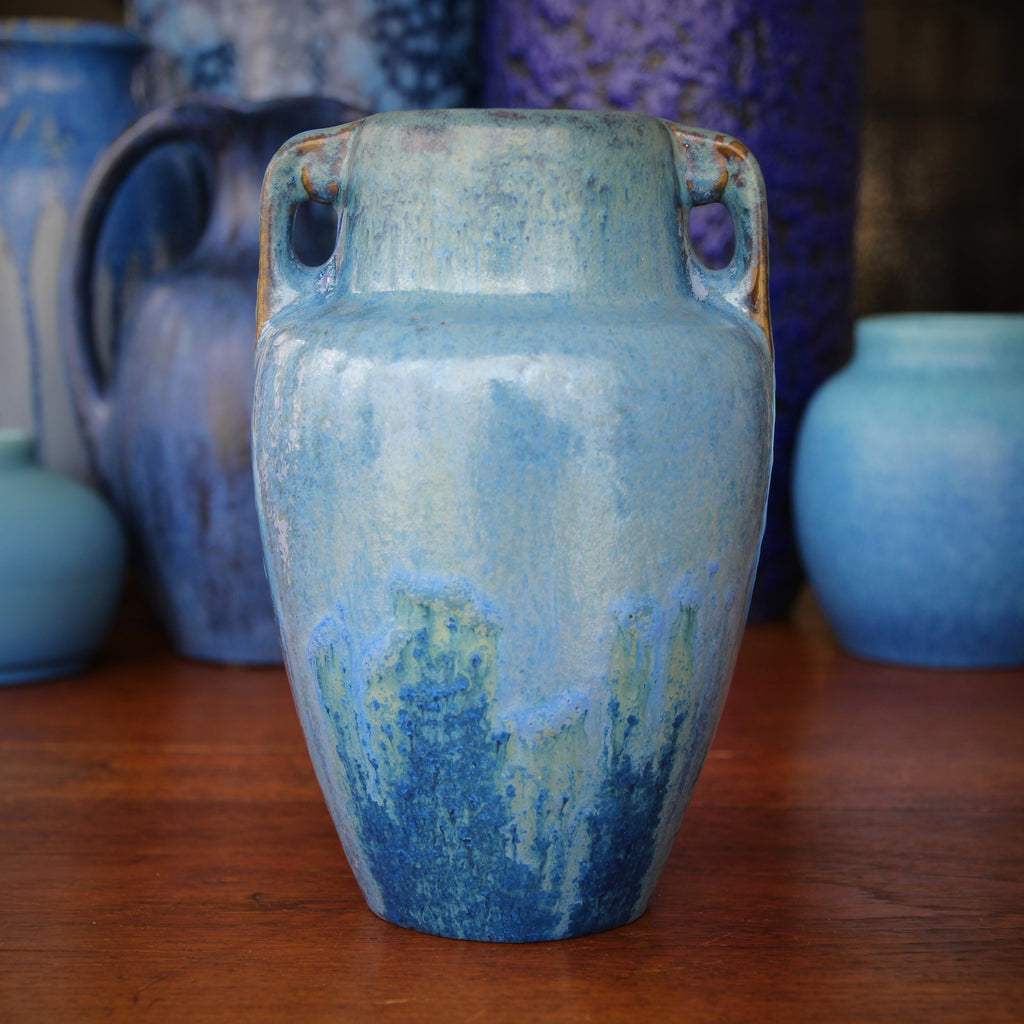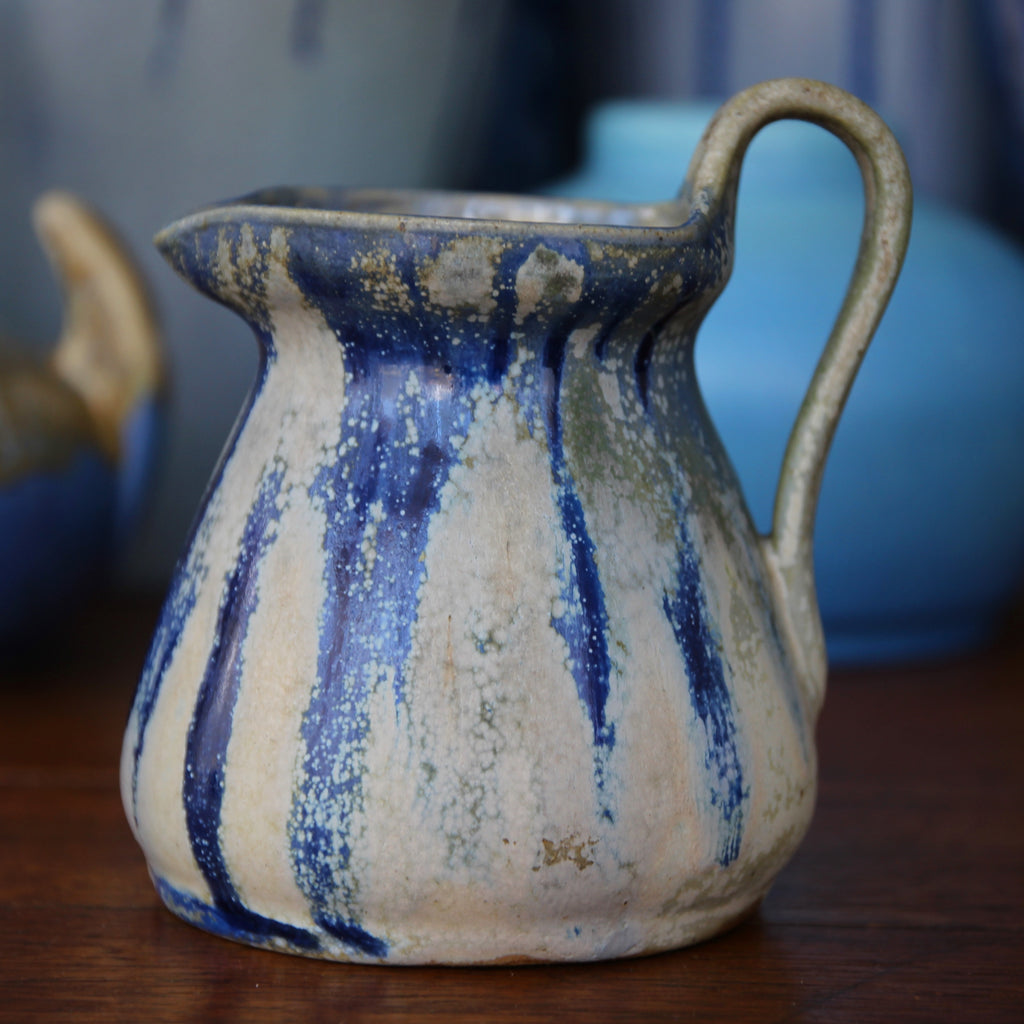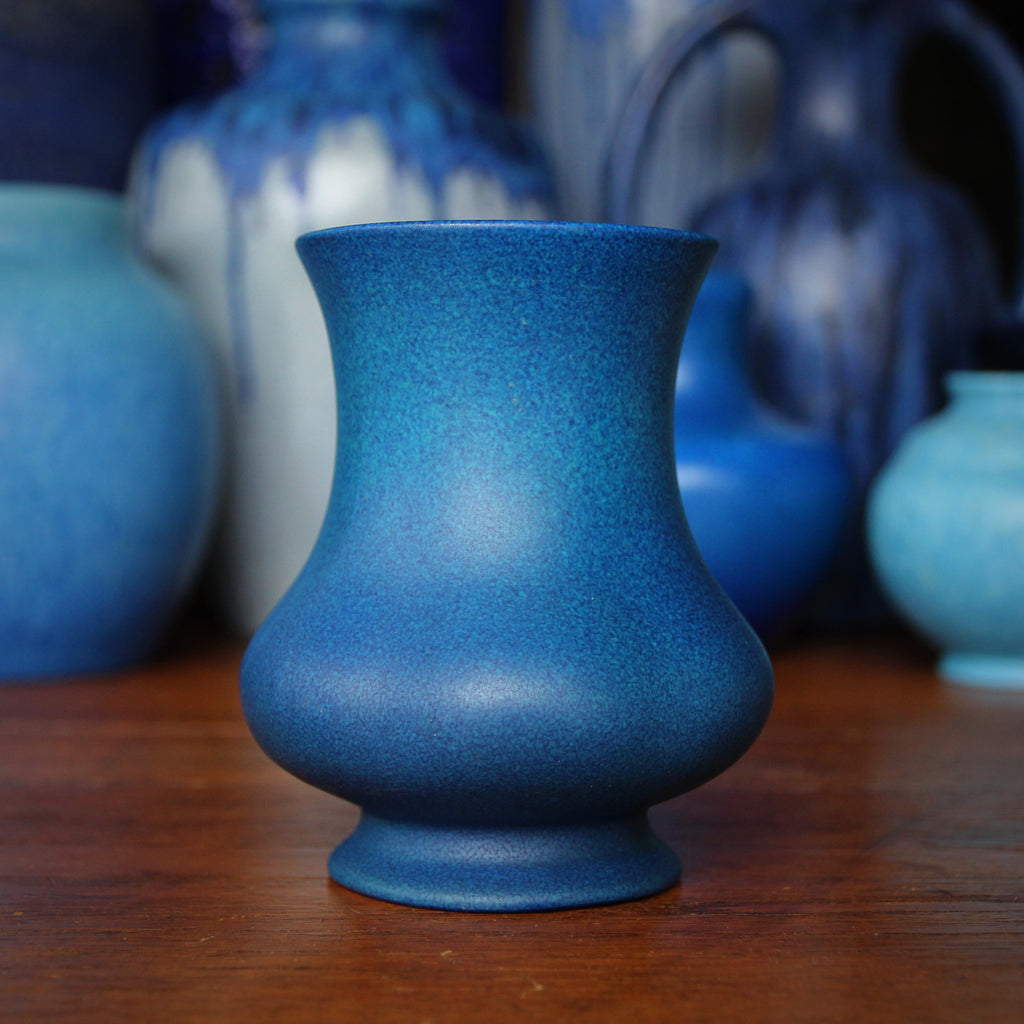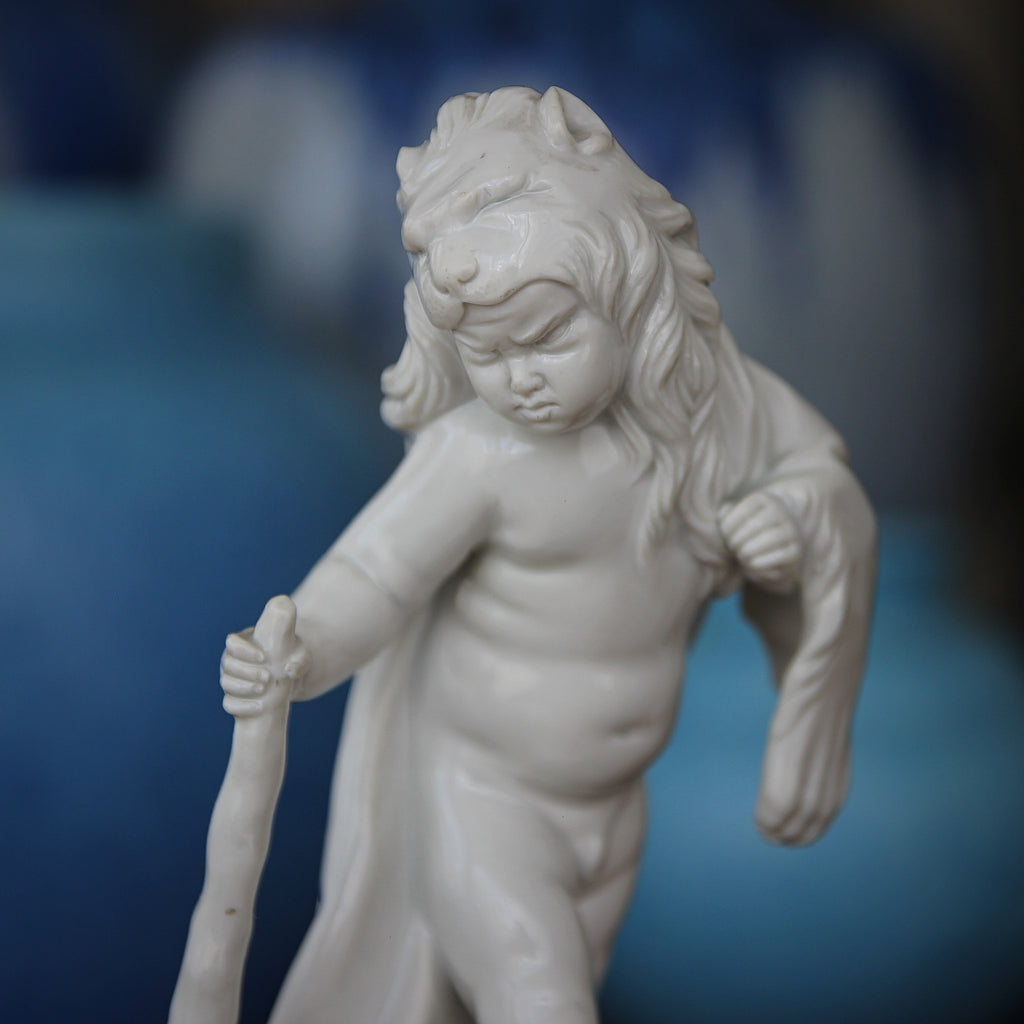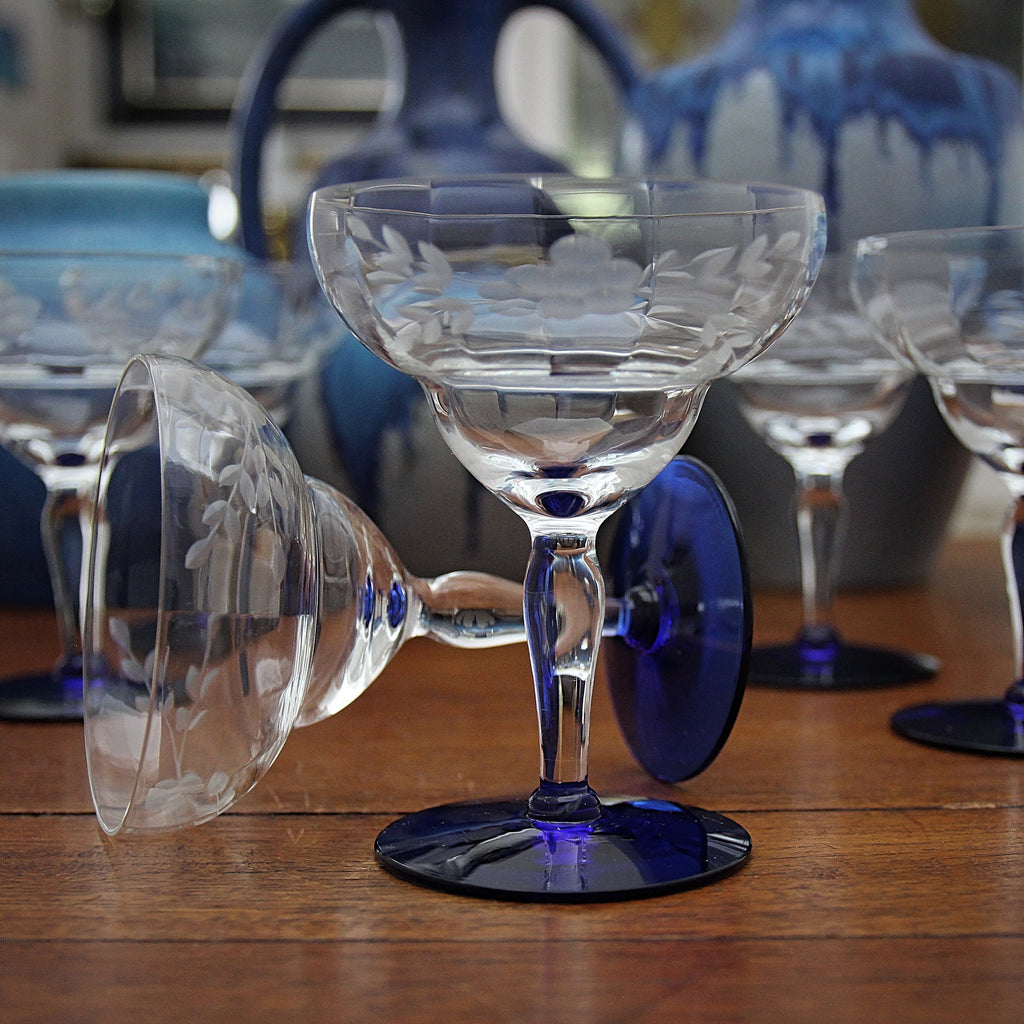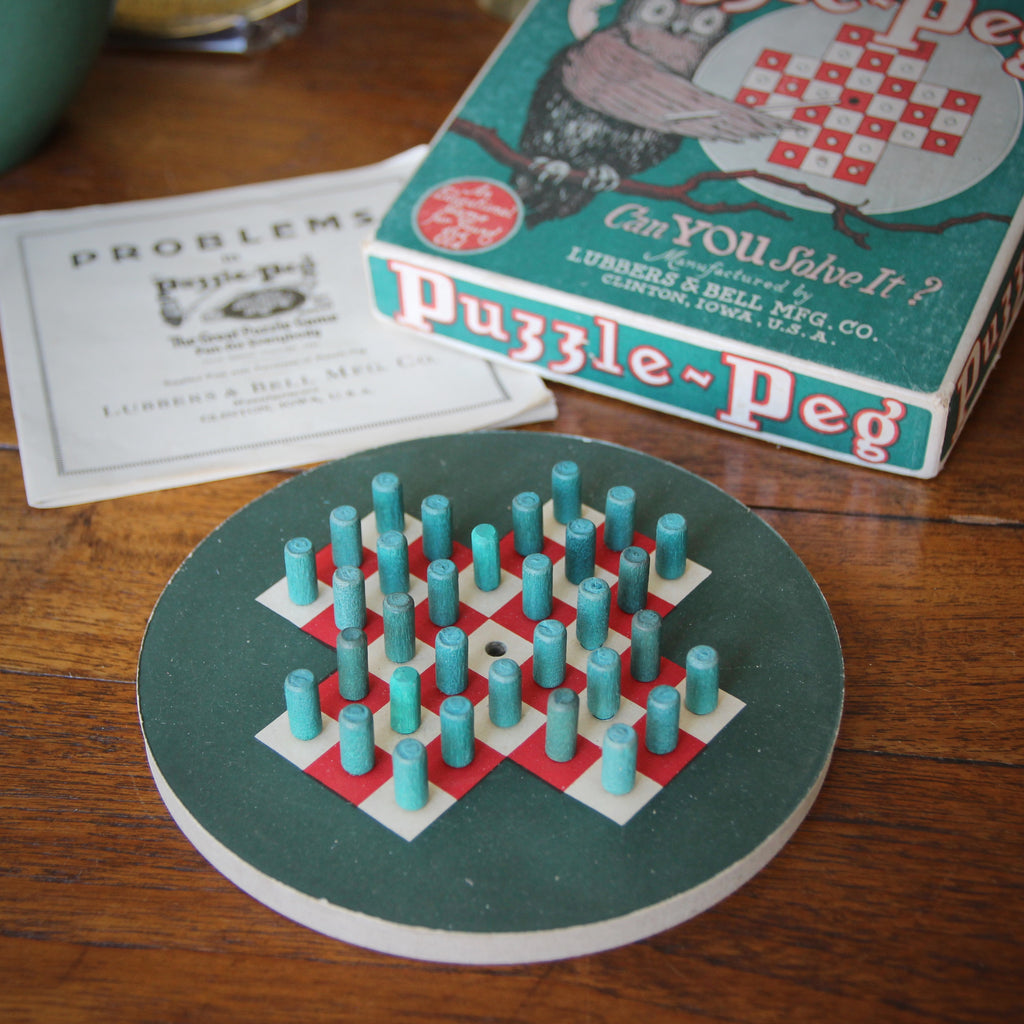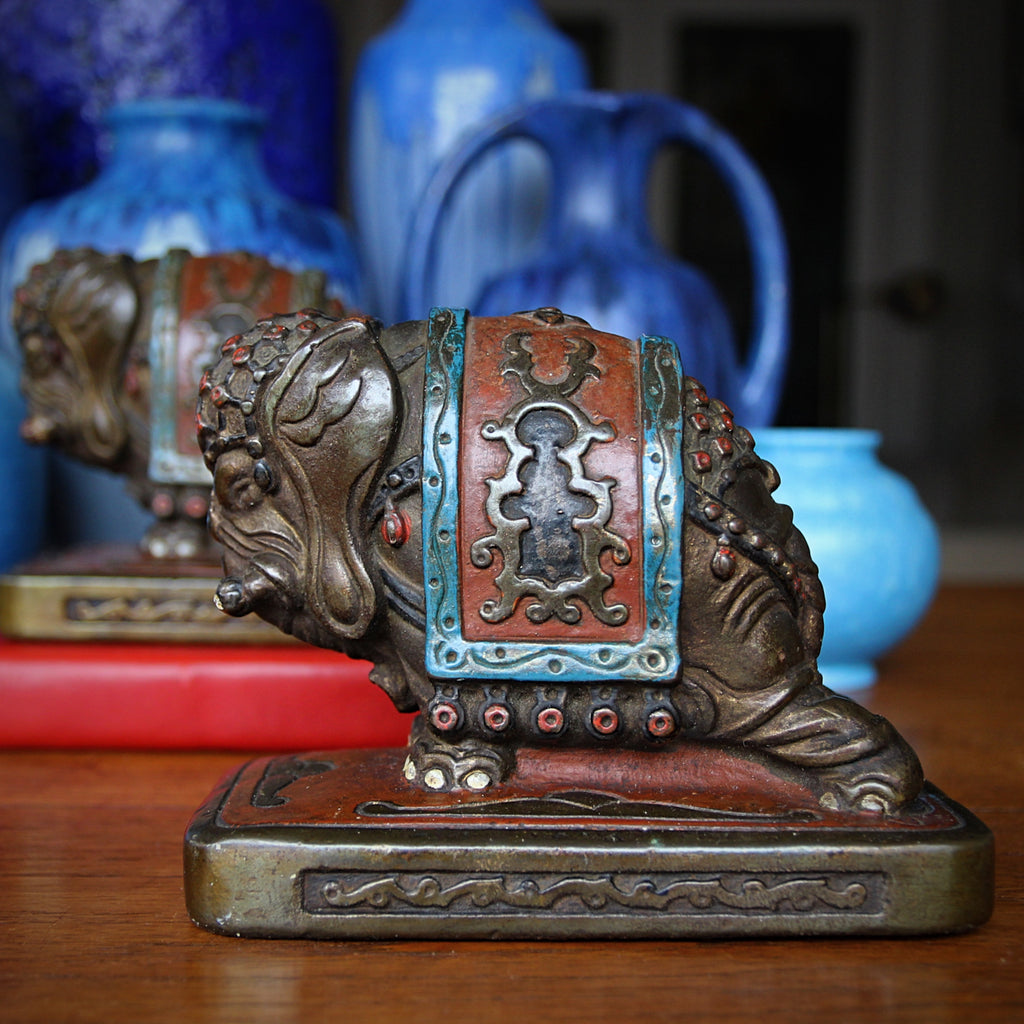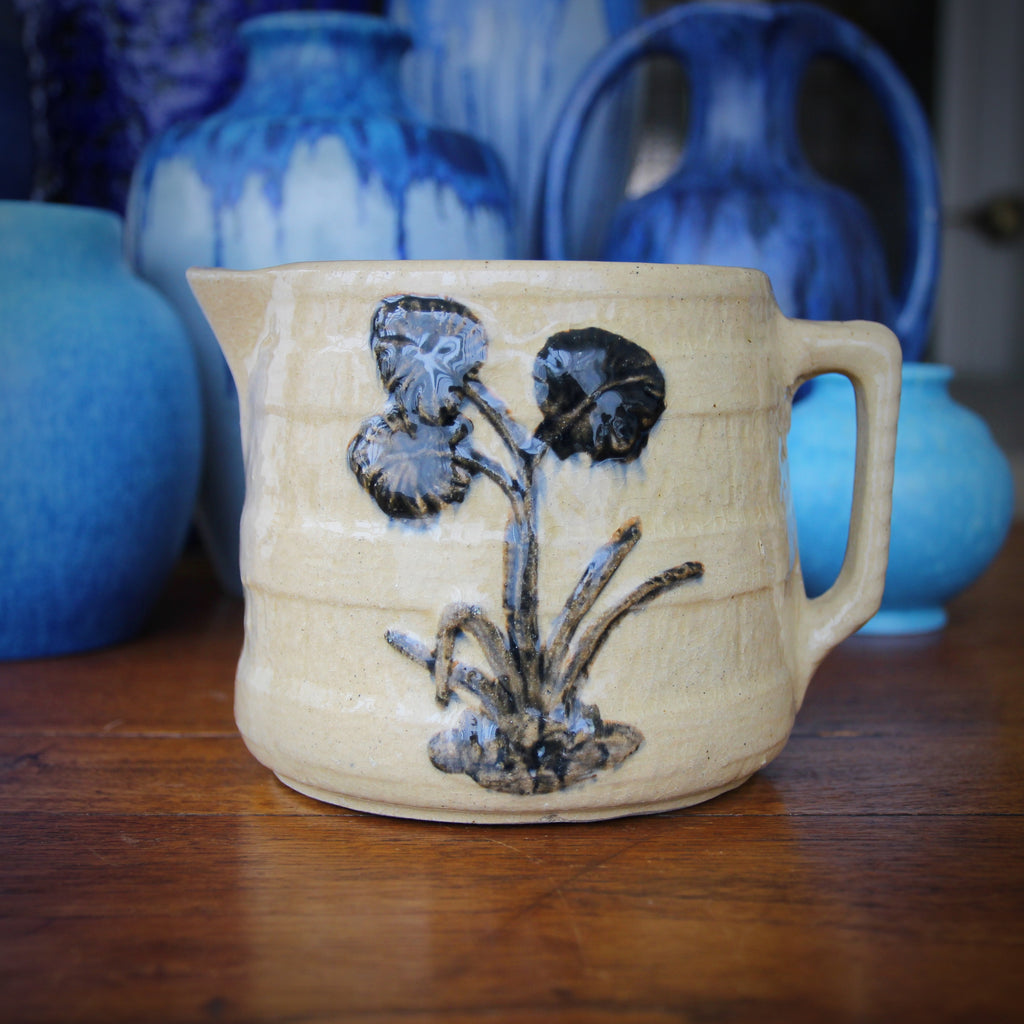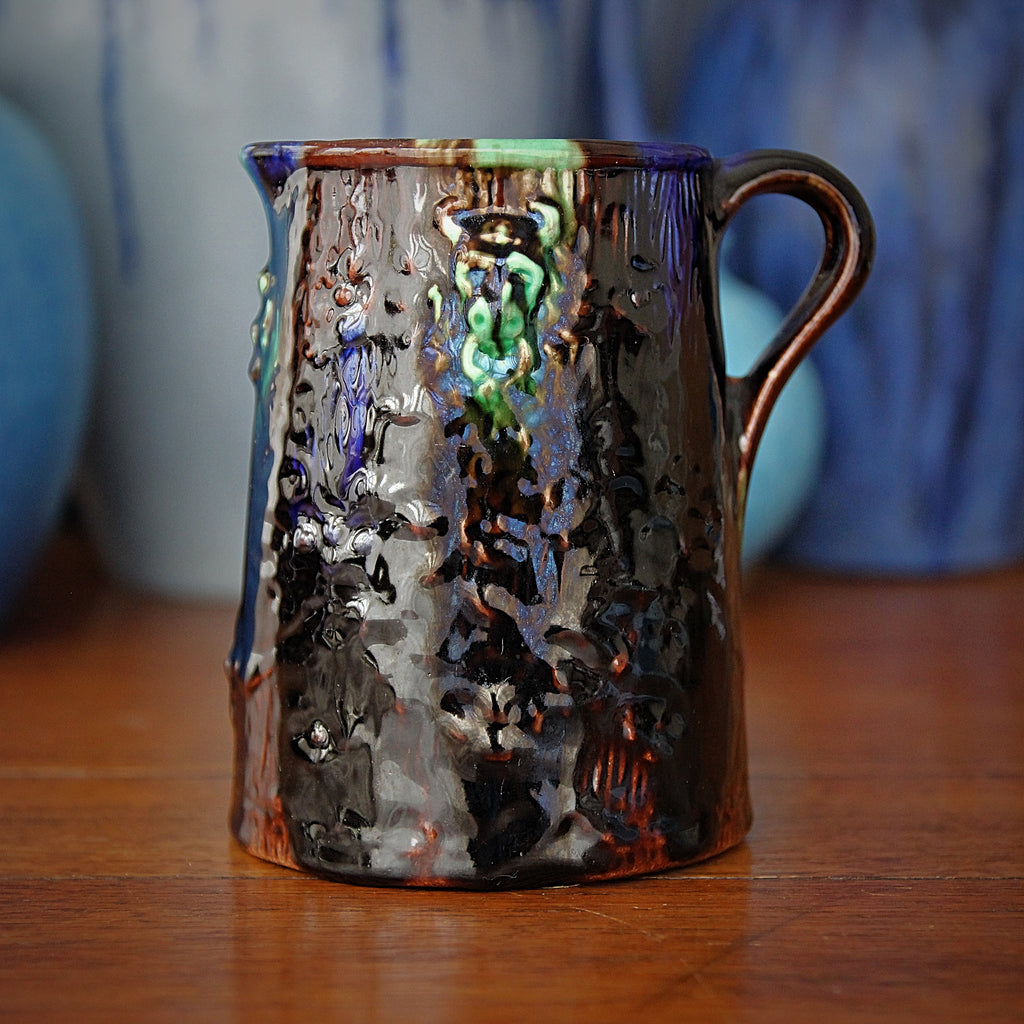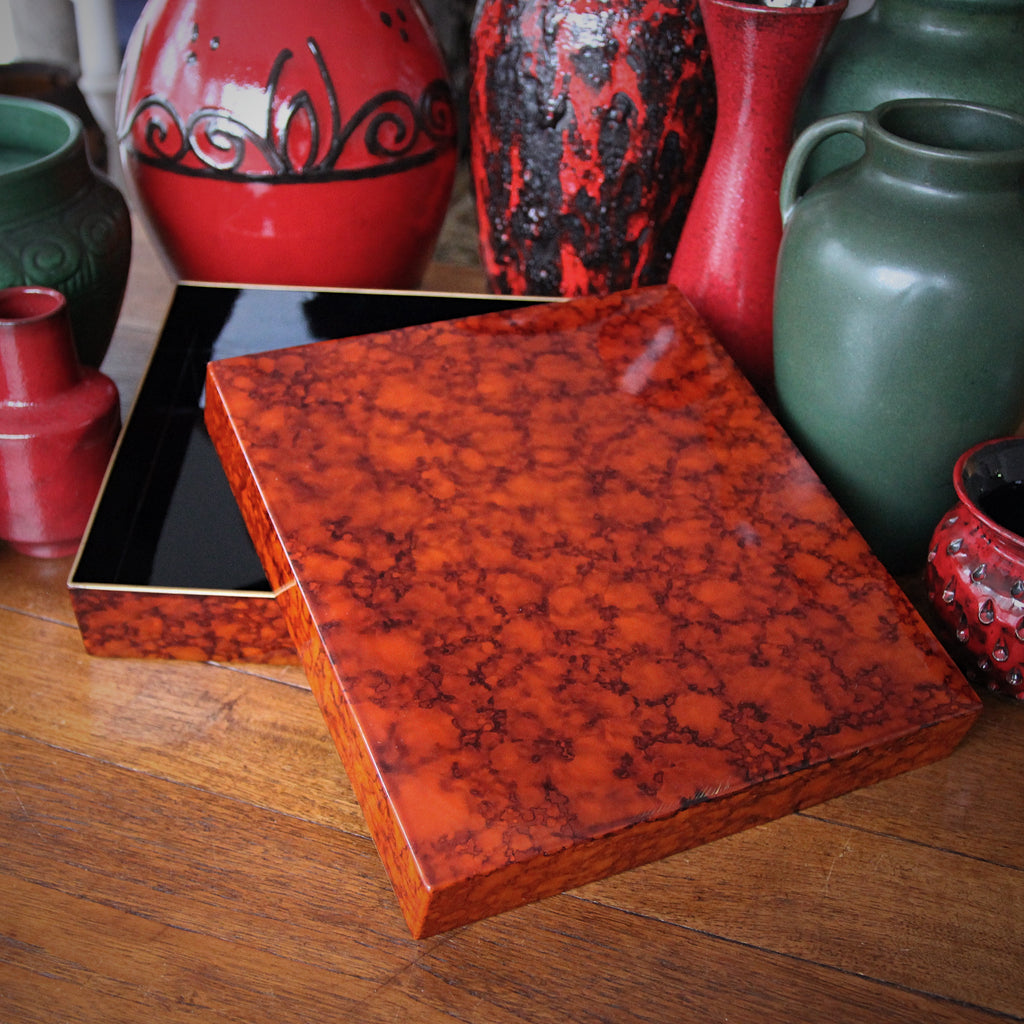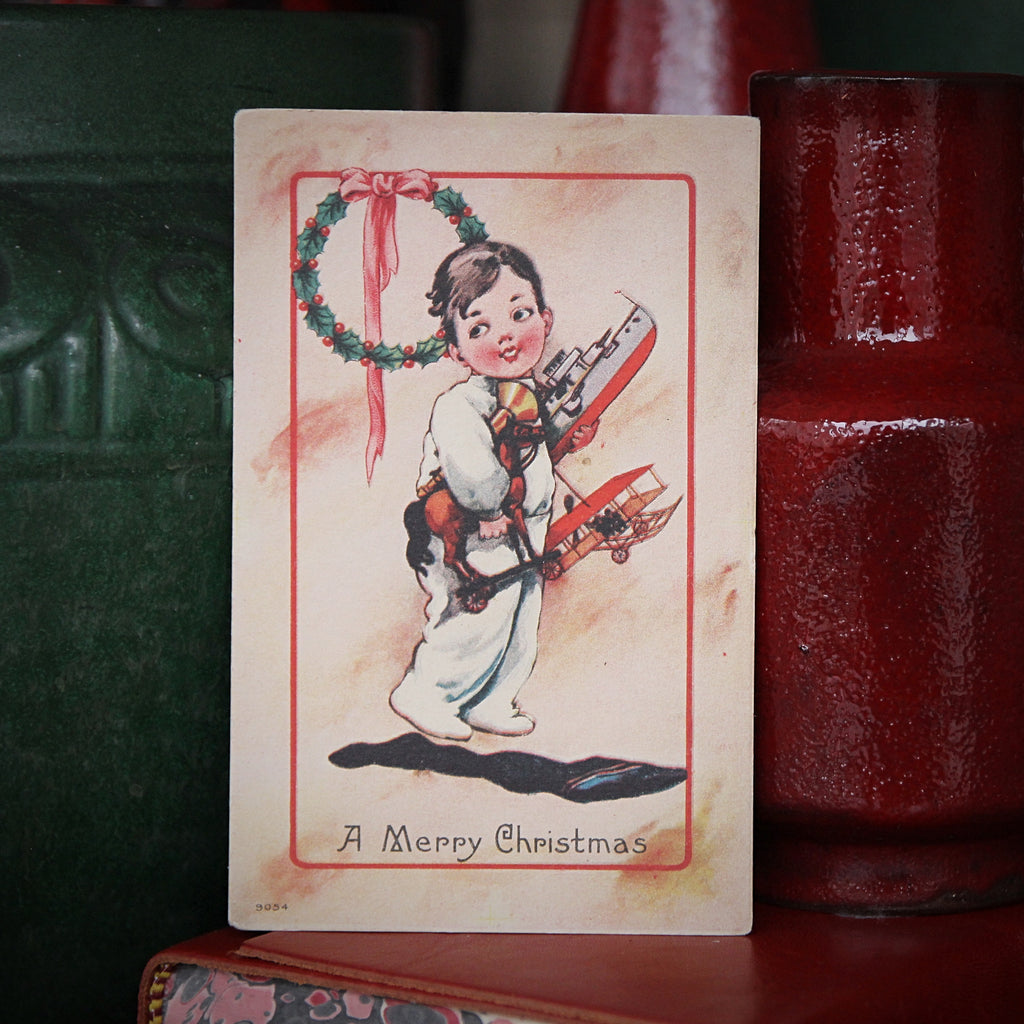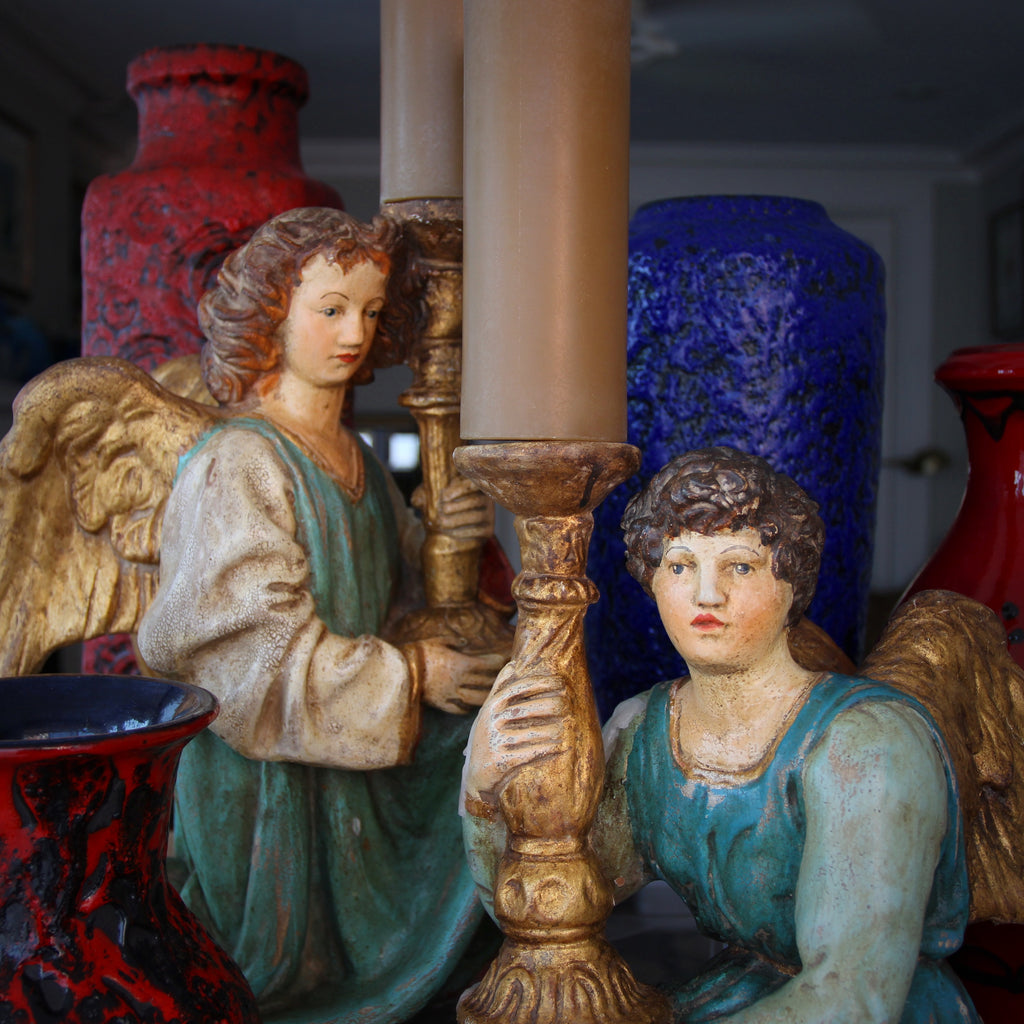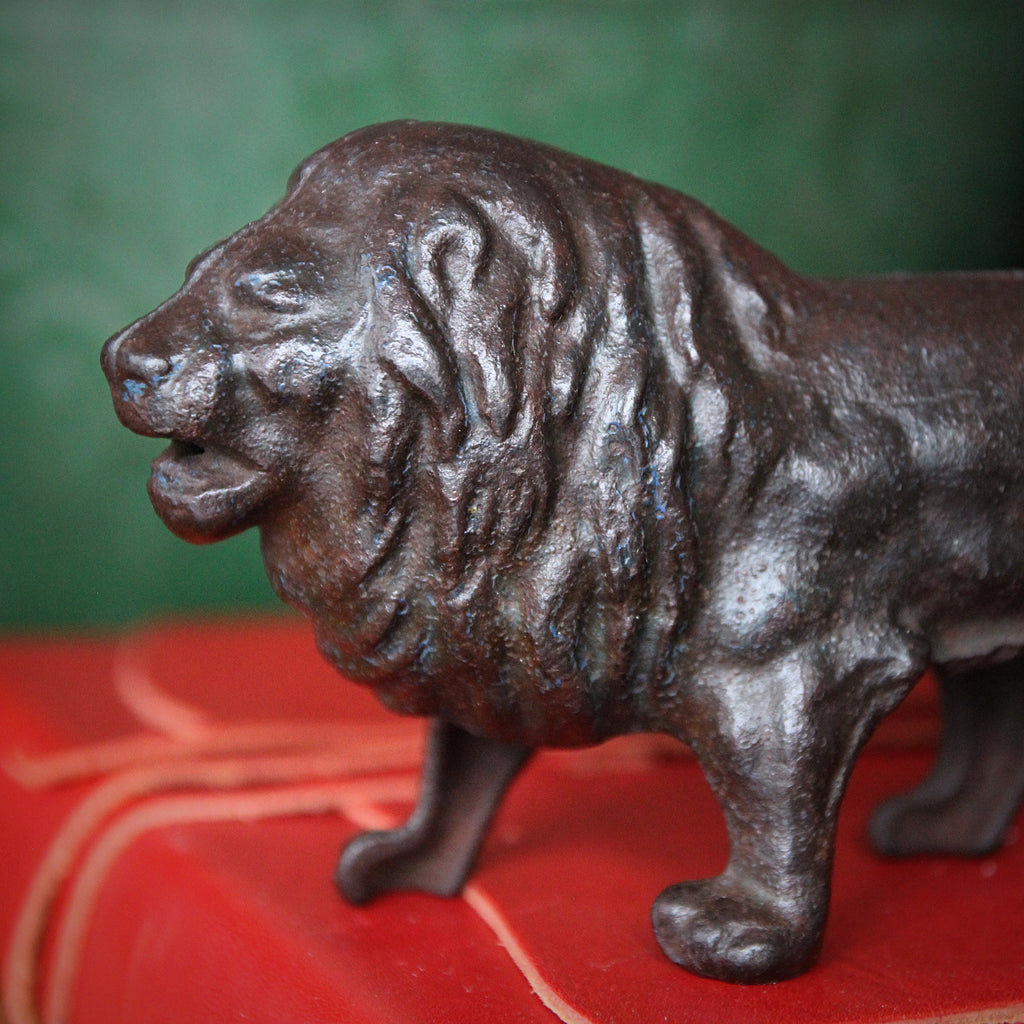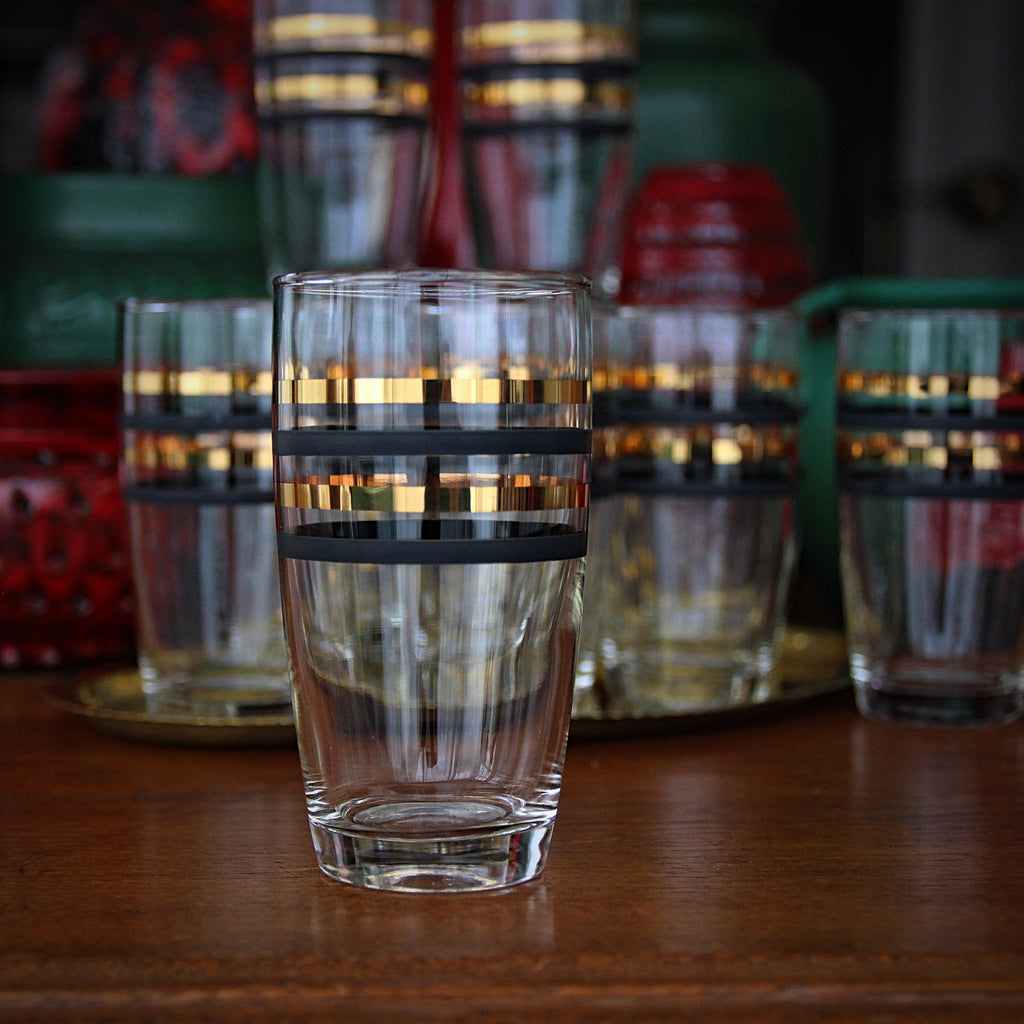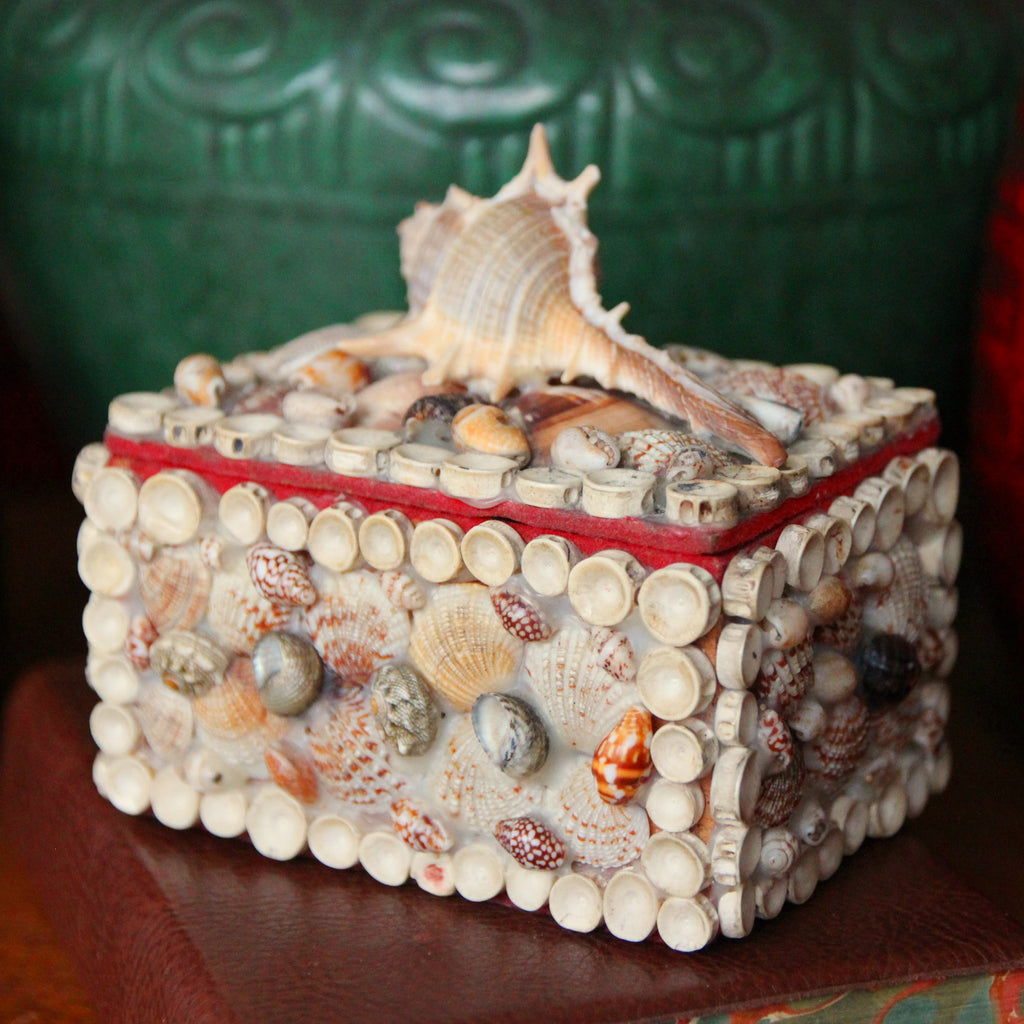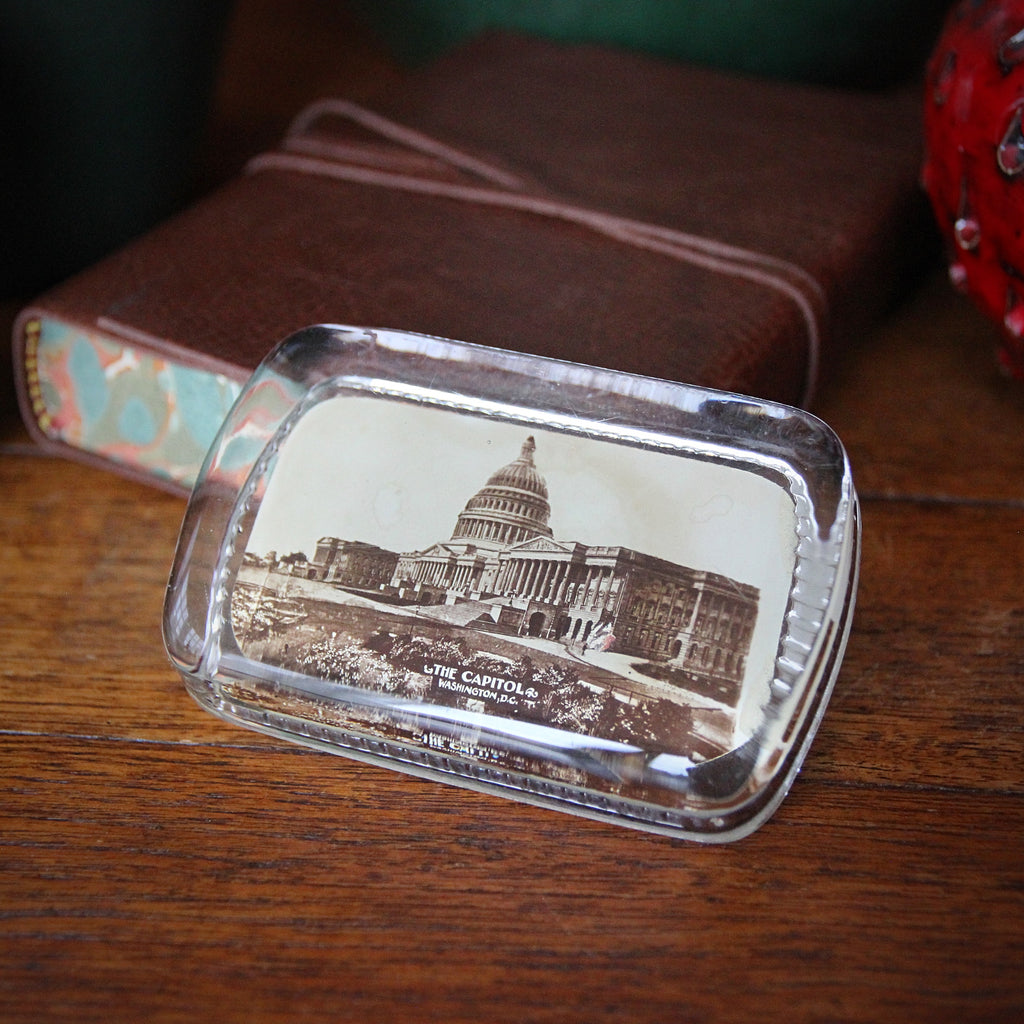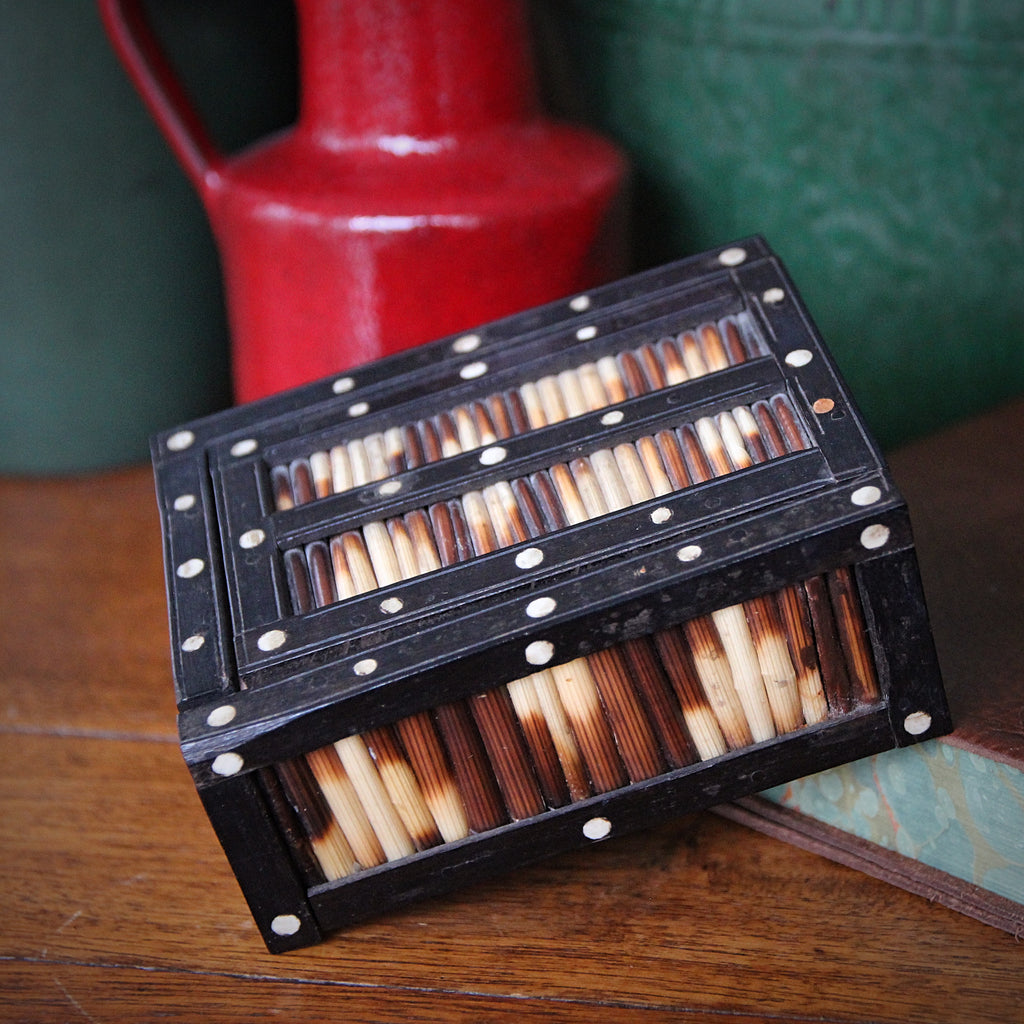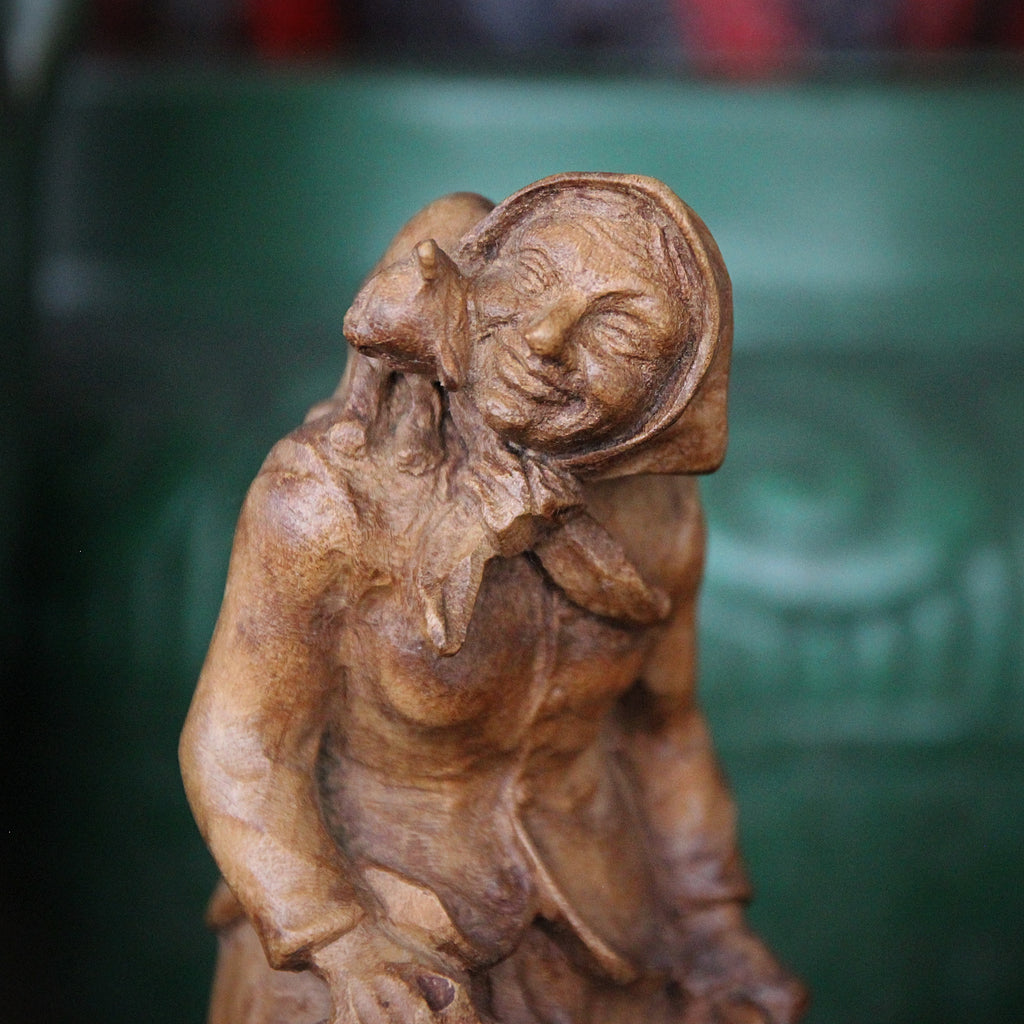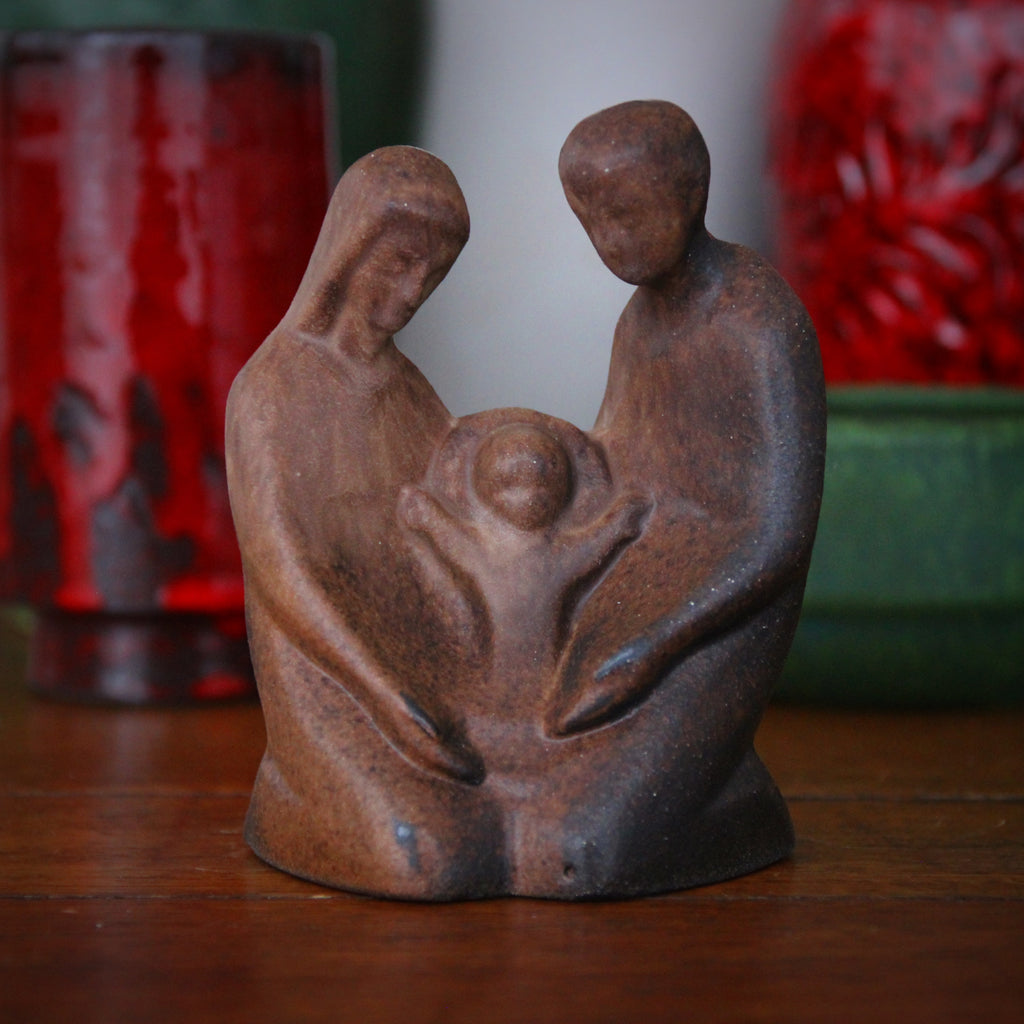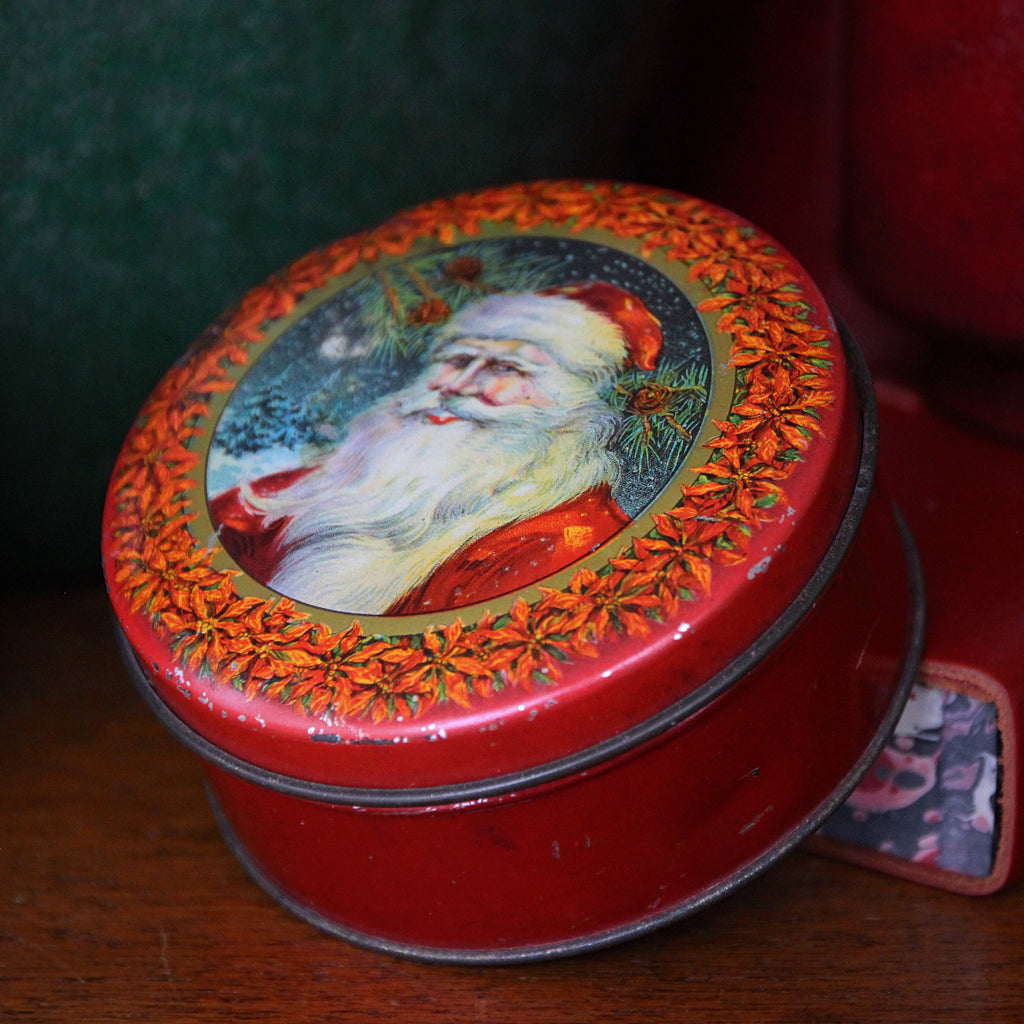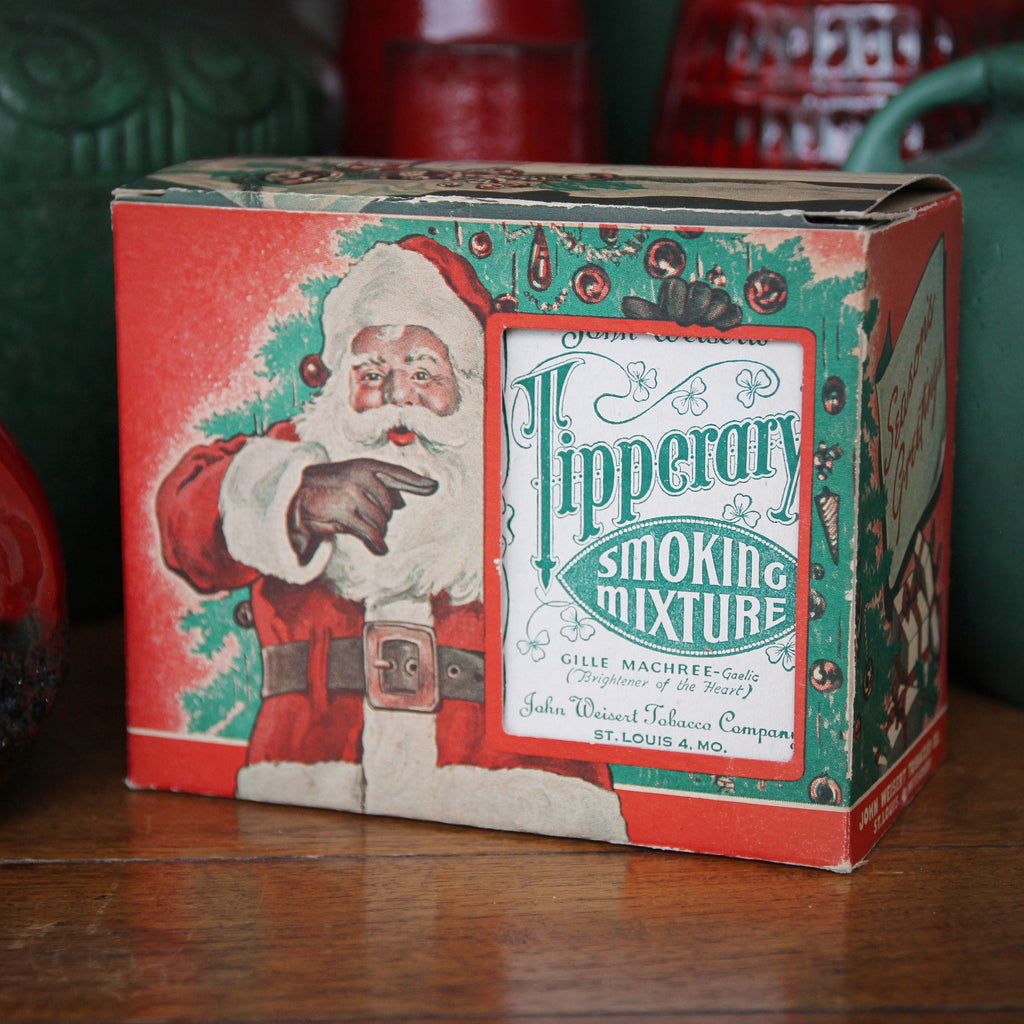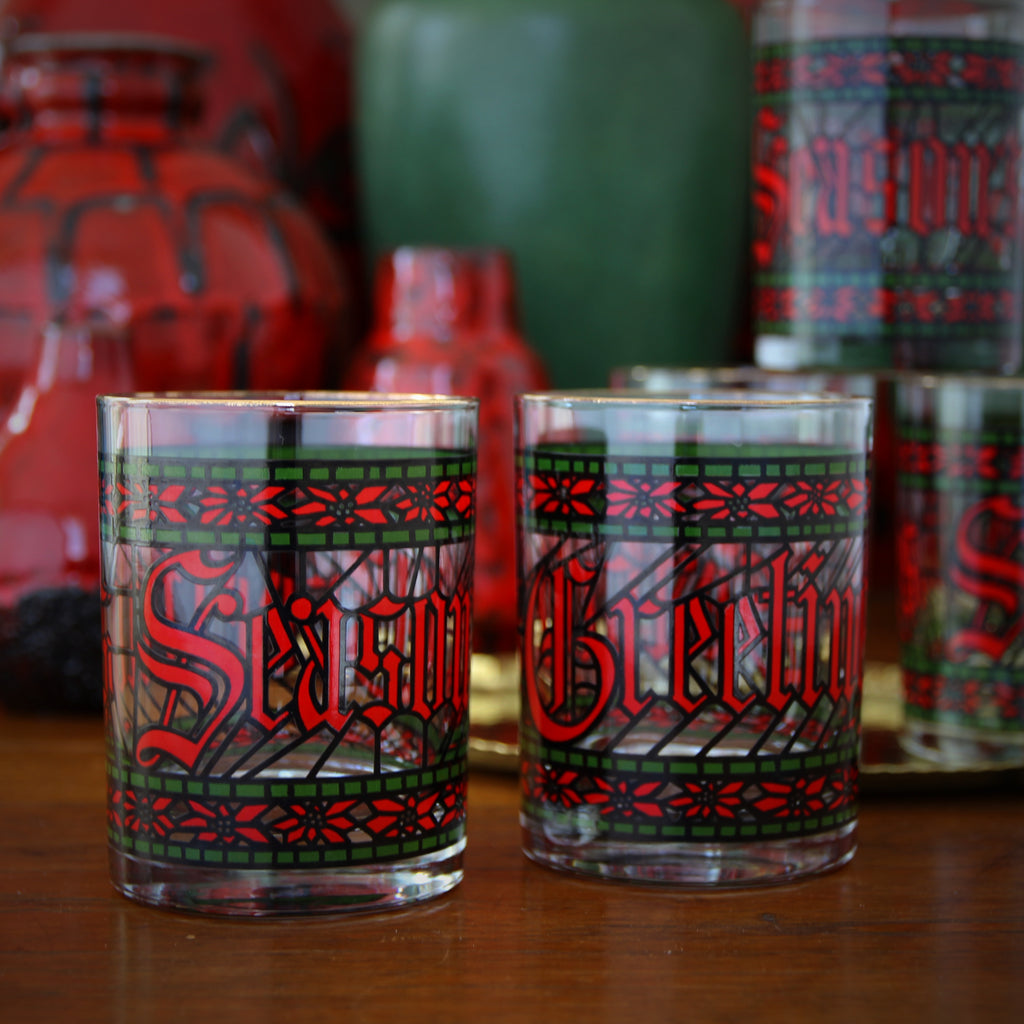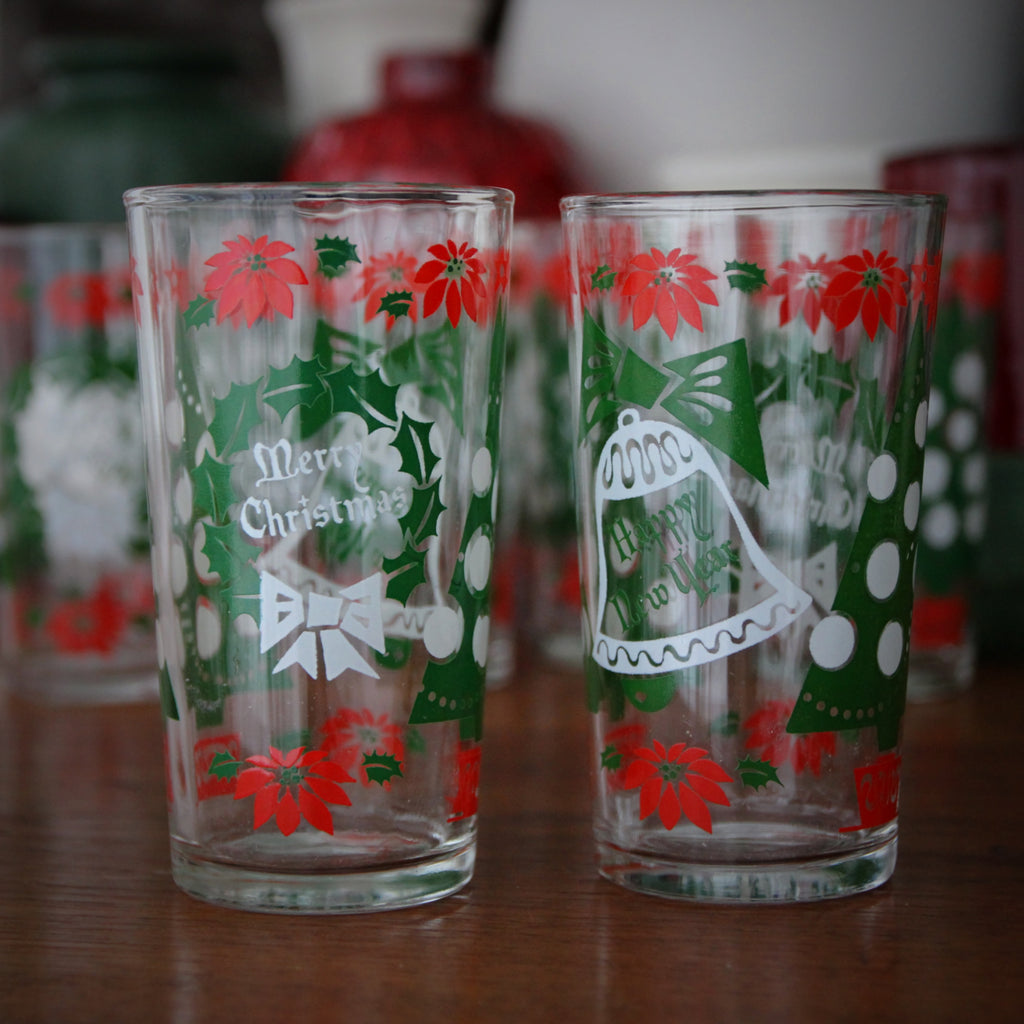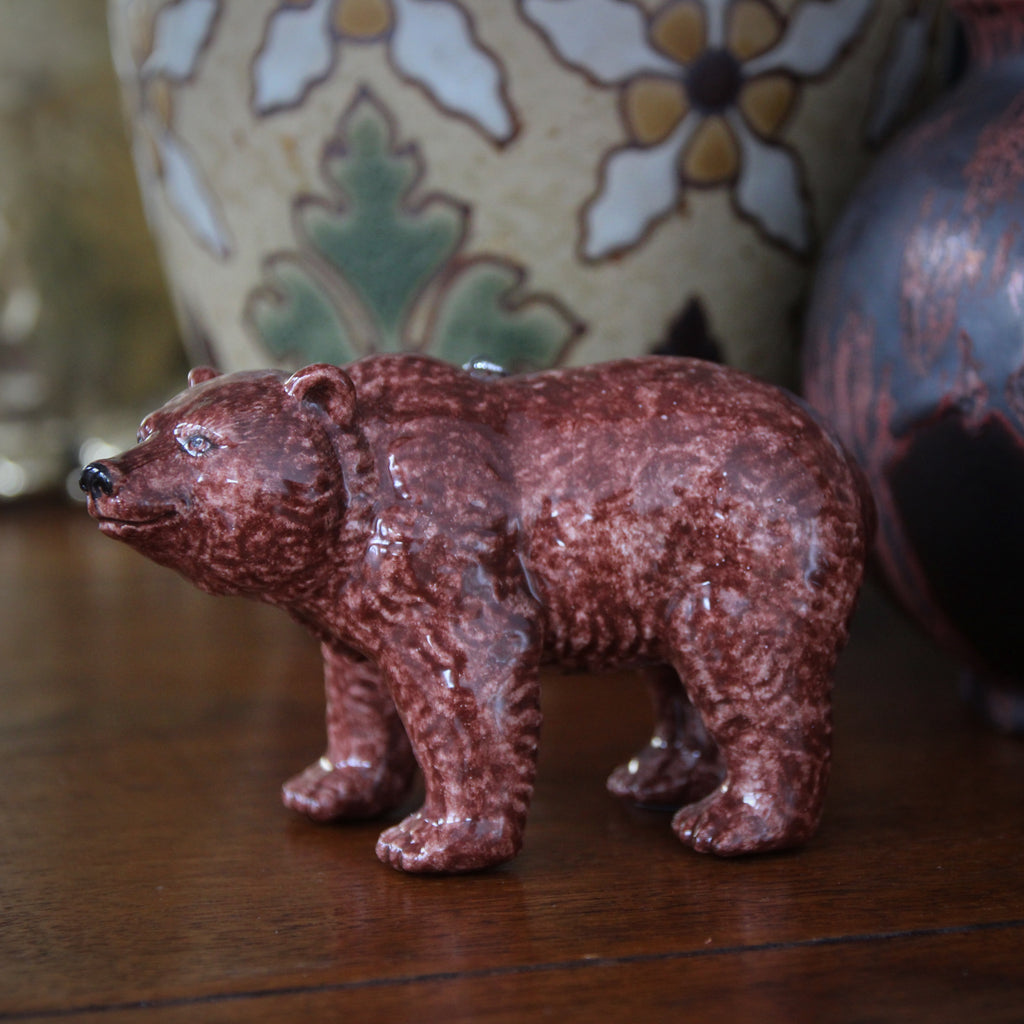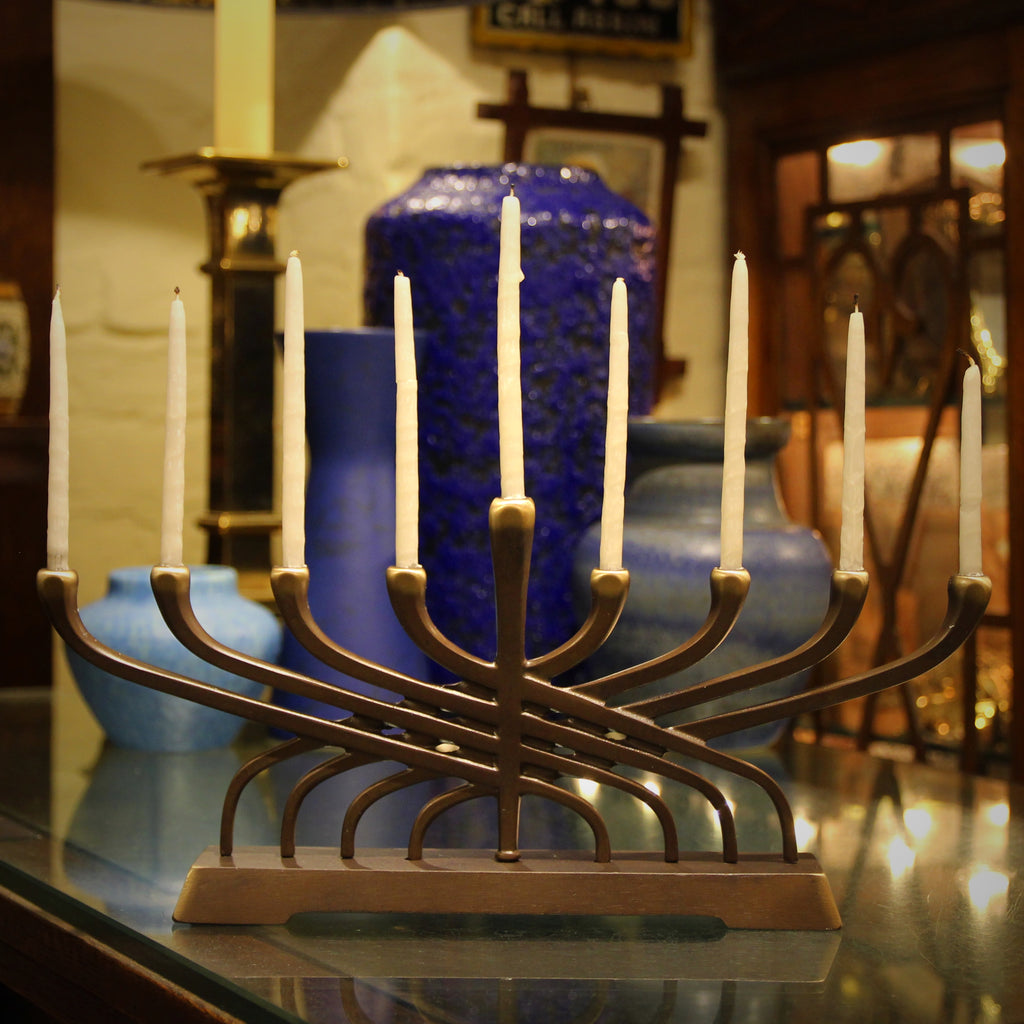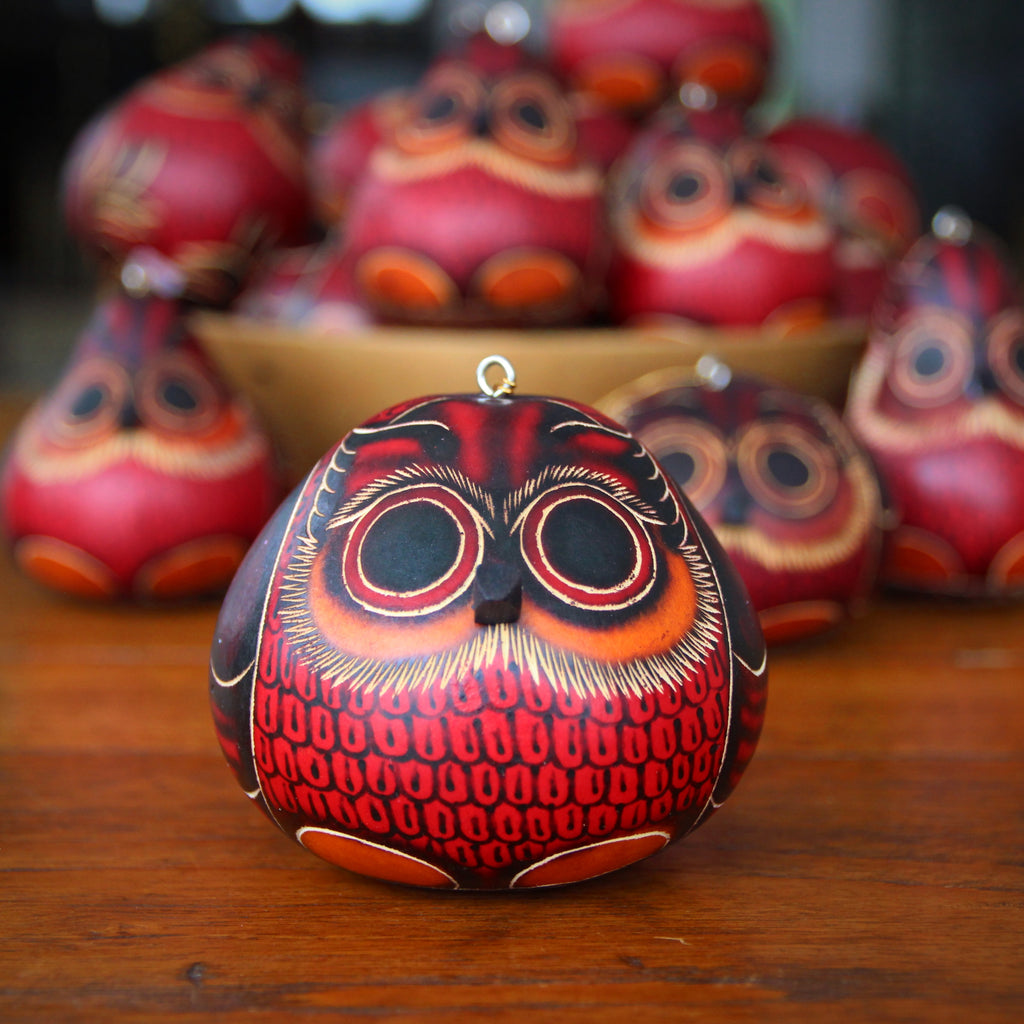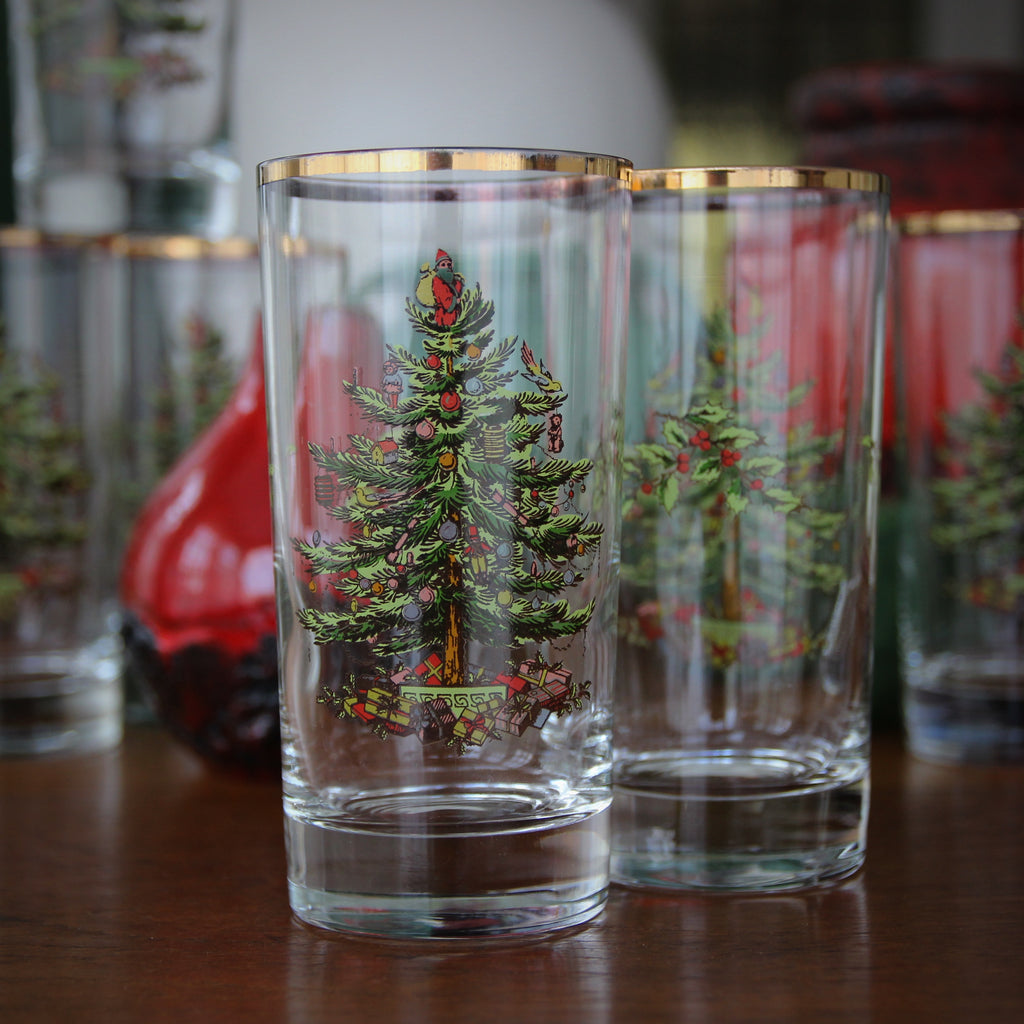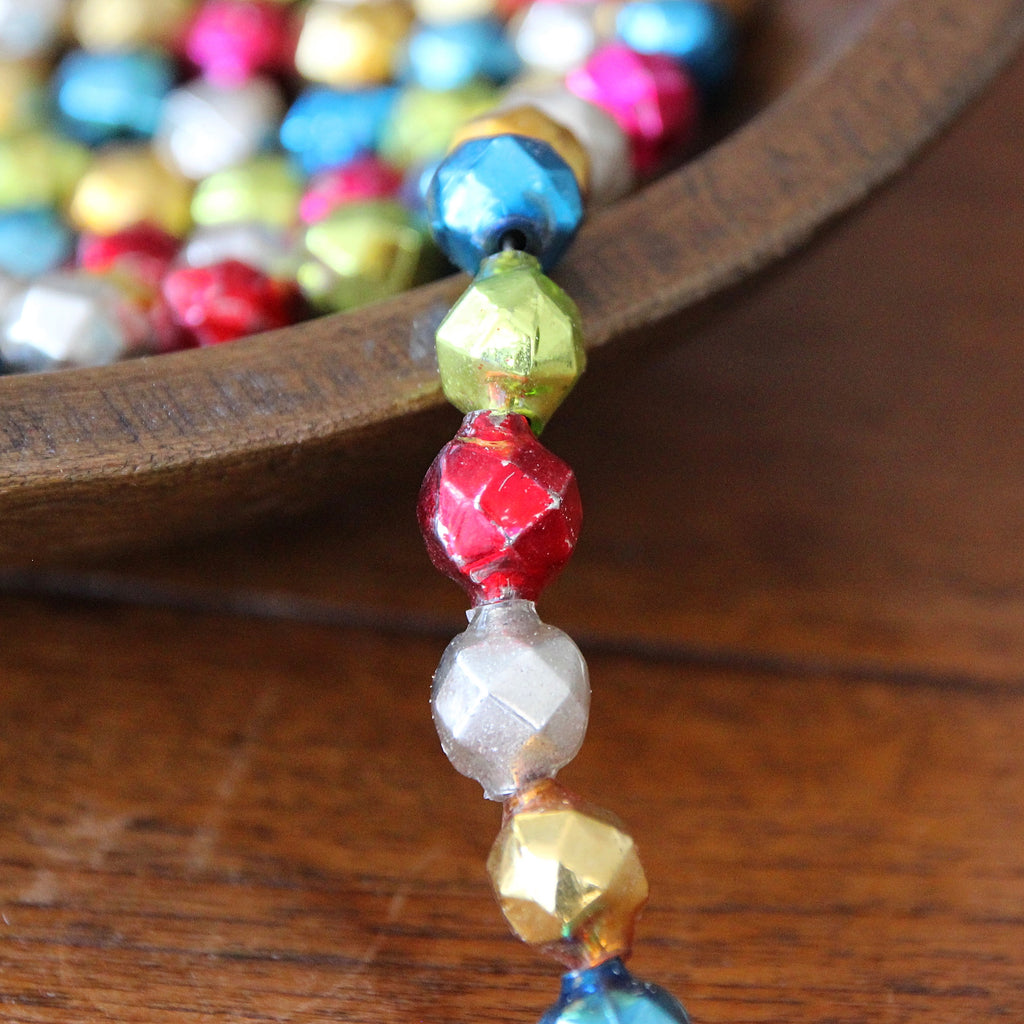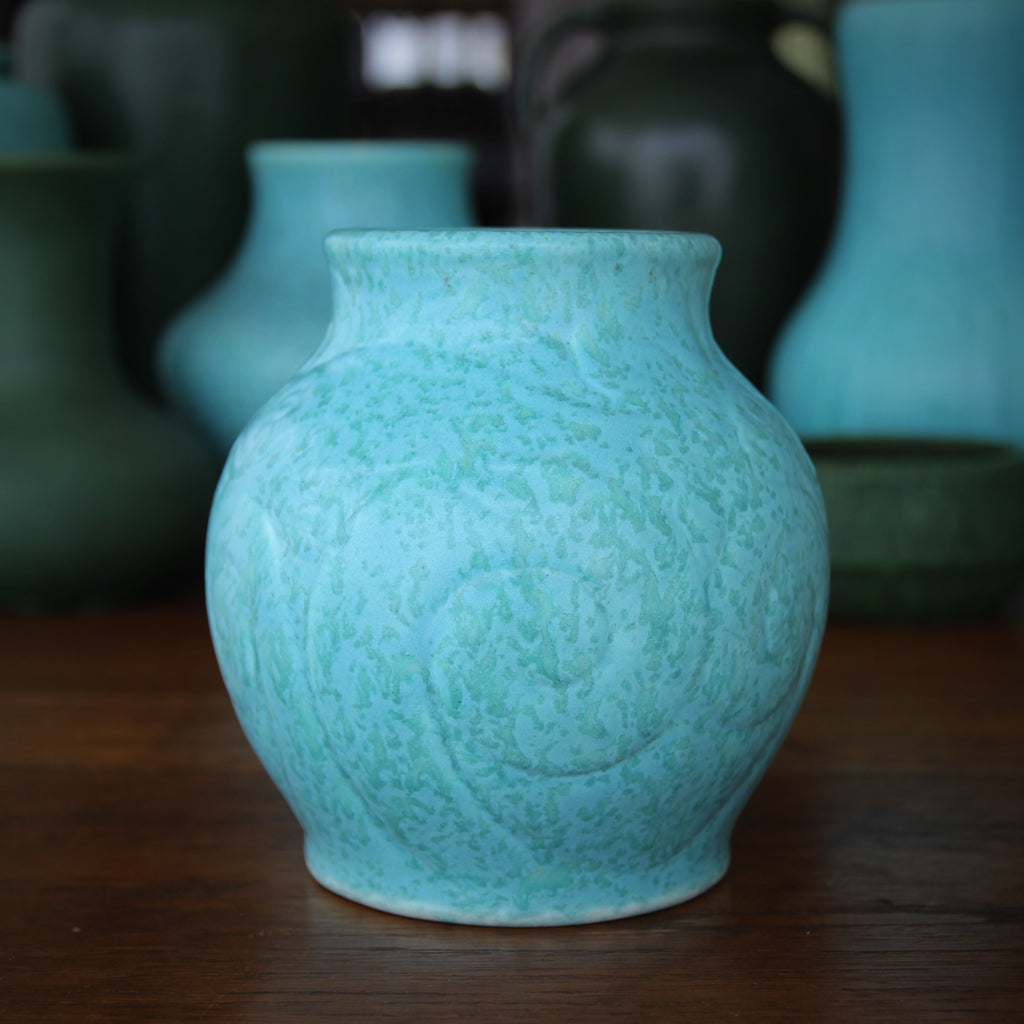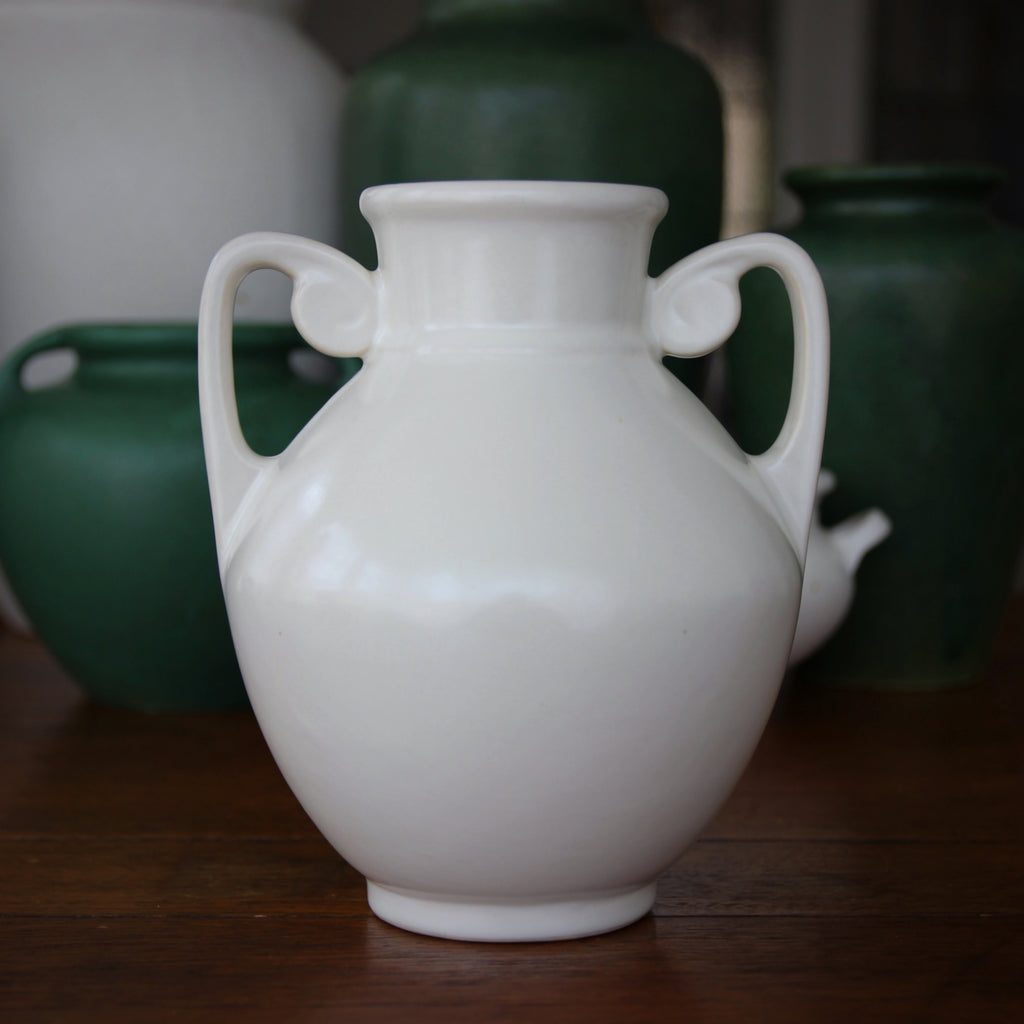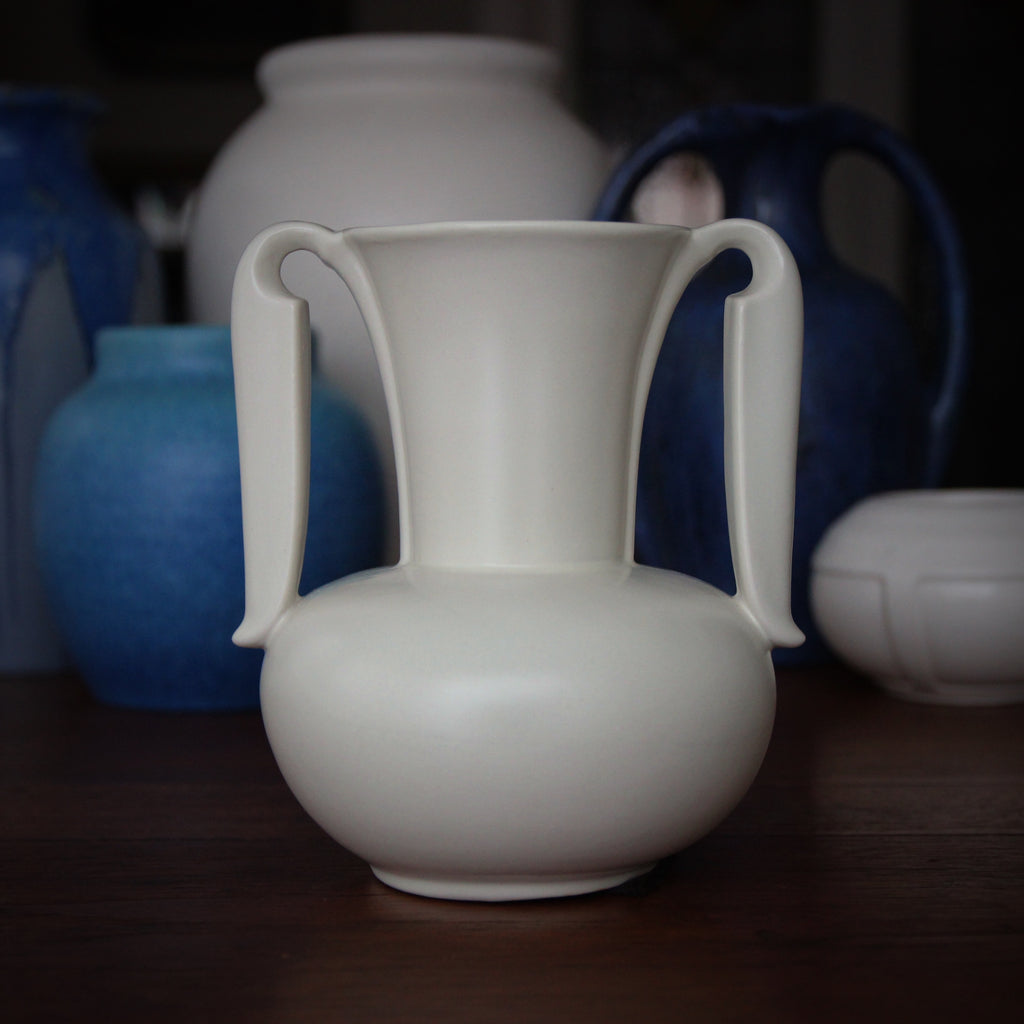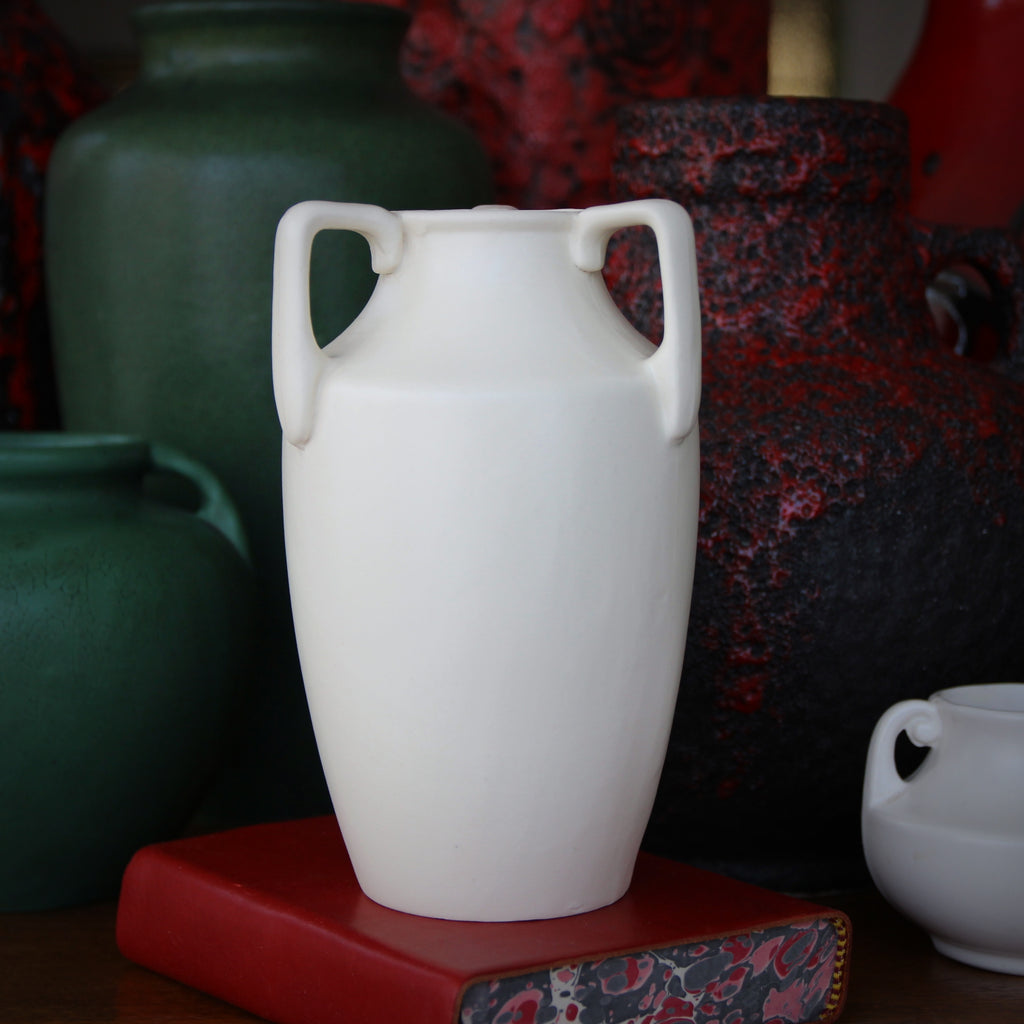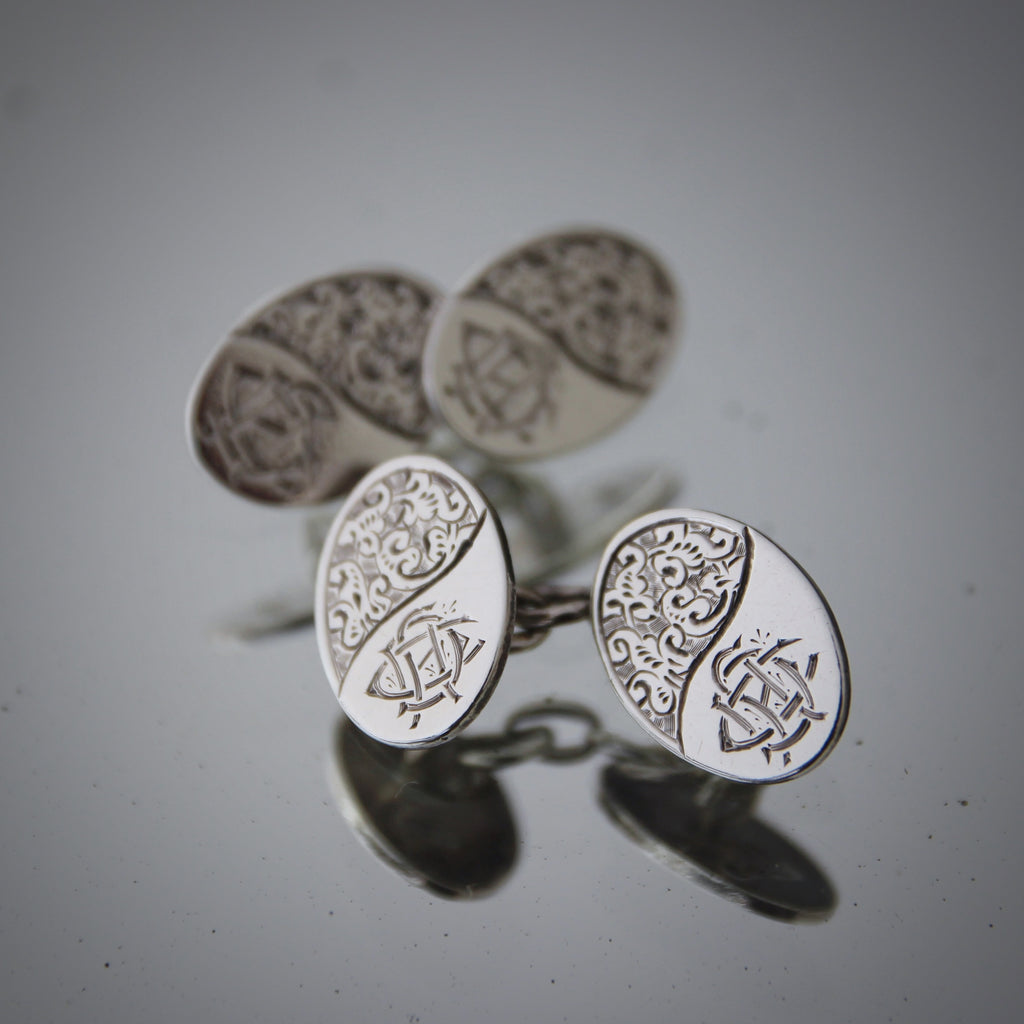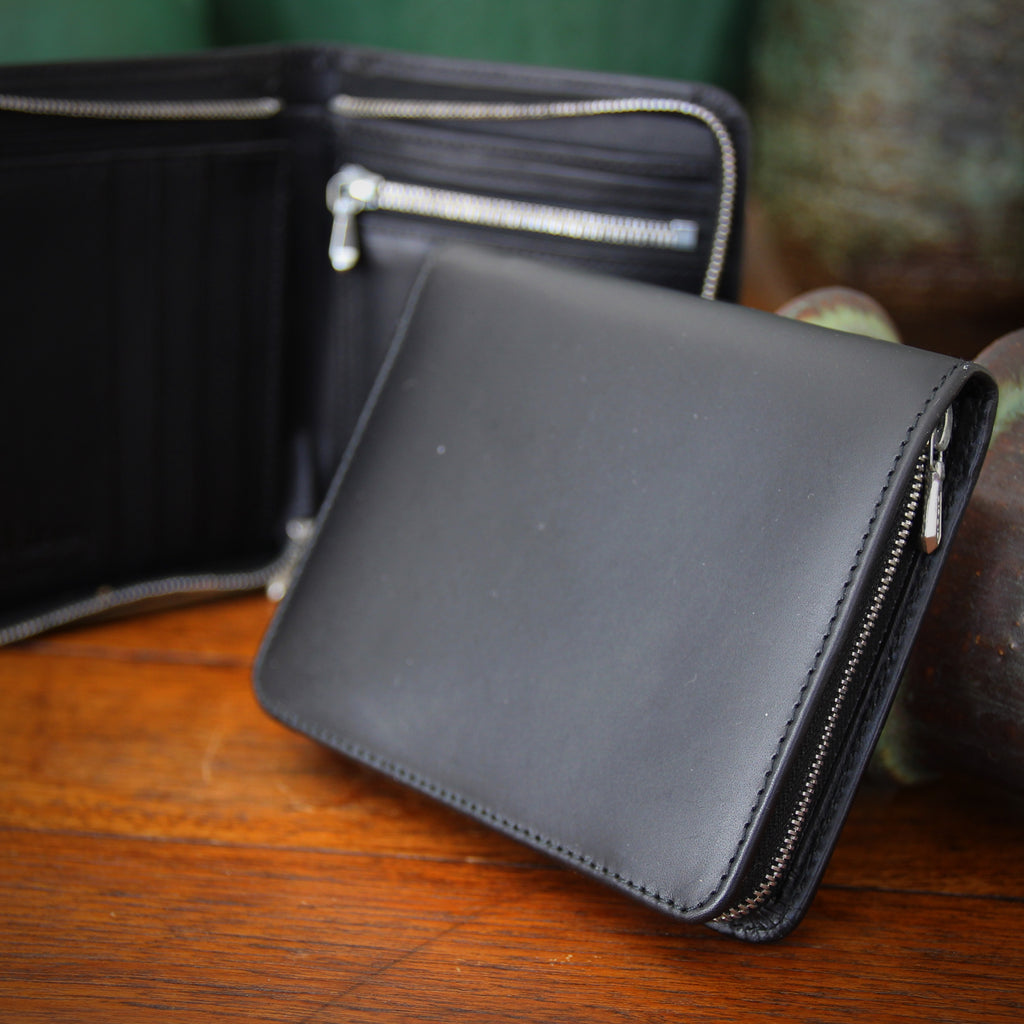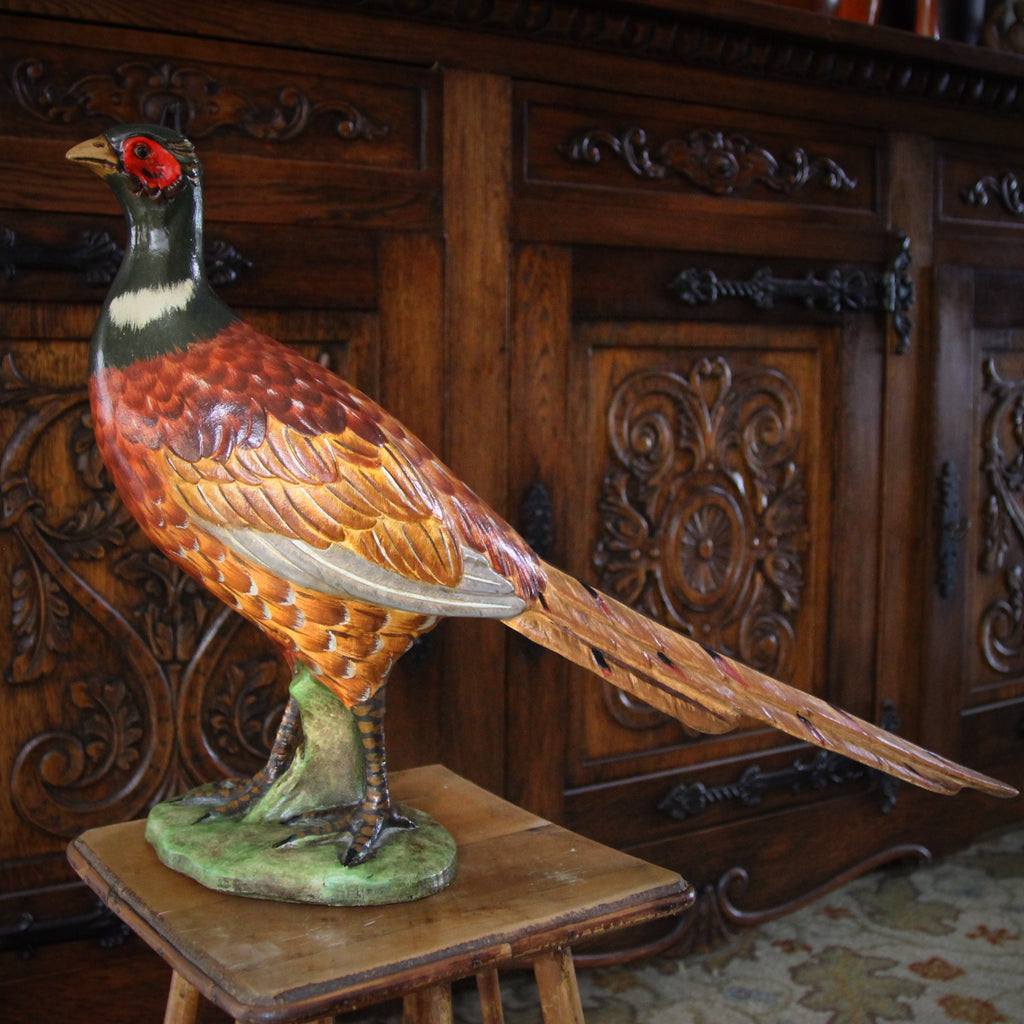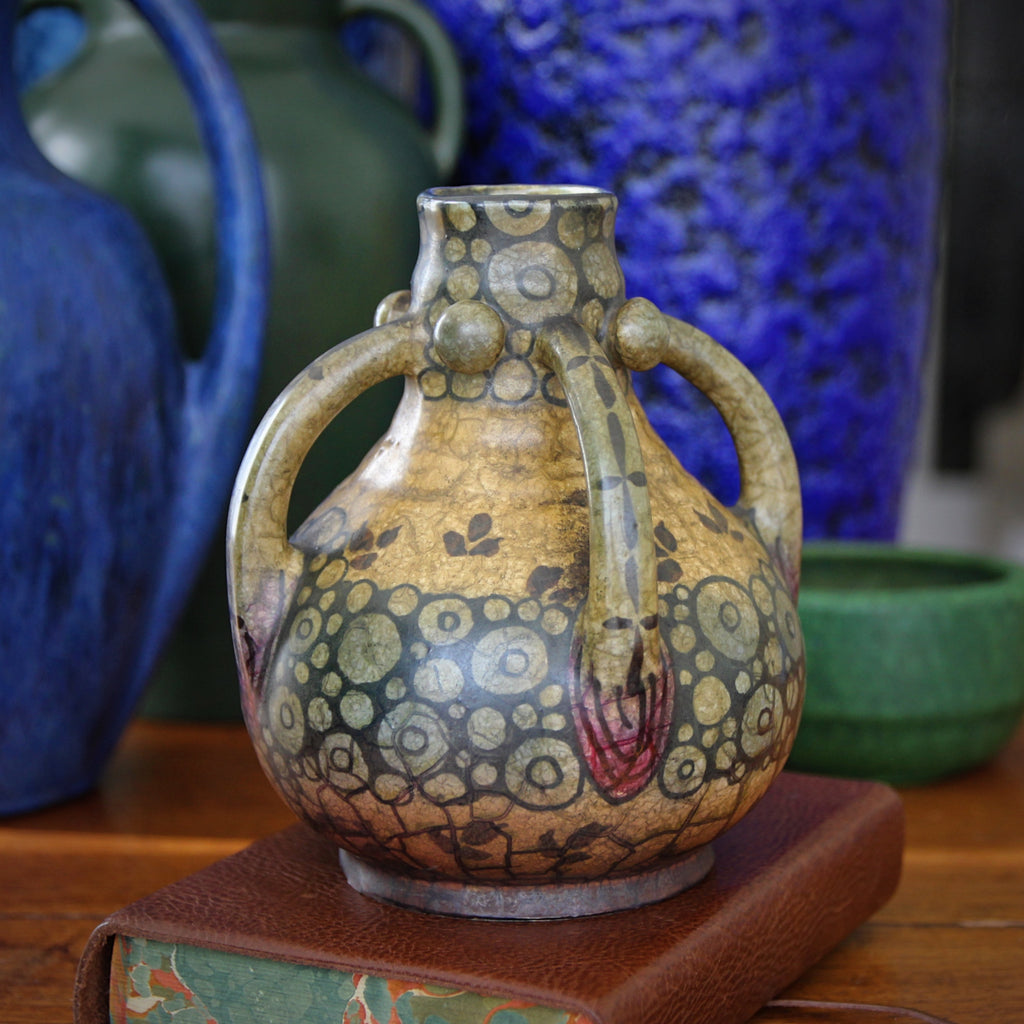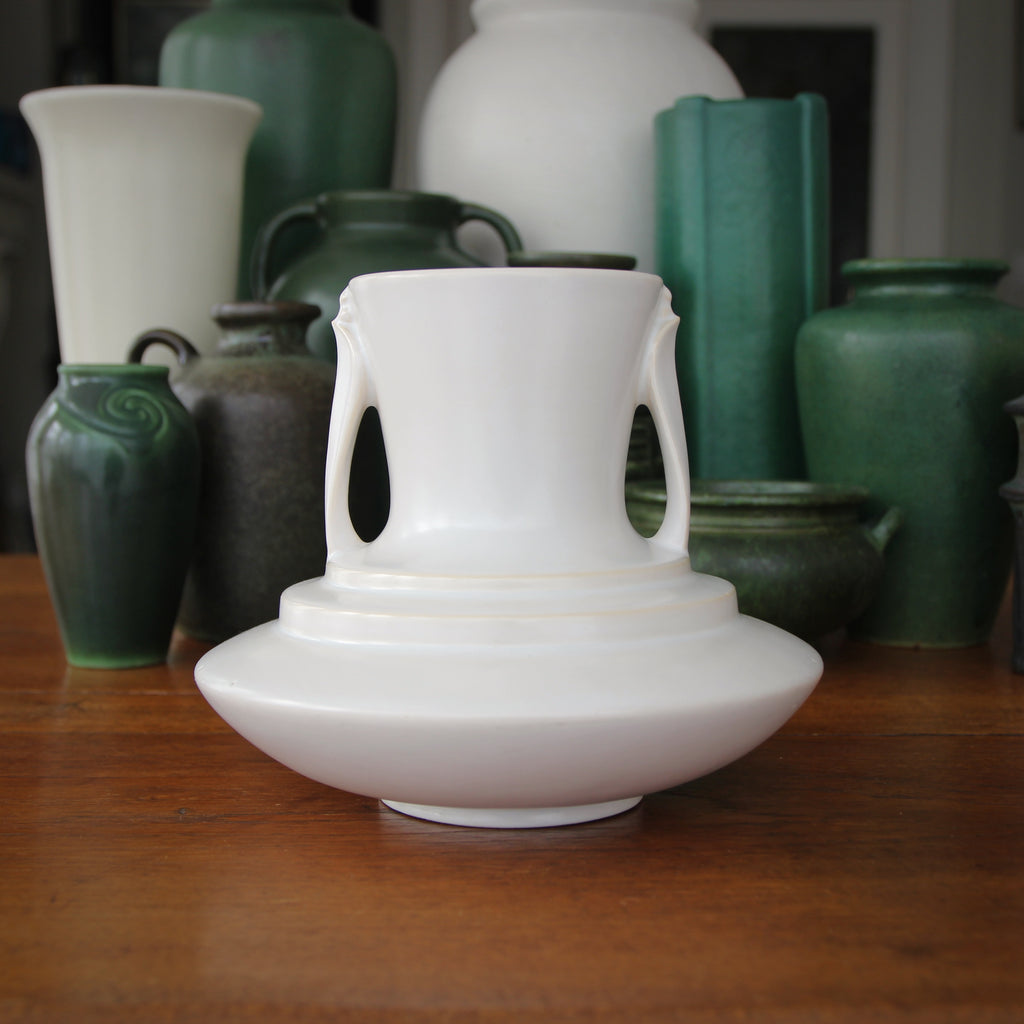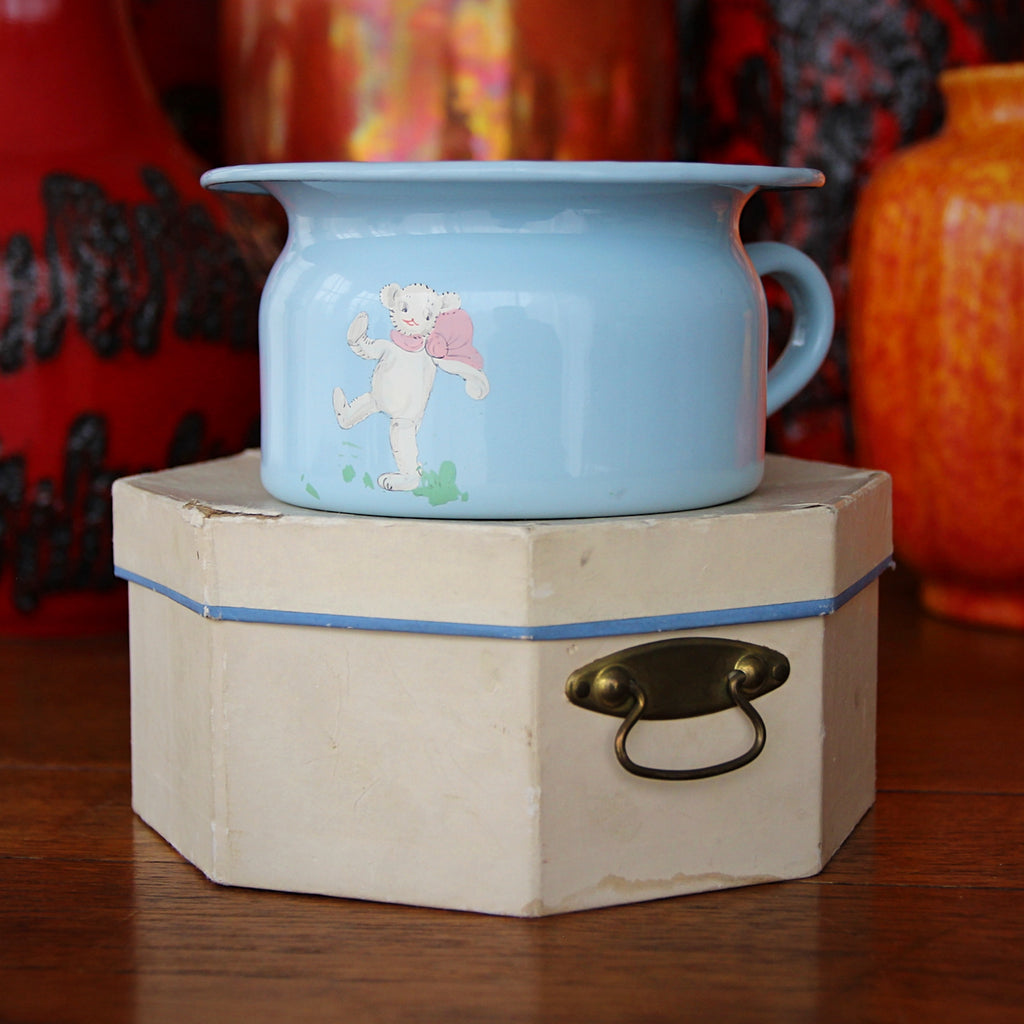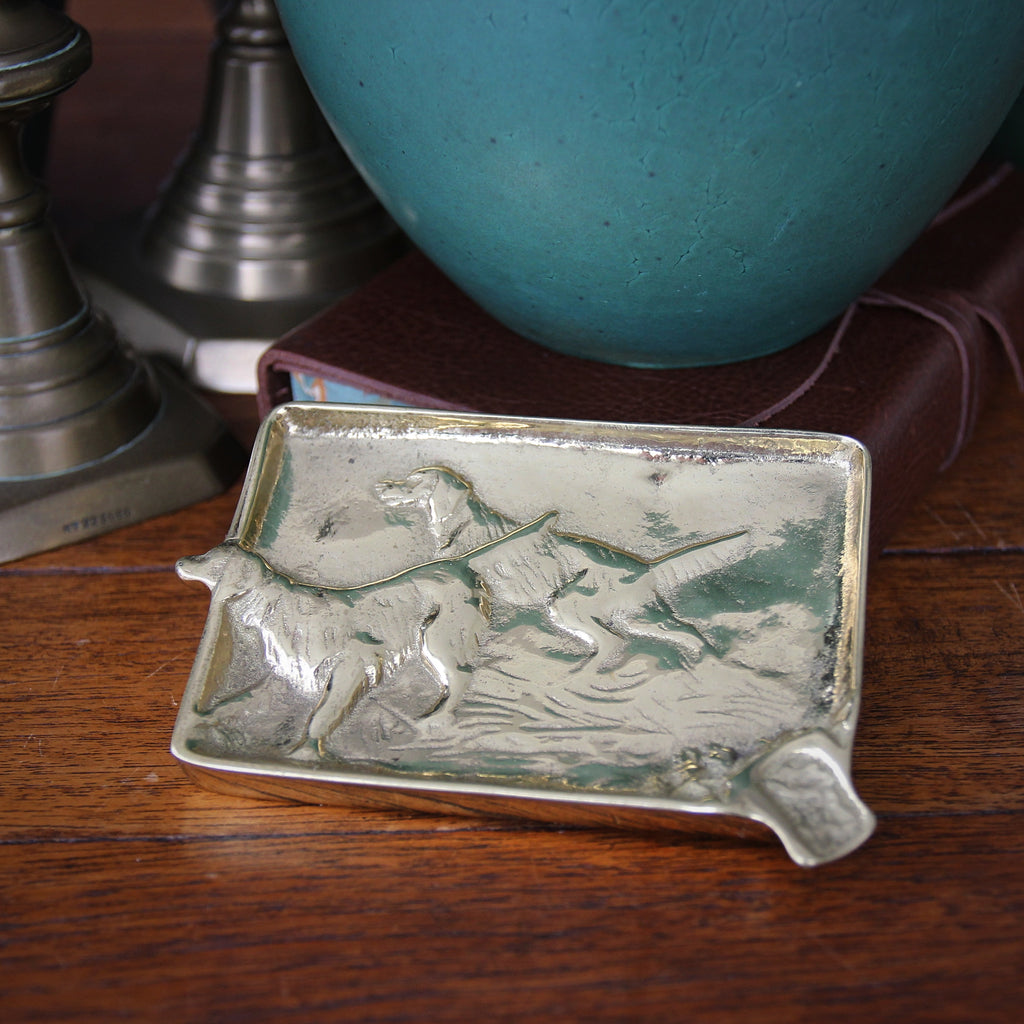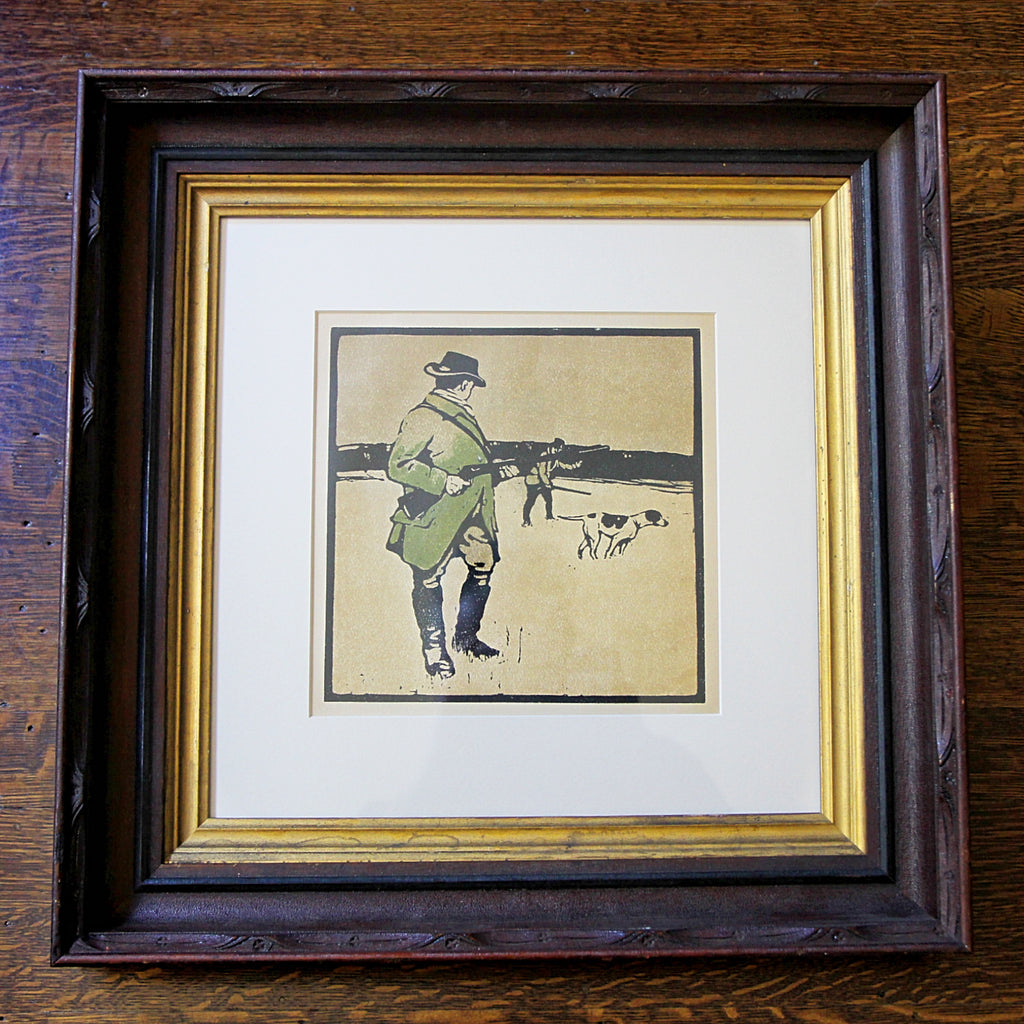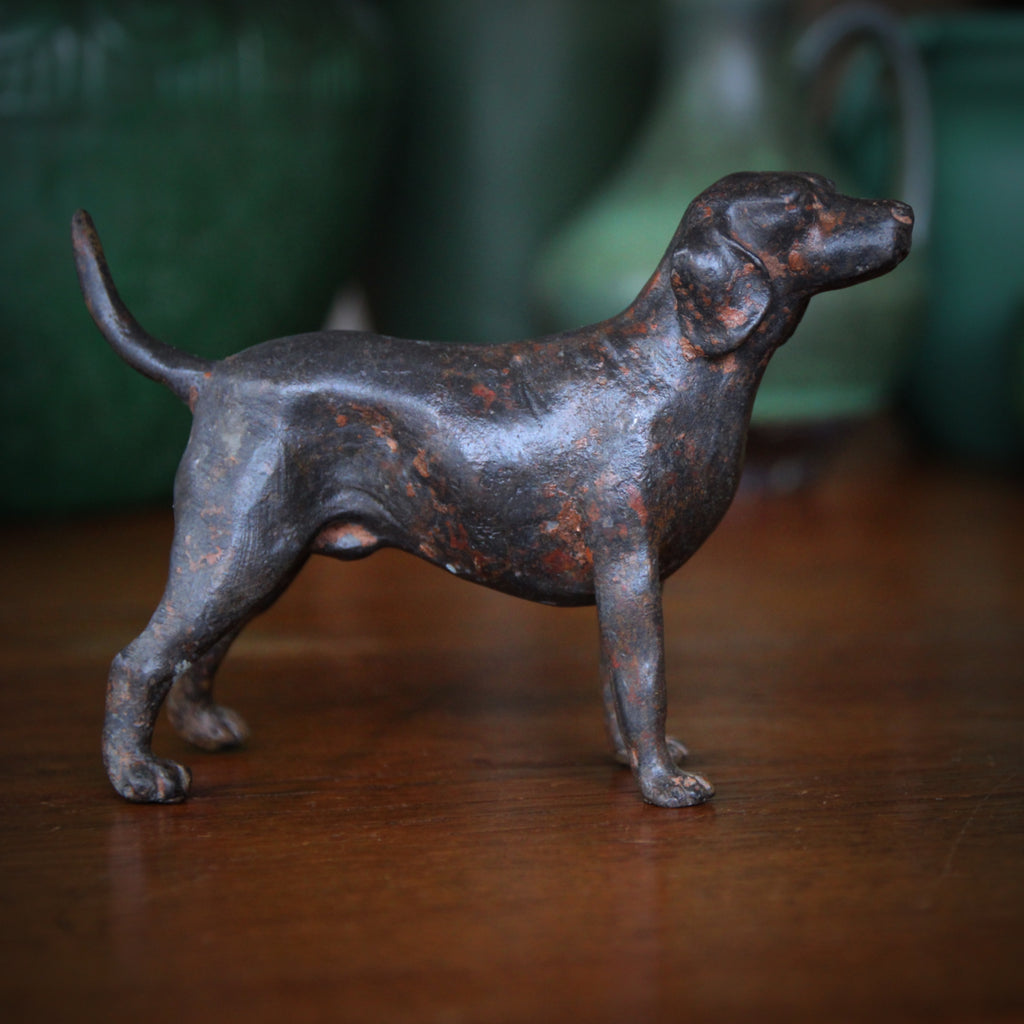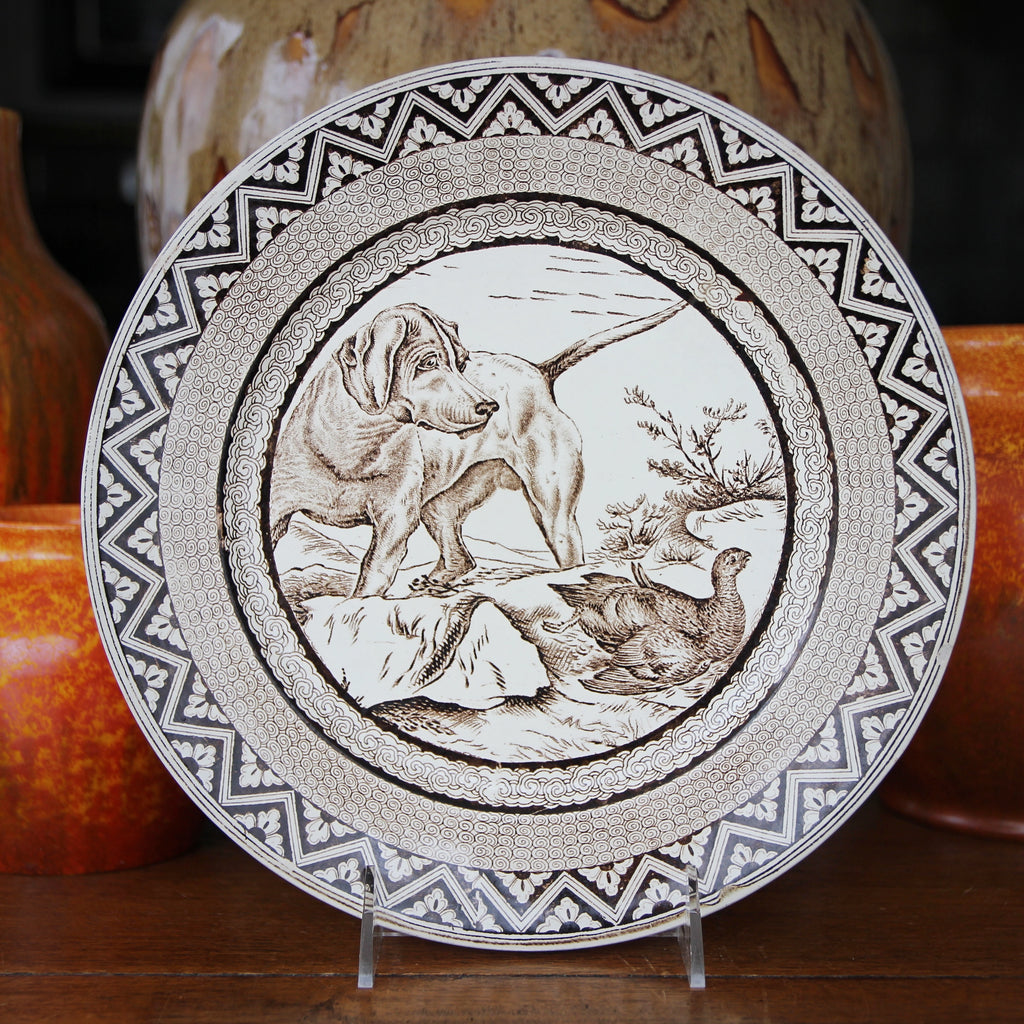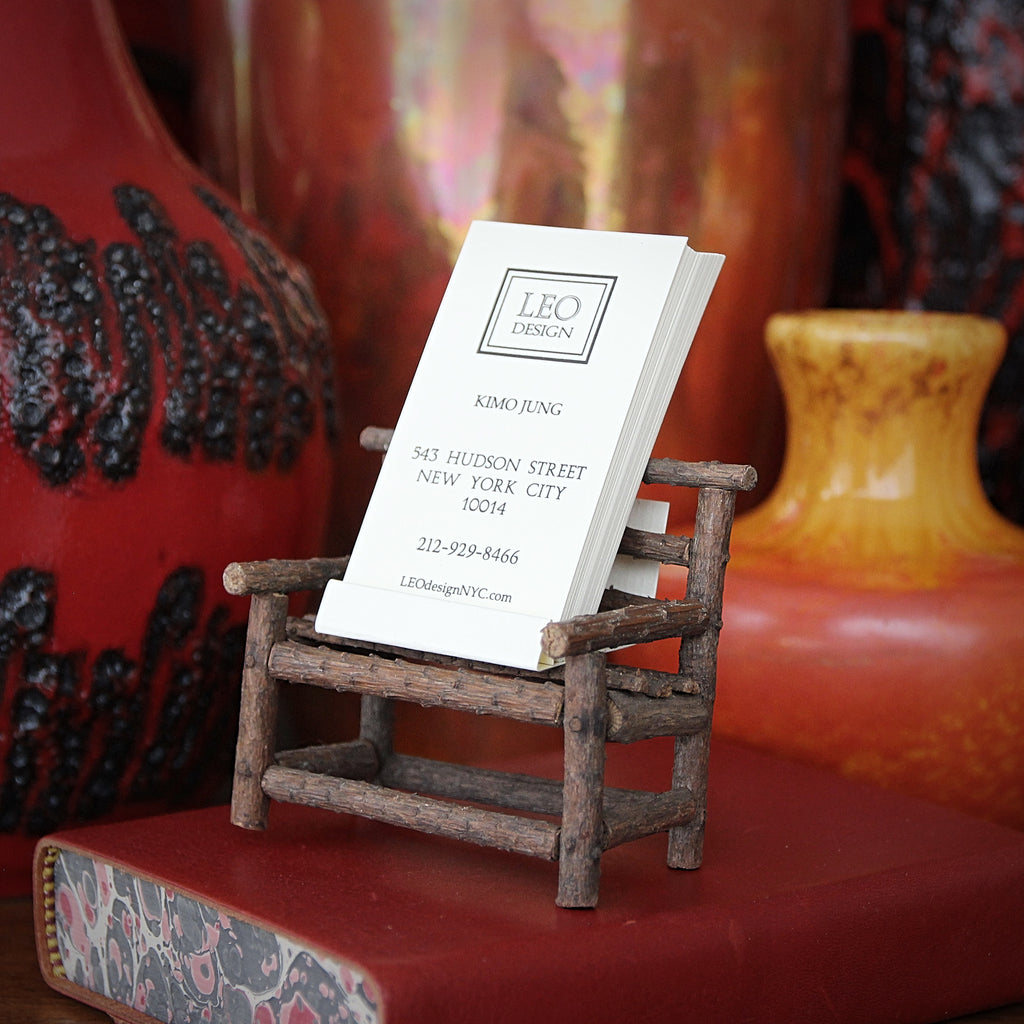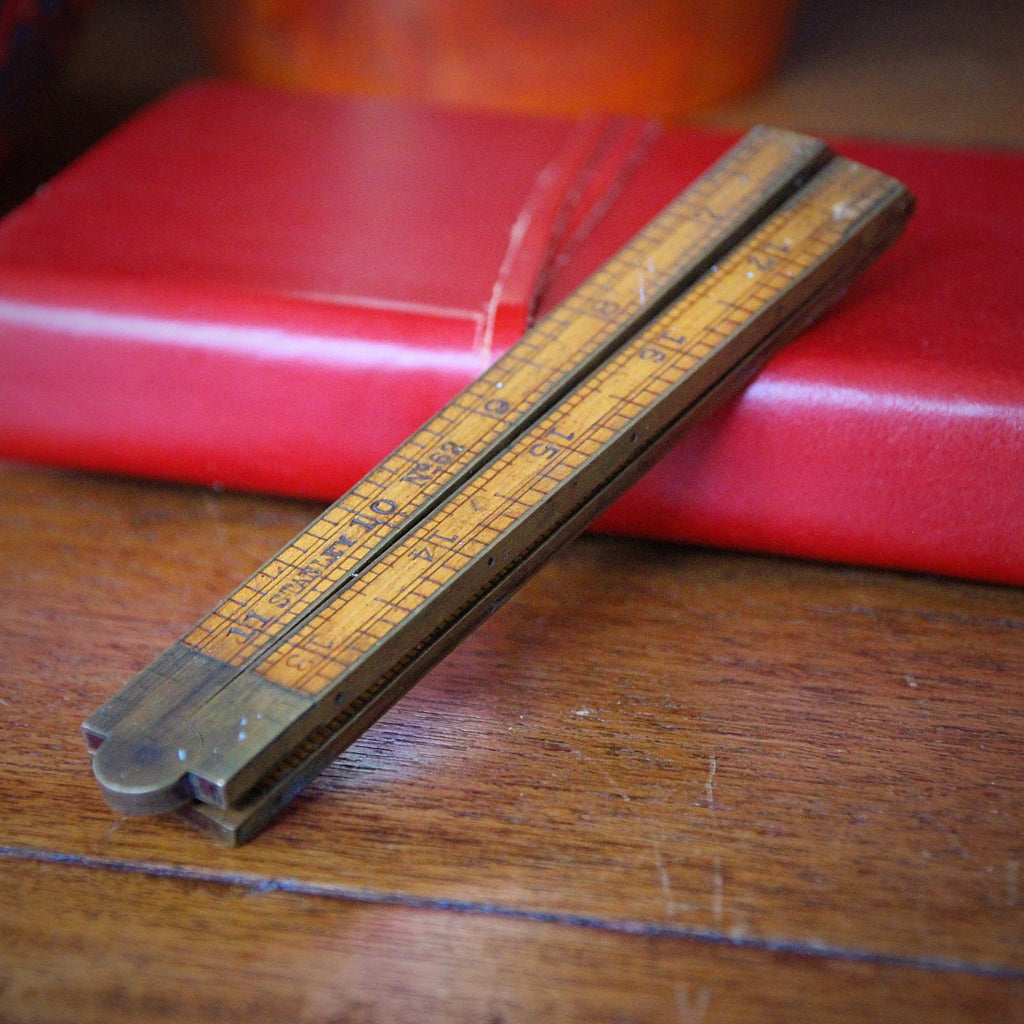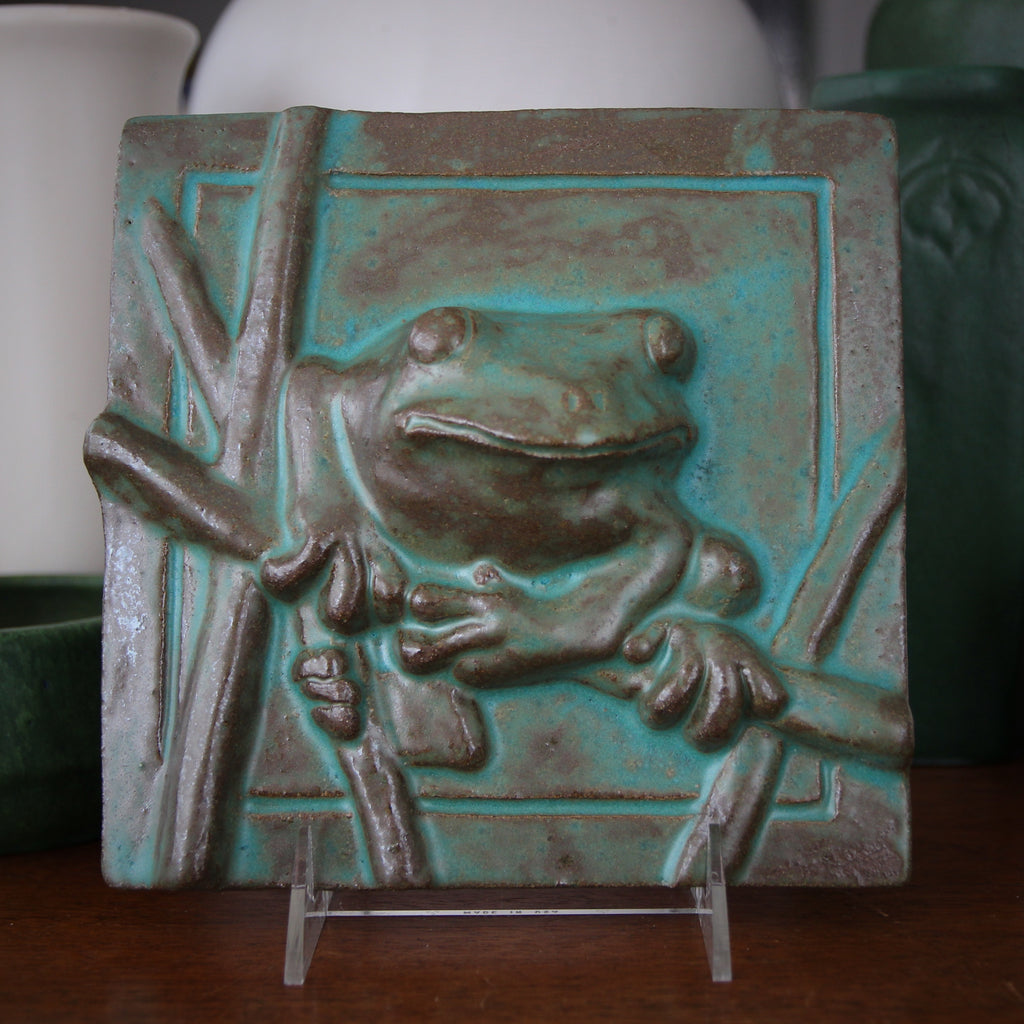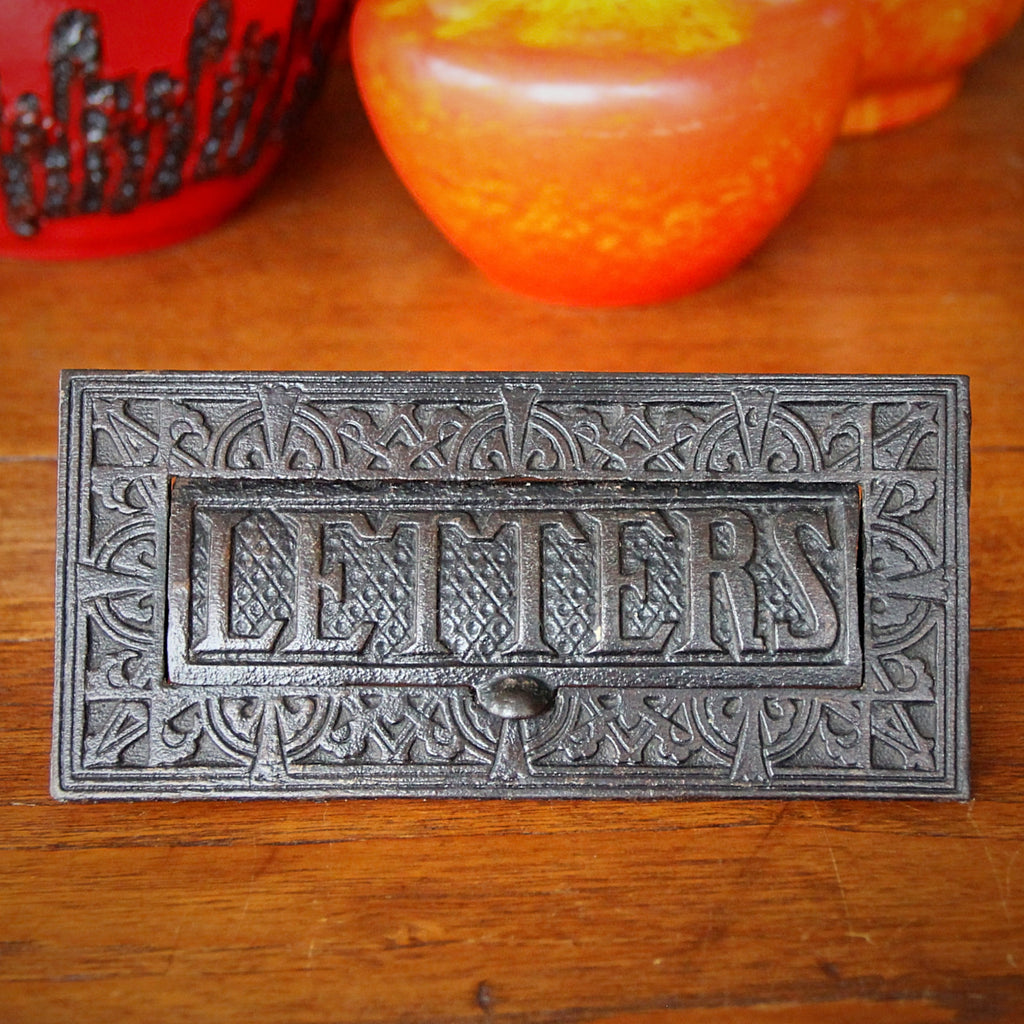JOURNAL RSS
To hold this Japanese hand-carved business card case is to appreciate its beauty and craftsmanship. The delicately tapered "wedge" (thicker on one edge than the other) feels great in the hand. The hinged cap, at top, closes with a satisfying magnetic click. Pulling the case from the breast pocket of a jacket will provide that extra measure of confidence before handing one's business card to that important professional contact.
Wooden It Be Useful? - III
This week we're sharing a selection of useful wooden items. The wood of this English barrel-form coin bank glows richly. Riveted brass bands punctuate the bulging form. Warm, honest materials meet straightforward function: a handsome place to stash your savings.
Wooden It Be Useful ?- II
Yes, this English Arts & Crafts Letter Rack is made of wood—though it is embellished with plenty of hand-hammered brasswork. A winged dragon stalks in a field of botanicals, while an undulate amethyst glass cabochon floats overhead. The hand-tooled panels are riveted to the oak understructure. This piece is made to hang (on its mounting ring) or it can rest of a flat surface.
Wooden It Be Useful? - I
Is there anything more wonderful than wood? Warm. Useful. Natural. For millennia, humankind has been fashioning wood for tools, shelter, warmth and all sorts of decorative items. Perhaps it is the most malleable and accessible of natural materials. And the nature of wood makes it ideal for many uses—which no other material can replicate.
For the next several days, we'd like to share a selection of our wood-crafted objects, items which are handsome and useful.
Shown here, an American Arts & Crafts slatted oak wastepaper basket. The quarter-sawn strips, bound with rawhide lashings, add an additional level of textual interest. What Arts & Crafts desk (or office) wouldn't look better with this handsome basket?
London Calling - X
It's a chilly morning in London—4:30 am—and we await the car to the airport. (Where is he?) Not much sleep and I'm exhausted; I guess I can sleep on the plane. But I have had a wonderful week—socially, artistically, theatrically, professionally. It's great to have "stretched-my-legs" in London. In the next week or two, I intend to have received, cleaned-up, photographed and listed the new items (currently in-transit with the shipper). These suitcases are for our personal possessions and purchases—and, in truth, my husband had been in London for six weeks.
It will be good to get home! And start processing the newly acquired finds!
London Calling - IX
It's hard for me to name a favorite London museum. Let's just say that the Tate Britain is one of them. For me, a visit to the Tate is a walk down Memory Lane, enjoying my favorite, painted hits. So, for my last full day in London, I went to visit the Tate. The museum claims to present "500 years of British Art"—and its collection is, indeed, vast and wonderful. But how "British Art" is defined seems rather elastic to me; many of the museum's works have been sculpted or painted by non-Brits. Perhaps a work of art (even one by a foreign artist) qualifies as "British" if it was conceived on British (or United Kingdom) soil? Or perhaps it's considered "British"...
London Calling - VIII
Shopping, theatre and museums! My three favorite things to do while in London. Having finished packing-up all my purchases (thus far), I headed to Trafalgar Square to visit the National Portrait Gallery and the National Gallery of Art—two of the great art museums in the world. Shown above, a portrait of Queen Elizabeth II, painted in 1969. The trustees of the National Portrait Gallery wanted to commission a new portrait of Her Majesty for their collection and the Queen expressed interest in sitting for Italian portraitist Pietro Annigoni (who had painted her 15 years earlier, as a young queen). It took 18 sittings (over 10 months) before the painting was unveiled in 1970. The bold, regal likeness—with its monumental, Modernist composition—captured...
London Calling - VII
In 1851, Queen Victoria's husband, Prince Albert, organized a Great Exhibition in Hyde Park, which was a tremendous success. This Great Exhibition of the Works of Industry of All Nations featured 14,000 exhibitors and welcomed six million visitors. Queen Victoria visited 37 times. The fair's purpose was to elevate and promote science, industry and technology. It was modeled on previous French exhibitions which had focused on French trade. This fair, however, broadened the exhibitors' list to companies and organizations from around the world—making this show a model for future World's Fairs. Prince Albert, a driving force in embracing technology and social improvement, proposed building a permanent venue, a flexible space for exhibitions, entertainment and public education on the edge of...
London Calling - VI
Hyde Park provides much "breathing space" for many Londoners—not unlike Central Park in New York City. The park began in 1536 when Henry VIII plundered the Church property from Westminster Abbey (part of his "dissolution of the monasteries") and created a private hunting grounds for himself and his court. In 1637, King Charles I declared the park open to the general public—and it has since remained an important retreat from the bustle of London's urban life. The park also is a site of dog walking, sunbathing, horseback riding, and other quiet recreation. It has been a military camp, a parade grounds, an exhibition fair grounds and the location for duels to the death. And Hyde Park is a go-to location...
London Calling - V
When I first opened my shop on Bleecker Street in 1995, I carried a line of British men's shaving products made by George F. Trumper. Trumper opened his Mayfair barber shop in 1875. He was a talented perfumer, as well, and he produced a line of men's grooming products which quickly became fashionable with London's wealthy gentlemen. His little shop—still fitted with original Turn-of-the-Twentieth-Century mahogany cabinetry—is on Curzon Street. From the 1680's through the 1760's, Mayfair was the pastoral site of the annual May Fair, held the first two weeks of May (except when the Plague was raging). In time, however, the attractions—and the crowds—began to upset the delicate sensibilities of the gentility prompting the Grosvenor family (the Dukes of Westminster)...
London Calling - IV
The quiet, upscale neighborhood of Notting Hill is overrun every Saturday morning—when the Portobello Road antiques merchants descend upon this otherwise peaceful neighborhood. And, along with the antiques traders, come thousands of customers (some serious about buying, most "just looking"). The market begins to open at 6:00 am. By Noon, the streets are clogged with Italian tourists enjoying their obligatory (and oh. so. slow.) passeggiata. The main market street, Portobello Road, began as a food market in the Nineteenth Century. After World War II, antiques traders began to populate the upper part of the road. Today, it is the largest antiques market in Britain. A mixture of terraced townhouses, small row houses, and Thirties apartment buildings are interspersed with retail...
London Calling - III
Buying trips to London mean several certain things: early, dark and wet mornings, lots of tunneling-about on The Tube, and as much theatre as I can manage to see (though evening theatre and pre-dawn antiques hunting can be a difficult combination). I started-out Friday morning to catch the first (5:51 am) Tube to the Southbank. Four hours in the damp (including mist and rain) was unpleasant though productive. Aside from the rain, it's nice to be prowling-around the City at such an early hour. It seems that I have the whole place to myself. Come mid-morning, I headed to the Northwest section of London, finding myself in a (surprisingly) quiet Edgware Road Tube Station. This station, which serves the Bakerloo Line,...
London Calling - II
While Bloomsbury has been my standard visiting residence in London, on this trip we're staying in the Islington flat of a good friend who is in South America for a few months. We are fortunate to have been allowed to stay in his London apartment. I first met this friend, Mark, in the 1990's when he walked into my Greenwich Village shop. He is a collector (and part time antiques trader) from whom I sometimes by merchandise. We've remained good friends from the day he walked into my store. The name Islington is the evolution of several earlier names. The Saxons (c. 1000-1050 AD) called it Giseldone and Gislandune (meaning "Gisla's Hill" or "Dune"). This name eventually became Isledon until the 1600's after...
London Calling - I
If I had to pick one London neighborhood to call my own, it would be Bloomsbury—long a center of London's intellectual, scholarly, medical and literary enterprises. I have been staying in this active, human-scaled neighborhood for decades—surrounded by students and faculty from the neighborhood's several colleges, and employees of the numerous bookshops and many creative businesses in the area. The neighborhood was first called "Bloomsbury"—or, rather, "Blemondisberi"—in 1281, named after the French Blemond family who owned the manor here. In time, King Edward III (who reigned from 1327-1377) acquired the property, still largely rural, and gave it to the Carthusian Monks. Later, when Henry VIII was "disbanding the monasteries," this property was seized and given to one of the King's...
Oxford Around the Corner - III
Let's wrap-up this short presentation on Oxford Corners with an Eastern European beauty, made in the Teens or Twenties. Marquetry stripes of contrasting woods are surrounded by notched chip-carving—providing a serrated "Tramp Art" effect. Tramp Art is the popular name for notch-carved treatments on folk-crafted wooden objects. Traditionally, the items were assembled and carved from found objects: cigar boxes, fruit crates, scrap wood offcuts. The "romantic legend" implies that homeless men, in an attempt to make a bit of money, would scrounge for the recycled materials and craft the little wooden objects to sell. In truth, Tramp Art was probably more often a simple, low-cost handcraft practiced by hobbyists and boy scouts at home, at school or at summer camp....
Oxford Around the Corner - II
Here's a different take on the Oxford Corner—crisp, bold, structural. Chamfering of the members adds sophisticated elegance to the otherwise simple frame. The extended legs of the Oxford Corners make for simple, integrated "feet."
This Victorian English brass frame was made in the late Nineteenth Century. It would provide a nice "pop" for any picture—especially a dapper black and white portrait.
Oxford Around the Corner - I
I'm heading to England this week—London, not quite Oxford—and I thought I might prepare for the trip by sharing a few frames with "Oxford Corners."
Oxford Corners are the style of framing joinery in which the vertical and horizontal members form an intersecting cross at the corner. And, while such joinery is named after the famed academic city, Oxford Corners have been made all over Europe—especially in the Nineteenth Century, from which the frame above originates.
The "Blackforest" frame, shown above is from either Southern Germany or Switzerland—the forested mountainous region which has long specialized in carved woodwork. This frame exhibits a hand-carved "rustic-timber" profile. Carved wooden leaves embellish each of the frame's corners.
Fierce!
This fierce feline is ready! Ready to guard your precious tomes. This pair of fierce lion bookends was made of cast iron in the Twenties or Thirties and still wears most of his original golden paint. Beautiful, deep bas relief sculpting is well-aged by time—creating the perfect "high/low effect" on the patina, making the sculpture pop. Lions have been portrayed in the decorative arts for thousands of years. And they have been a significant part of European heraldry since the Middle Ages. In fact, every "attitude" (position or posture) of a heraldic lion has a specific name. A lion rampant stands upon its back legs. A lion passant is shown walking. A lion couchant is lying upright, on its belly (like...
Earthy Green
Green is my favorite color of pottery. The reason? Perhaps because I really love wood—boxes, furniture, paneling, cabinetry—and what looks better with wood (trees) than leaves and grass (green)? I find the color green (at least most shades) calming, centering. Green relaxes me. It's the color of nature herself. And the deeper the green, the more I like it.
The Übelacker West German Modernist jug, shown above, is a home run! The earthy, green glaze, for starters, is deep, deep, deep—and just this side of muddy (without being drab). Plus, the glaze is a matte finish—another few points in its favor.
Complex Reaction
Is it possible for one to have complicated feelings towards a pair of bookends? Well, it seems, in this case, I do.
The cast iron bookends shown here, are from the Twenties or Thirties. The workmanship is terrific: handsome bas relief sculpting, ultra-crisp casting, and a beautiful bronzed patina. The details of the unfolding scene—the distant mountains, the dust rising on the prairie, the scrub brush in the foreground—are conveyed with wonderful precision. The bookends are an homage to romanticized Western life—handsomely executed and perfect for any American Arts & Crafts interior.
Welcome, February!
February is here. And she brings with her the amethyst, birthstone of the month.
Until the Nineteenth Century, amethysts were rare and very expensive. They were considered one of the five "Cardinal Gemstones"—alongside diamonds, rubies, emeralds and sapphires. Initially, deep purple amethysts—the color of royalty—had only been discovered in Russia and Austria. Medieval monarchs loved amethysts. To this day, Anglican and some Roman Catholic bishops wear an amethyst in their episcopal rings.
According to Ancient Greek mythology, Dionysus—the god of wine—was in-pursuit of a beautiful virgin, Amethystos. Her prayers to remain chaste were answered: before he could catch her, she turned into a beautiful white stone. In his grief, Dionysus poured wine over the stone, turning it violet—the first amethyst.
Soviet-Cute
In nature, some of the cutest and cuddliest creatures can grow-up to become most fearsome—and dangerous. This Soviet porcelain bear cub might just be one such critter. The sculpture was made in the Sixties or Seventies in the Soviet Union. The symbol of the Russian Bear is an old one—at least from the 1500's. In the West, the symbolism is sometimes interpreted disparagingly: bears can be hulking, awkward and savage. Unpredictable and dangerous. But in Russia (and the Soviet Union before that), the bear has been a symbol of national pride: strength, fortitude, power. The earliest recorded use of the symbol is in Shakespeare's Macbeth (who says to the ghost, "What man dare, I dare. Approach thou like the rugged Russian...
Edelweiss
In 1856, Austrian Emperor Franz Joseph I was enjoying a mountain trek with his new bride, the Empress Elisabeth, a Munich-born beauty known as "Sisi." He picked a few edelweiss blossoms from amongst the craggy rocks and presented them to his beloved with the words, "First in my life that I picked myself." From that point onwards, the popularity of the flower was assured—as a symbol of immaculate and everlasting devotion (and, more broadly, emblematic of the rugged purity of the Alps and her people). Sisi wore nine edelweiss blossoms in her hair while sitting for her famous portrait by Winterhalter. For his part, the Emperor had edelweiss blossoms embroidered upon the collars of his Imperial-Royal Mountain Troops. The flower...
James Plant Ceramics - Part II
A few weeks ago, a British (Dutch-born) ceramics collector contacted me about my James Plant ceramics offerings, which he had seen on-line. He is writing a book on the influence of Gouda (Dutch) pottery on English ceramics design. James Plant's "Orientalist" wares—while they certainly have their own distinctive aesthetic—do share a similarity with Gouda's hand-painted pieces. He asked for more photos of my pieces and my permission to use my photos in his forthcoming book. I was happy to help—and happy to have acquired new-found motivation to re-shoot the photos of the two pieces (which had never been well-lit in their original photos).
James Plant Ceramics - Part I
The history of James Plant & Sons English ceramics is, shall we say, "contested." Although the vase designs and decoration are firmly rooted in the 19th Century—Christopher Dresser-inspired shapes, hand-painted "Persian Orientalist" decoration, and an 1890's Aesthetic Movement attitude—certain English collectors contend that such wares were created during World War I, when Liberty of London sought to find a replacement source for Gouda-type (Dutch) ceramics (which could no longer be imported, due to the war).
Here's what we do know about James Plant & Sons. There are records of multiple "James Plants" working in and around Hanley, England—the heart of "The Potteries," Stoke-on-Trent, Staffordshire.
Cheers!
When "just a nip" is enough, these one-ounce cordial glasses are perfect for the job. Cordials—liqueurs which are fairly strong and often sweet—are usually served after dessert. They are most commonly made of rum, brandy or some other spirit, strongly-enhanced with fruit, cream or herbs & spices. In a glass like this, they are served "neat"—that is, plain (without other ingredients), at room temperature. But liqueurs and cordials can also be included, as an ingredient, in other, mixed cocktails. The first liqueurs were made in the abbeys of Medieval France, where monks blended curative potions including herbs and other botanical medicaments. Early liqueurs were an evolution of herbal medicine. But before long, the monks were enjoying this postprandial tip—whether...
At Swim-Three-Fish
A most handsome vase has "swum" our way: an English Art Deco beauty by Pilkington Royal Lancastrian. A repeating pattern—three carp-like species riding atop scrolling waves—is incised upon the body of the vase. A mottled orange and yellow "uranium" glaze pops against an earthy "kelp brown" background. This vase was made in the Twenties or Thirties, just outside of Manchester, England. It has enough presence to hold-its-own as a statement piece. And yet, I must admit, it does look good featured against a collection of other Royal Lancastrian pieces.
Sailing Towards Christmas
True, Christmas is eleven months away. But it is coming!
This cast iron "Spanish Galleon" doorstop was made by Hubley (Lancaster, PA) in the Twenties or Thirties. It still has much of its original hand-painted color—though that paint is now well-aged (and full of character). Imagine this doorstop holding the door (or decorating the mantelpiece) of your favorite sailor's den or office. And imagine what style it would bring to someone's house at the shore.
Mirror, Mirror
Dorothy Thorpe (1901-1989) was a Mid-Century Modernist glassware decorator. She never manufactured any items herself; instead, she purchased "blanks" from established glassware (and ceramics dinnerware) makers to which she added her own decorative spin. One of her signature styles was glassware with metallic "mirrored" banding at the rim. This banding could be produced with a crisp edge or a softer "mirror fade" edge. It seems that Dorothy Thorpe was rather inconsistent when it came to marking her wares. Perhaps this was the result of sourcing products (the "blanks") from so many disparate manufacturers. Or it could be the result of her using so many different decorating processes to create so many differing styles. Sometimes she sand-blasted her initials onto...
Style, Quality, Mass-Production
One of the recurring themes of my Journal Ramblings is the confluence of taste, quality and modern production methods. There was a time in the Nineteenth Century—during the height of the Industrial Revolution—when good & tasteful design married the economically advantageous benefits of industrial mass-production. The idea was to create a beautiful original and then to produce them in great quantity—an effort "to bring good taste and quality to the masses." This happened in England and, a little later, in America and throughout the industrializing world. The simple 19th Century letter and pen holder, shown above, is an example of this phenomenon. Two identical "ends"—formed as a pair of flared, booted legs—are spaced three-and-a-half inches apart, joined with rods. A...
Throwback Monday
In The States, "key wallets," like the one shown above, are thought of as . . . well . . . a bit old-fashioned. Perhaps like something one's grandfather might have carried. Today, people throw their keys (if they still have any) into a bag or pocket—where it might scratch a mobile phone or poke a hole through the pocket lining. Maybe key wallets aren't such a bad idea? In Japan, where this Repp Stripe Key Wallet was made, this type of accessory is much more common. It keeps keys nice & tidy, easy to find, and it keeps one's pockets (or delicate possessions) safe from metallic banging, poking and scratching. The striped fabric covering has the appearance of silk...
Hammered Copper
Copper has been hammered in Mexico since Pre-Columbian times. Even today, there are certain regions, like Santa Clara del Cobre, where artisans still work the copper—usually in small, home-based "cottage industry" settings. Fathers and sons (and grandsons to follow) have kept their family workshops going for decades. Each workshop usually focuses, specializes, in a certain type of work: perhaps small, delicate vessels, perhaps naturally-rendered fruit shapes, perhaps large, "macho" urns and heavy vases. Each piece is "raised" from a single ingot of copper: repeatedly heated in a bonfire on the end of a tongs and beaten with a series of various-peen hammers. An anvil might be the only other "tool" used. Nevertheless, the metalsmith is able to achieve a balanced...
Peregrine Power
The Peregrine Falcon has been capturing mankind's imagination for millennia. The Ancient Egyptians depicted their sun god, Ra, as having the body of a man and the head of the peregrine. And, for at least 3,000 years, people have been practicing falconry—the sport of training domesticated falcons to capture prey and return to their master. Peregrine Falcons are superb hunters. They are eager, agile, adaptable and oh-so-fast. Peregrines have been clocked at speeds of 242 mph while in "dive mode"—making them the fastest animal on Earth. First they fly to an altitude over 3,500 feet, after which they rocket downwards toward their prey. They tuck-in their heads, pull-in their wings, and contort their bodies for maximum aerodynamics. Even at these speeds,...
Zinc
Zinc is a metal and one of Earth's 118 elements—and useful in many ways. Combined with other metals, it adds strength, corrosion-resistance or other desirable features to an "alloy." Brass is an alloy of copper and zinc (3%-45%, depending on the variety of brass desired). Zinc is sometimes alloyed with copper and tin to make bronze. And nickel silver is an alloy of copper, nickel and zinc. Rolled sheets of zinc are used in roofing or atop the wooden countertops in bars. And U.S. pennies, since 1984, are principally plated zinc. In recent years, since the ill effects of lead have become widely-known, zinc has often been used as a replacement for lead (in fishing weights, tire balances and other...
Amazing Glaze
In the world of ceramics, I have always treasured wonderful glazes—even more than I value form. A great form, once sculpted, can be duplicated endlessly. And, in many cases, form is easy for someone else to copy. Art pottery companies in the Twentieth Century would frequently sell their old moulds—or their employees would be hired-away by competing firms. After the Coca-Cola bottle was design in 1915, it was produced in the millions (billions?) for worldwide distribution—and has become an iconic feature of the global Coca-Cola brand. But no artistry or reinvention is necessary to keep that wonderful form in the marketplace (besides aggressive lawyers who guard vigorously the bottle's trademarked shape).
Drip Dry
Shaving brushes—good shaving brushes—are labor intensive and costly to make. Clusters of hair (whether synthetic, real badger or some other animal hair) are tied into knots and set within the brush handle (while carefully creating the classic dome-form brush shape). A good brush may last a man most of his adult shaving life—if he takes care of it. And the most important thing he can do is to rinse the brush and hang it bristles down, which allows the water to drip out of the handle (that it will not rot all those delicate knots). A nice brush stand is a good step in this protective direction.
Arts & Crafts Inspirations
Wherever an Arts & Crafts movement was to be found, one would also find references to that region's early history, literature and ancient cultural themes and symbols. The movement's anti-industrial DNA sought to incorporate remembraces of "pure and better times" in its contemporary design. In the American Arts & Crafts Movement, one of the recurring and popular themes was the cultural aesthetics of Native Americans. Indians were the original immigrants to the Americas—and they were the only ancient peoples on the Northern continent. Thus, if the American Arts & Crafts Movement was to incorporate ancient North American aesthetics, it makes sense that inspiration would come from the arts and artifacts of these ancient people. In England, Medieval knights and heraldry...
Martin Luther King Day
Happy Martin Luther King, Jr. Day!
King is honored on this national holiday for his leadership of America's Civil Rights Movement—and his enormous contribution to our country's conscience and moral fiber. The holiday is celebrated on the third Monday of January each year, which, this year, happens to fall on his actual birthday (15 January).
For the Champion, 1935
This Dutch hand-hammered pewter trophy combines elements from the Art Nouveau and the Art Deco. The hammering of pewter was a classic Art Nouveau treatment. The vessel's flaring, trumpet-like shape is punctuated with a pair of feathery, classical handles—a certain Art Deco influence.
The piece is "touch-marked" with the maker's name, "Gero." The company was founded in 1912 in Zeist, Netherlands, near the city of Utrecht. Gero (which is still in-business today) was the first company in Holland to manufacture affordable cutlery. They also produced pewter ware, like the trophy cup shown above, until 1955. A succession of artists and creative directors over saw the company's design, though I am uncertain which artist designed this piece.
Vegetable Dyed
One of the nice things about vegetable-dyed leathers is that they develop a handsome, rich patina with use—they are "polished" every time they are handled. This chocolate brown calfskin wallet is from Bill Amberg, London. The design—including a fine zipper which tracks around three sides of the wallet—gives it just a touch (but not too much) of a tough, urban attitude. The zipper also helps keep things neat-and-tidy.
Storage Space Upgrade
It's the New Year! Time to reorganize, refresh, retire that To-Do List, sitting oh-so-long upon the desk. Perhaps this pair of Victorian cast iron brackets—embellished with delicate, pierced "tracery"—will give your storage projects a lift? They were made in the 1880's or 1890's and are six inches in one direction, eight inches in the other. This means you can install a wider or narrower shelf, based upon your needs and the space you have available (supporting shelves from six inches to approximately ten inches wide). These brackets would provide a small but powerful shot of architectural interest wherever they might be installed: in the kitchen, a bathroom, or in the office-den.
Winter's Chill - X
Let's end our parade of wintery pottery back in Pierrefonds, France—back in the shadows of the Medieval Chateau de Pierrefonds. It was here that Art Nouveau forms were dressed in sophisticated crystalline glazes, resulting in works which are unlike anything seen before or since. The French Art Nouveau vase, shown above, has an organic, egg-form body. It sits on a "platform foot" and is punctuated with two peaked, "bat wing" whiplash handles. As wonderful (and striking) as the form itself is, it's the sublime glaze that really takes this urn over the top. Multiple colors—blues, tans, greens—drip casually over the curved body of the vessel. Some of the glazes have crystallized in the kiln. And, because the vase wears a...
Winter's Chill - IX
The English ceramic pot shown above, hand-thrown by Edward Thomas Radford for Pilkington Royal Lancastrian, is finished with a gorgeous, sky blue glaze. And, if one looks carefully, one will see that the blue glazing displays the subtlest of ombre effects—slightly lighter at the top, slightly darker at the base—not unlike the graduations of color to be found in the actual winter sky. You also still can see (and feel) the delicate fingermarks on the sides of the vessel, left by the potter himself, on the day the pot was formed upon its spinning wheel. A vase like this can be used to display a striking, minimalist floral arrangement—think three sculptural stems. It would also look good with a full,...
Winter's Chill - VIII
Even in the coldest of weather, the ocean seems to remain liquified—at least as far north as I've ever traveled (New England). It's plenty cold, indeed, yet the waves continue to wash ashore and its salty foam bubbles, churns and slowly recedes back to the sea. This West German Modernist carafe-form vase is glazed in a sea-worthy blue, topped with a dripping, tempest-tossed white foam. The corseted neck of the vase provides a constricted opening at top—perfect for gathering a modest number of stems together, nice-and-tight. And the blue (and white) coloration provides a fresh backdrop for any manner of flowers: white carnations, yellow roses, green hydrangeas.
Winter's Chill - VII
We hop back to England, Stoke-on-Trent, to be specific. This conglomeration of six small towns in Staffordshire, England, was Ground Zero of British ceramics production in the Nineteenth and Early Twentieth Centuries. The region was frequently referred to as "The Potteries." Clay could be dug out of the ground. Coal was plentiful. Labor was cheap. And the region's glut of manufacturing ensured that train service (for shipping-out merchandise) was frequent and efficient. The George Clews pottery company was founded in 1906 in one of Stoke's towns, Burslem. In 1908, they moved to bigger facilities in the adjacent town of Tunstall. Although the company was named after the Clews family patriarch, George, the organization was actually run by his son, Percy Swinnerton Clews...
Winter's Chill - VI
Saturated blue glazes drip organically down the bold, two-handled form of this French Art Nouveau urn from the early Twentieth Century. It was made in the French village of Pierrefonds—some 55 miles North-East of Paris—in the shadow of the village's Medieval castle, Le Chateau de Pierrefonds. The deep blue glazes convey an ice-cold mien, perfect for the frozen, clean winter weather. The Pierrefonds pottery workshop was opened by a painter, a French nobleman, Comte Hallez d"Arros in 1903. He envisioned producing handsome tableware—plates, bowls, pitchers—painted with fancy aristocratic heraldry: shields, banners, noble crests. The village's castle, he thought, would be a perfect backdrop to such a romantic and aspirational product line. And the pottery's name, La Societe Faienciere Heraldique de Pierrefonds,...
Winter's Chill - V
This smallish vase—perfect for a stem or three—reminds me of a heavily clouded winter sky. Tightly-packed, fluffy clouds allow a bit of icy blue to peek-through. Or, perhaps, it looks like compressed ice on the surface of a frozen pond. As the water freezes and melts and freezes again, a dappled, irregular pattern emerges. The piece was made by Jopeko in West Germany in the Sixties or Seventies. Jopeko began its life, under a different name, in the mid-Nineteenth Century. Like so many Twentieth Century potteries, its earliest output was "sanitary ware"—pipes, crocks, kitchenware and water coolers—not fancy decorative objets. But, after World War II, Germany (and Japan, another "vanquished" country) found that it had a large labor force to put...
Winter's Chill - IV
Like a midnight sky, this West German vase is a play on shades of blue: inky, blackish blue with eerie streaks of penetrating brightness. It displays a simple—yet satisfyingly sensual—organic form and wears a random drip glaze which adds to its one-of-a-kind appearance. As the glaze courses over the soft curves of the vase, it creates an object filled with dynamism and movement and complexity. The ceramicist is Fridegart Glaztle who had a long and consequential career at the Karlsruhe West German ceramics studio. The Karlsruhe ceramics factory was founded at the Turn-of-the-Twentieth-Century to produce ceramics in the Italian Renaissance style. It underwent several changes of owners over the years, including private ownership by Villeroy & Boch and being state-run...
Winter's Chill - III
An icy season calls for an icy glaze. This handsome piece by Fulper (c. 1905, Flemington, New Jersey) is glazed in an organic Impressionist Winterscape of lustrous and crystalline glazes—frosty blues and just a hint of green. Think of a frozen, icy rock face or the hard, shiny surface of an icebound lake. Fulper was one of the true "art pottery" workshops in America during the Arts & Crafts period, attempting to emulate the coveted "Oriental" glazes which had eluded Western potters. Although the company had started its life (in the Nineteenth Century) by making utilitarian wares, by the Turn-of-the-Twenieth-Century, Fulper was hiring skilled artists and technicians to produce quality, expensive art pottery. Part of this high-minded mission may account for...
Winter's Chill - II
In France, where wine has been a traditional part of lunches and dinners, it was not unusual to serve table wine casually, decanted into a ceramic wine pitcher. French table wine, though delicious, is a bit lighter, of lower alcohol content, and not expensive (making it perfect for lunchtime or afternoon consumption). The size of the jug might be large or small—depending on the number of guests at table. Such wine pitchers might be found in either private homes or in taverns. Shown above, a small wine pitcher which might hold a couple of modest servings (or if planning ahead, provide a couple of top-offs). Using a pitcher not only allowed the wine to "breathe," it also added a touch...
Winter's Chill - I
The Winter's Chill—bitter though it is—brings with it a sense of freshness, cleanliness, purity. The color white often symbolizes a snowy, cold expanse. But I also feel that blue—the color of sky, water and ice—can express beautifully the cleansing wintry freeze. For the next few days, we'd like to present an array of handsome blue ceramics, from many different countries, which might bring a little beauty to this otherwise frosty season. In 1889, brothers Edward and Alfred Pilkington were in the coal business. One of their new, prospective mining sites, in Clifton—on the outskirts of Manchester—proved to be a bust. Sited alongside Fletcher's Canal, the mineshafts only produced water and clay. But this clay was perfect for making decorative tiles...
Twenty, Twenty-Four!
Has ever a year been more-anticipated? It's here, folks: 2024! So much to do! Big tasks which (sometimes) seem impossible. But, before we get-down-to-business, we at LEO Design want to wish you good health, much happiness and plentiful contentment in the New Year. The German porcelain sculpture, shown above, captures Baby Hercules, returning home to his cousin, King Eurystheus, after successfully completing his "First Labor." His cousin, the king, ordered Hercules (called Herecles by the Greeks) to slay the Nemean Lion—a fearsome beast whose golden fur was impervious to the weapons of mortals. Not knowing this, Hercules began his attack by shooting the lion with arrows—which simply bounced off the lions hide. So Hercules concocted a new plan: he...
What Are You Doing New Year's Eve?
Maybe it's much too early in the game. Ah, but I thought I'd ask you just the same. What are you doing New Year's, New Year's Eve? - Ah, but in case I stand a little chance, here comes the jackpot question in advance, what are you doing New Year's, New Year's Eve? - Frank Loesser, 1947
Puzzle Peg
Long, cold nights—and the presence of holiday visitors—may benefit from a menu of possible diversions (besides eating). Why flip-on the Netflix when you can suggest a game of "Puzzle Peg"? Made in the Twenties, this gameboard (complete with all pegs, instruction manual and the original box) provides several different game options—to keep your company engaged and distracted.
Elephant, March!
When Cyrus the Great founded the First Persian Empire in 550 BC, it was the largest dominion in the world. Such a remarkable empire required cutting-edge defense—in this case, elephants! True, elephants were difficult to train and costly to maintain. But they did provide a competitive edge (at least for a while). When Alexander the Great came to conquer the empire in 334 BC, the elephant troops did cause him a moment of concern. Eventually, however, Alexander figured his way around the elephants and annexed Darius III's enormous realm to his sprawling Macedonian Empire.
More Milk, Please
Here's another handsome milk pitcher, this one made by the Robinson-Ransbottom Pottery Company in the Teens or Twenties. It is called "yelloware"—a country kitchen staple material for plates, bowls, crocks, and other utilitarian objets. Bas relief flowers and strapping add a bit of decoration to the otherwise simple vessel. The company was founded in 1900, in Roseville, Ohio, by Frank Ransbottom and his brothers, Ed, Johnie and Mort. The town of Roseville was a center of ceramics production and Frank had experience working with other ceramics manufacturers in the region. When a pottery factory became available for sale, Frank and his brothers purchased it. By World War II, the Ransbottoms were the largest producers of stoneware crocks and jars in the...
Cream of the Crop
It's the week between Christmas and the New Year. Time for relaxing at home; perhaps nice family breakfasts are in order? If so, consider this little pitcher. It holds up to 16 ounces of milk, or cream, and is decorated with the heads of a cow (on one side) and a bull (on the other side). It also would be terrific for serving warm maple syrup for pancakes or waffles. The jug has a "country primitive" look. And the dripping, organic glazes—blue, brown and green—is reminiscent of majolica (although true majolica is always uses a tin glaze, which I am not sure this glaze is). This piece is similar to ceramics from Bennington, Vermont, though I have not been able...
Boxing Day
In England, "back in the old days" (when most middle-class families had household servants), "the help" was expected to work on Christmas Day, to serve their employers who were celebrating the holiday. The day after Christmas was the day-off for the servants. It was called "Boxing Day," as this was the day on which servants would receive their Christmas gifts—their "boxes." Even today, despite the fact that very few British homes can afford live-in servants, Boxing Day is still a "bank holiday."
The Japanese Modernist lacquerware box, shown above, is dressed in a handsome red "tortoiseshell" lacquer. The interior is finished in black lacquer. This Mid-Century box is perfect for serving precious foods: elegant sushi, sophisticated cookies, exquisite pâtisserie.
Merry Christmas!
All Good Wishes for a Merry Christmas and a New Year of Health, Happiness and Contentment!
Christmas Eve
In one of LEO Design's earliest years—on Bleecker Street—I acquired this pair of Italian polychromed terracotta angels, candle-bearers. Perhaps it was 1996 or 1997. I knew nothing of them, except that I liked them. They weren't old but they were Italian and they were sensational. On that first year, I placed them into the shop window on Christmas Eve. Over the next week, while they were still guarding the window, I got the occasional price enquiry but no serious interest. The next year (and the year after that) the angels made their way into the shop window on Christmas Eve. By now, the placement had become a bit of a ritual: at about 9:30 pm, half and hour before closing...
Seven Months 'til LEO!
I need little encouragement to celebrate—to lionize—LEO. This Turn-of-the-Century cast iron "Ferocious Lion" coin bank will help remind us that LEO starts seven months from today! He is nicely-cast and wears an age-darkened, original patina.
Hah-Baht Dem Stillers?
Pittsburgh is sports-mad. Football, hockey, baseball. Never have I seen a greater percentage of a populace regularly wearing their teams' logo-wear. Even the college upon whose fringes I reside—The University of Pittsburgh—is crawling with students wearing their school's sports logo. The elegant, elderly postal clerk at my local post office wears a delicate, gold Pittsburgh Steelers logo necklace—studded with one small but shiny diamond. While I have no intention of falling-in with the logo crowd, I do thank Heavens that black is the overwhelming Pittsburgh sports team color. It allows me to pretend, just once in a while, that I am back in Manhattan. I also am able to blend-in with the crowd, what with 50% of my wardrobe being black....
Welcome, Winter
This evening—at 10:27 pm Eastern Time—Winter will begin in the Northern Hemisphere. 10:27 pm will also mark the moment when the Earth's North Pole is tilted furthest from the Sun. Thus it is the shortest period of daylight in the year (for those of us living in the Northern Hemisphere). Starting tomorrow, 22 December, the days (that is, the daylight) gradually will get longer and longer. Today is also our Seventh Wedding Anniversary! Though we have been a devoted couple for (almost) 34 years, legal marriage was not afforded us for most of that time. On this day, in 2016 (with President Obama securely in-office for one more month), Bob and I ran-down to City Hall for a late morning...
Six Months 'Til Summer!
Summer is on its way—six months from today! Of course, we need to get through Winter, first (which begins tomorrow). So, while these days are dark and the temperatures are cold, let's think back fondly on warmer, brighter days, perhaps when we were relaxing at the seashore. The seashell-encrusted box, shown above, was made around the Turn-of-the-Twentieth-Century. But this type of craftwork has been popular since the Eighteenth Century—perhaps first inspired by Baroque art and design (which often used water, sea life and seashells in its exuberant, exotic aesthetic). The Eighteenth Century also witnessed a growth of Natural History specimen collections, at least amongst the educated (and wealthy) elite. The use of a collection of seashells, such as on this encrusted...
A City on a Hill
The United States Capitol building is a glorious feat of Neoclassical architecture. Construction began in 1793. Central portions of the building were complete by 1800—only to be partially burned-down by the British in 1814. The damaged portions were re-built and the entire building expanded in the 1850's. The cast iron dome (weighing nearly nine million pounds) was finally completed in 1866. Like other important Washington, D. C. buildings, the Capitol is Neoclassical in design and painted white. Indeed, it gleams like the proverbial City on a Hill.
The glass-slab paperweight, shown above, features a sepia photograph of the Capitol. It's a handsome and useful gift for your favorite historian, architect or future Congressman.
Ceylon Porcupine Quill Crafts
This slide-top box, probably designed to hold cigarettes, was made in the late Nineteenth or early Twentieth Century in Ceylon (now called Sri Lanka). During the British Colonial years, Sinhalese craftsmen made these boxes of porcupine quills and inlaid bone-chip "dots." Originally, such objects were made for local use. But they caught-on with the occupying Brits who bought them to take back to England with them.
Such quills are shed, naturally, from the porcupine. Dropped quills can easily (and humanely) be collected by the craftsmen who cut and use them in their works.
Gaudete Sunday
Today is the third Sunday of Advent, known as Gaudete Sunday. "Gaudete" is from the Latin, meaning "Rejoice!" In earlier times, Advent had a more "penitential" quality—and lasted 40 days (as does Lent, the period before Easter). Advent, at that time, was observed customarily with fasting and abstinence. Gaudete Sunday was a brief reprieve, when abstinence was temporarily suspended. People were permitted to "cut loose"—to focus on the Joy of Christ's coming. On Gaudete Sunday, the priest's vestments are rose-colored and the rose-colored candle on the Advent wreath is lighted (the other three candles are purple). For this reason, Gaudete Sunday is sometimes referred to as "Rose Sunday."
To Market! To Market!
A village woman—perhaps heading to market—enjoys a last minute snuggle with her kitten. This beautifully-carved wooden sculpture is likely from the Blackforest (Germany or Switzerland) or, perhaps, Eastern Europe.
From Birmingham, with Luck
The brass paperclips, shown above, are designed in the form of a lucky horseshoe—and are embossed with a wish for "Good Luck." They have a loop on the back, allowing one to hang the packet of paper sheets on a nail on the wall. They were made in 1870 in Birmingham, England, by M. Myers & Son. Birmingham had a very important "Jewelry Quarter" since the Sixteenth Century. It was here that much of England's jewelry was produced. With so many skilled workers in the area, other small metalworks manufacturers sprung-up: makers of buckles, blades, metal buttons and pen nibs. Besides inexpensive labor, Birmingham also had the materials of production (iron ore and the coal to process it) and the means...
Advent
Today marks the eleventh day of Advent—half-way through this year's 22 day season.
Advent begins on the fourth Sunday before Christmas and ends on Christmas Eve. Its length varies from year-to-year depending upon which day of the week Christmas falls. Advent—which comes from the Latin phrase Adventus Domini ("The Arrival of the Lord")—is meant to be a time of reflection, preparation, and waiting-in-readiness for the Lord (though the social and commercial buzz of modern-day Christmastime provides much distraction to even the most intentional of Christians).
The West German Modernist terracotta Holy Family, shown above, was made in the Sixties or Seventies. Its simple lines—and natural colors—make it suitable for display year 'round, not only at Christmas.
'Tis the Season - XII
Let's end our array of Holiday miscellany with this handsome Christmas tin from the Twenties. A rather-serious portrait of Father Christmas is surrounded by a wreath-like frame of poinsettia blossoms. This covered box, modest in size, is made of machined steel sheets, litho-printed with this holiday illustration. It was made in Baltimore, Maryland, at the Tin Decorating Company—better know as Tindeco. Today, the box would make a wonderful place to keep holiday sweets. Or, perhaps, small ornaments, strings of glass beads or ornament hooks. It would also make a sublime presentation box for a special gift, packed within. Tindeco was founded in Baltimore in 1914. Within a few years, they were the largest tin decorating plant in the world—with a...
'Tis the Season - XI
Back in the day—when people used to give tobacco to their friends for Christmas—the John Weisert Tobacco Company (of Saint Louis, MO) made these jolly Holiday Gift Packs. Six boxes of tobacco (now empty) are enclosed in the handsome Christmas packaging—replete with Santa, greenery and ornaments. The top of the box has a place for the customary "To and From."
'Tis the Season - X
A jolly stained-glass window wishes you "Season's Greetings." And, as you lift your favorite double old fashioned drink, you'll appreciate the 22 karat gold band around the rim. It adds a glint of holiday sparkle, sure, but it also provides protection for the rim of the glass. And serving drinks is not the only task these handsome rocks glasses will accomplish with holiday style. Think of the desserts—peppermint hot fudge sundaes?—you might serve in them. Or eggnog. Or place a tea light (and a little sand) in each glass for a flickering, atmospheric lantern.
'Tis the Season - IX
Here's more jolly Holiday illustration—printed onto a set of six Christmas highball tumblers. Like yesterday's featured glasses, these were made in the Sixties (possibly Fifties), complete with cheerful, two-dimensional Christmas graphics. This red, green and white decor, however, is even more "vintage" than yesterday's graphic: simpler, flatter, more naive. These glasses conjure the idealized spirit, optimism and simplicity of a Post WWII America.
'Tis the Season - VIII
Growing-up in the Sixties, this is the kind of 2-D Christmas decoration I remember. Two dimensional Santas were cut out of plywood and painted—not inflated in the front yard—and lettered "Merry Christmas, from the Johnsons!". Shabby "tinsel garland" hung from lamp posts, often bent into the shapes of stars, bells, or holly sprigs. And the impossibly giant trees at the shopping center (Ala Moana, in my case) bore impossibly big ornaments (though I never liked the seams on the spheres, where the two halves came together). Still, it was magical and jolly and exciting. Christmas was coming! This set of six Mid-Century Holiday Highball Glasses, shown here, are decorated with (what now appears to be naive) golden candle lanterns, suspended...
'Tis the Season - VII
I've been to Russia twice—once to Saint Petersburg and once to Moscow—and I had air tickets for a third visit (and a valid tourist visa) in-hand when Ukraine was invaded by Russia in 2022. My plans were dashed, naturally. My husband, Robert Perdziola, a scenic and costume designer, was in the final stretch of opening a ballet, The Pharaoh's Daughter, at the Mariinsky (in Saint Petersburg) at the time of the invasion. Everything had been designed (two years before), constructed (months before) and the opening night was 3 months away. All that was left for him to do was to oversee the load-in, technical rehearsals, and final costume fittings. Last minute adjustments are always a part of any production's lead-up to opening....
'Tis the Season - VI
Happy Hanukkah! The Festival of Lights begins tonight at sundown, lasting for eight consecutive nights. Each night, another candle from the menorah is lighted—using the Shamas ("the helper") candle at the center of the fixture. This Modernist Hanukkah Menorah is made of cast bronze. "Hanukkah Sameach!"
'Tis the Season - V
Like trees on an icy, Winter landscape, these pressed-glass trees will provide a gleam of frosty delight in your home. The pair—one is taller than the other—would look great under your tree, on a windowsill, or atop your mantel. Place them where the light will catch their branches—or will shine through them.
'Tis the Season - IV
These little red owls—suitable for year 'round companionship on your bookcase or window ledge—are handmade in Peru. When I had my store in Greenwich Village, I kept a large wooden bowl of them near the front of the store—piled high with owls. Each little gourd is collected, dried, burned (for dark color), painted and hand-incised (providing highlight detail). Due to the varying shapes and decorating, each individual has his own style and personality. We sell them in trios—a small "parliament" of owls, carefully grouped to provide a bit of variety in each trio. They will provide beautiful color on your tree or will sit happily on your mantelpiece or windowsill.
'Tis the Season - III
Some things never get old. This set of six Holiday highballs—made in the Eighties—uses a 1930's illustration as festive decoration. A rim of gold provides a rich halo at the top of each glass—and a bit of useful protection to the glass's rim.
'Tis the Season - II
Color-Theme or Multi-Color? It's the classic decorating debate. I, for one, usually prefer a strong presence of one great color. "Anything worth doing is worth overdoing." My other half likes liberal mixes of color; the more, the merrier.
I guess at Christmastime, on a Christmas tree, one cannot go wrong with lots of varied color. In this case, a string of vintage multi-colored mercury glass beads (from the early Twentieth Century) would hit the right, jolly note. Additionally, this eight foot string of glass beads is faceted, adding an extra pop of reflected light and Christmastime sparkle.
'Tis the Season - I
This Laub's biscuit tin, made in the Fifties or Sixties, really screams Christmas. Perfect for storing your home-baked Holiday cookies or an excellent place to keep your favorite Christmas ornaments during the off season. Laub's was founded in Cleveland by German immigrant Jacob Laub in 1889. In time, it became the largest independent baker in all of Ohio with 465 employees.. They ran a bakery storefront, home delivery routes, and a brisk wholesale business (to other stores, restaurants and institutions). A box like this would have been used to present their Christmas cookies. Today, it provides a blast of vintage Holiday cheer—and is useful at the same time.
December is Here!
Welcome, December, and your sublime birthstone, the turquoise. Turquoise is amongst the earliest of mined gemstones, collected by humans for over 5,000 years. The stone has been found in Persia, the Sinai Peninsula (Egypt), Afghanistan, China, India, Mexico and the American Southwest. Egyptians buried their dead with carved turquoise talismans carefully inserted within the deceased's body wraps. The stunning burial mask of King Tutankhamun was decorated with inlaid turquoise. The Book of Exodus refers to the High Priest's turquoise encrusted breastplate. In the Middle East, mosque domes were sometimes decorated with (or painted) turquoise to convey the notion of "Heaven on Earth." And, in the New World, archeologists have found ancient turquoise artifacts of the Zuni, Pueblo, Aztec and Mayans. To this day,...
Looks Like Snow - III
Let's wrap-up our parade of white, snow-inspired vases with this handsome urn by Roseville, circa 1930.
Classical ceramics—made in Greece, before the time of Christ—have provided inspiration to later potters for thousands of years. Shown above, a Classical Greek-form urn, adapted to the early Twentieth Century with Art Nouveau-inspired "whiplash" handles. When an ancient form is updated with a (then) modern accent, something new and interesting is created. When glazed in a clean, satin white finish, the resulting piece is timeless and endlessly beautiful.
Looks Like Snow - II
This week we're commemorating the season's "sense of snow." Although Winter has yet to begin, it feels like it may snow at any time. Clean, white vases will help us prepare for the blanketing to come. Shown above, an Art Deco two-handled vase from the Thirties. It was made by Stangl in Trenton, New Jersey. But the Stangl company took a long and winding path to the Thirties. Samuel Hill opened the Samuel Hill Pottery in Flemington, New Jersey, in 1814. They made functional, fairly primitive items: red clay water/sewage pipes and stoneware crocks (for food storage). Potter Abraham Fulper later joined the partnership and, in 1860, purchased the company outright (at which point he changed the name to Fulper...
Looks Like Snow - I
Though it is still late November—and Winter remains four weeks away—it's beginning to feel like snow. I have seen a flake or two twisting earthward in the last few days. So let's clean our palette, after Thanksgiving, with an assortment of snow white urns, now in stock at LEO Design. Think of this as a preview of the clean, white landscapes which will soon shimmer around us. Shown above is a Czech Art Nouveau period vase, crowned with three crisp, angular handles. It was made in Norther Czechoslovakia between 1918 and 1921. The maker is Ditmar-Urbach in Teplitz-Turn, Czechoslovakia, and it was imported to the US by Ebeling & Reuss (Philadelphia, Pennsylvania). Theodore Ebeling and Frederick Reuss, two German immigrants to...
Cipher Monday
Despite my chosen profession as a merchant, I think that there are far too many "selling holidays" on the American calendar. So, today, instead of celebrating "Cyber Monday," let's celebrate "Cipher Monday." A "cipher" has (at least) four varying definitions. First, it can be a monogram—an artful construction of interwoven letters—such as one used by royalty or aristocrats. Second, it can be a secret code used to translate a message so that it remains unreadable (except to those who can "decipher" it). Third, a cipher can be the diamond-shaped impression used on British antique ceramics or metal goods to indicate the piece's patent information. And, fourth, a "cipher" is a person of no importance or consequence. The Victorian sterling silver...
Black Friday
Today is Black Friday, the start of the American Holiday Shopping Season. Mythology informs us that Black Friday marks the day when merchants finally "go into the black"—that is, begin to mark their ledger books with black ink (profits) rather than red ink (losses). This legend is certainly not true and probably has never been true. Nevertheless, merchants eagerly await the busy season, hoping that they have selected the right merchandise (in the right quantities) to meet customer demand (and not have too many sitting around after Christmas). While Christmas sales alone might not save a struggling merchant, a bad Christmas season can hurt a successful merchant.
I Am Not A Turkey . . .
No, I am not a turkey - And, yet, I'm here to say - May your Thanksgiving wishes - Come true upon this day. I may, yes, be a birdie - Found nesting in the grass - But, please, just leave me hidden - Don't serve me under glass. HAPPY THANKSGIVING from LEO Design.
A Family Affair
In 1892, in Turn-Teplitz, Bohemia (now called Tronvany, Czech Republic), a family group of ceramicists and other artists formed the ceramics studio Riessner, Stellmacher & Kessel (sometimes called by its nickname, Amphora). Alfred Stellmacher (born in Thuringia, Central Germany) had developed an improved clay material which allowed him to create porcelain flowers—even better than the French, winning him a Gold Medal at the 1889 Paris Worlds Fair. Stellmacher formed RSK with his son, Eduard Stellmacher, and three sons-in-law: Karl Riessner, Hans Riessner, and Rudolf Kessel (most of them trained artists). The workshop's location in Northern Bohemia, close to the German border, gave the studio access to newly-minted ceramicists from The Imperial Technical School for Ceramics & Associated Applied Arts in Dresden...
Futurist Form
Form, color and function coalesce handsomely in this Roseville Art Deco two-handled vase, circa 1935. Its space aged design—like an improbable Jules Verne flying saucer—offers a "throwback Modernism" to "A Futurism that Never Was." Like a Jetson's subcompact, actual flight is less important than the suggestion of aero-dynamism. The color is wonderful, too: a satiny white, not quite matte-dry, but with just a hint of shine. And I've learned over the years, a vase with a constricted neck will always make the flower arranging easier and better-looking. The narrow opening helps to support and gather the flower stems; fewer flowers won't look quite as paltry as they might when spreading across the opening of a wide-mouthed vase.
Baby Colors
In "the old days" (and even when I was a baby, in the Sixties) it was customary to give a newborn child a baby gift. Sometimes it was at a Christening or Bris, other times it was during the early weeks of a child's life. Certain types of gifts were most popular: cutely-coordinated baby outfits, monogrammed sterling silver rattles or teething rings, jewelry (like an "Add-a-Pearl" necklace for a girl), or baby feeding accoutrements (porridgers, decorated baby bowls, little utensils). Most often, the gifts had a small whiff of luxury about them—something slightly precious or decorative—and were a small but practical indulgence (which a parent may not have invested-in himself or herself). And, very often, the gifts were highly gender-specific:...
The Sporting Life - IV
If you can't get enough of the outdoor sporting life—or if you only wish to experience it from comfortably indoors—this English cast brass ashtray will bring a touch of Nature onto your desk, counter or coffee table. Two bird dogs, Setters, emerge from the water. Let them bring their bold, outdoor energy into your home.
The Sporting Life - III
A country squire works his fields, shotgun in-hand and bird dog at his side. This lithographic print, published in 1898, is the work of Sir William Nicholson, RA. It was published in London as part of a bound portfolio titled An Almanac of Twelve Sports. It is framed in a rustic "woodland" carved frame—a decade or two older than the print itself.
The Sporting Life - II
What makes a good bird dog? First and foremost: obedience and an eagerness to please. A natural desire to retrieve is a must. They need to be athletic, have stamina, and be good in the water. A good nose is important. And a "soft mouth" means that they will inflict minimal damage on the retrieved game.
Traditionally, the best breeds have been "Retrievers" (naturally): Labradors and Golden. Spaniels, Pointers and Vizslas are also good. But, at the end of the day, the best bird dog will be the one who enjoys the activity and is compliant, obedient and willing to perform.
The Sporting Life - I
Is it the Autumnal Damp? Or is it the The Crown? I'm not a hunter, but I've been thinking a lot about hunting dogs lately. In preparation for Season Six of The Crown, we decided to go back to Square One: Season One, Episode One. Gorgeous Scottish vistas, royals mucking through the damp, and, naturally, lots of dogs. The series makes it quite clear: if one could not handle the mess of Nature, one probably could not handle the mess of The Family. Anyhow, all this bingeing has me thinking much about "Country Sport" (as the British call it).
For A Doll's House
I am always looking for "things to hold other things." Near the top of that perpetual search list are objects which can be used to hold business cards. Coolness, style and unexpected adaptation always goes a long way. This little vintage bench—made of pine twigs—was made in the Fifties for a doll's house. In order to keep the cards from slipping between the twiggy slats, I folded one of the cards ("just right") to create a smooth, impermeable surface.
Measuring Up
125 years ago, rolling tape measures were made of printed fabric, wound around a spool in a bulky cartridge. One would pull out the tape measure and reel it back in, as one would a fishing reel. Modern, stiff metal tape measures were invented in the Twenties; the concave-convex metal tape allows it to remain relatively stiff, an aid to measuring. The "thumb lock" tape measure was patented by Stanley in the Sixties. Speaking of Stanley, this New Britain tool manufacturer made the folding pocket measure, shown above. This is the "Stanley #62," made of boxwood and brass (which is used for the hinges and along the sides of the ruler). A measuring stick like this would be carried in...
Scramblin' Man
I've always loved this scrambling little tree frog: able, cute, tenacious. He is handsomely sculpted—in deep bas relief—in dark stoneware, then finished with a wash of soft green glaze. A wire on the back makes him easy to hang. It can also be installed within a grouted tile project, if you desire
Life After Buckles
On this day in 1760—263 years ago—Archibald Kenrick was born in Wrexham, in Wales, along the English border. As a young man, he moved to Birmingham, England, where he began working as a buckle and metal horse fittings maker. Within a few years, alas, shoelaces began to replace shoe buckles, business softened, and Kenrick opened his own iron foundry in West Bromwich, about seven miles outside of Birmingham (historic Staffordshire). Over the years, Kenrick (who was joined in the business by his sons) made all manner of cast iron and metal objets: door hinges, door stops, handles, bell pulls, waffle irons, saucepans, kettles, coffee grinders, garden furniture, castors, bathtubs, and mole traps. In the Nineteenth Century, a significant part of...



